Parks Plan Update

Bringing people to parks and parks to people.
ACKNOWLEDGMENTS
City Council
Mayor: Mary-Ann Baldwin
Mayor Pro Tem: Jonathan Melton
Mary Black
Corey Branch
Stormie D. Forte
Jane Harrison
Christina Jones
Megan Patton
Raleigh Parks Leadership Team
Stephen C. Bentley, Director
Silas Charles Craig III, Assistant Director
Adam Forman, Assistant Director
Giavonia Harris, Executive Management Coordinator
Kenneth Hisler, Assistant Director
Helene McCullough, Administrative Superintendent
Aundrea White, Equity and Strategic Initiatives Manager
Core Client Team
Shawsheen Baker, Capital Projects Superintendent
Emma Liles, Capital Project Manager
TJ McCourt, Planning Supervisor
Lauryn Kabrich, Park Planner
Jai Butts, Park Planner
Denise Saunders Warren, Recreation Program Director
Michael DaGrosa, Grounds Superintendent
Michael Gutenkunst, GIS Manager
Zach Jewell, Park Planning Specialist
Parks, Recreation and Greenway Advisory Board
Beverley S. Clark
Carol Ashcraft
Iain Burnett
Kate Dixon
Col. Robert Edgerton
Gregory Etheridge
Hugh Fuller
Jeff Havener
Douglas A. Johnston
Rashawn King
April Love
Shangwen Liu
Christopher Pereira
Kara A. Strang
Marsha Presnell-Jennette
Consultant Team
Agency Landscape + Planning
BerryDunn
McAdams
Toole Design Group
A special thank you to the many community members and City staff who contributed their time and ideas to the planning process and guided the Raleigh Parks Plan Update.
Chapter 3: Plan Process
Chapter
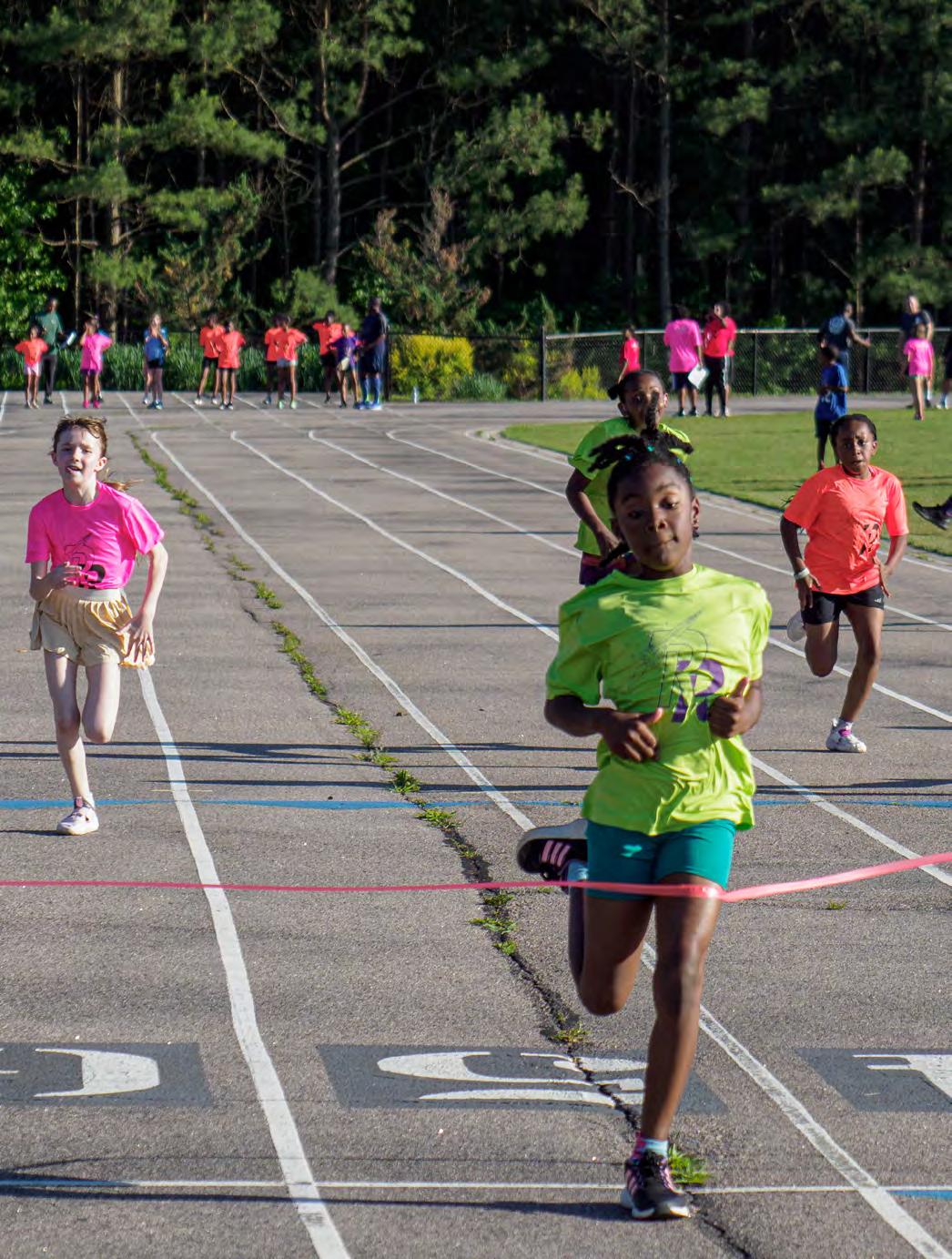
RALEIGH PARKS PLAN UPDATE PLAN SUMMARY
Why Does Raleigh Need a Parks Plan Update?
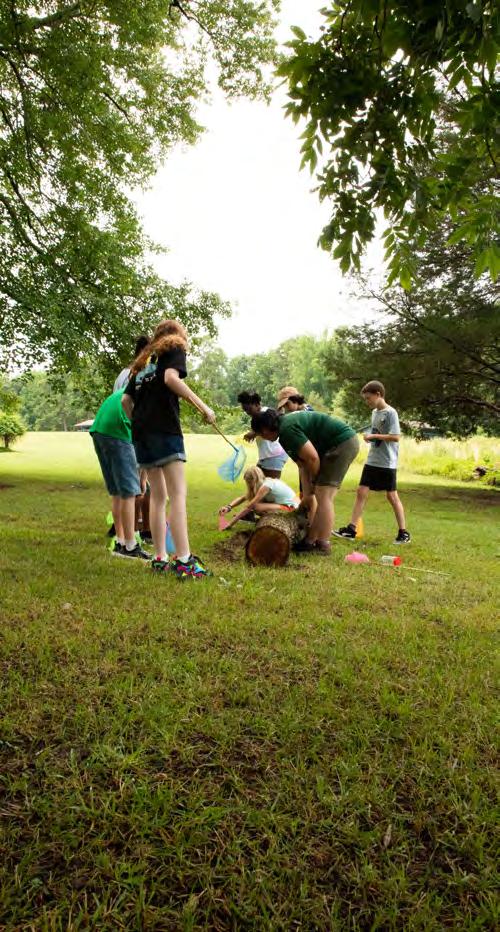
Raleigh is a city on the rise, and its parks, greenways, and cultural spaces must grow with it! This plan is a celebration of all that Raleigh Parks has achieved and a blueprint for an even brighter future. Over the past 10 years, Raleigh Parks has:
• Completed 91% of the 300+ action items established in the 2014 Parks System Plan.
• Expanded access to parks and places to play, especially in underserved areas.
• Grown the greenway network to protect natural resources and connect neighborhoods.
• Launched new programs for people of all ages and backgrounds.
Raleigh Parks has accomplished all of this even as the city continues to grow and welcome new residents. Raleigh is one of the fastest-growing cities in the country, and with that growth comes the need to ensure its parks continue to be vibrant, welcoming spaces for all. As the city continues to evolve, so must our approach to building and sustaining a world-class park system.

Planning Process
Over 16 months, starting in Spring 2023, the project team worked with the Raleigh community, staff, and partners to create a plan that reflects our shared vision for the future. The process had three key steps:
1. Listen and Learn: Gathered input from across the community.
2. Vision and Framework: Built a strong foundation for the goals.
3. Outcomes and Actions: Identified clear steps to achieve the vision.
This update isn’t just a refresh of the 2014 Parks System Plan—it affirms a commitment to equity, health, and inclusion in everything Raleigh Parks does!
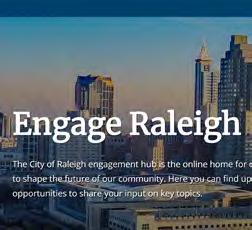
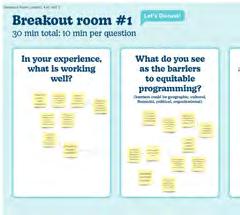
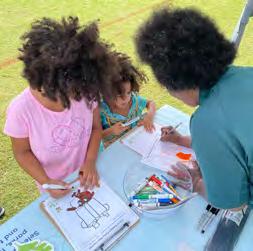
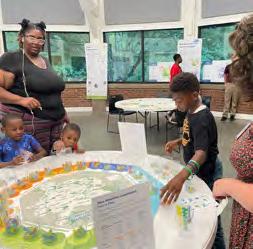
HOW DID ENGAGEMENT INFORM THIS PLAN?
During this process, there were three big ways that community and staff engagement shaped this plan:
#1 Community Values focused on Health!
People who participated in this plan process shared that they value “healthy lifestyles” most in their park system, which is why this plan is focused on improving health outcomes across Raleigh Parks.
#2 Raleigh Parks, the organization, needs to be healthy too!
Over half of the ideas for future projects, policies, and programs were to better support Raleigh Parks staff, who work to make everyone’s experiences so special.
#3 Places for nature need to be balanced with places for play!
In public workshops and in surveys, people said they wanted more ways to be in nature and to ‘walk or ride a bike’. ‘Places for open play’ was also identified as a top priority. There are many policies, projects, and projects that want to provide places for both to happen, while also ensuring people of all ages feel safe and welcomed in their parks.
The Raleigh Parks Plan: A Vision Through Four Heal
th
Lenses
VISION & PLAN STRUCTURE
The guiding vision of Raleigh Parks remains: “Bringing people to parks and parks to people.” This vision isn’t just about creating parks; it’s about creating connections—between people, nature, and the vibrant culture of Raleigh. The vision is supported by eight guiding principles.
HEALTH-FOCUSED FRAMEWORK
This plan is built around four key health lenses that reflect what the community values most in Raleigh’s parks. These lenses each represent a different perspective on the many ways that parks can improve the city, its communities, and everyone’s lives. Each lens includes several “outcomes”. These outcomes identify the desired result of the plan and its implementation.
PROJECTS, POLICIES, AND PROGRAMS
To guide implementation, each health lens has between nine and thirteen actions. These actions are organized into whether the action is a project (e.g., building a trail), policy (e.g., park facility reservation rules), or a program (e.g., expanding the number of in-park events).
Raleigh community and staff engagement
Nationwide best practices research
VISION
Bringing people to parks and parks to people.
EIGHT GUIDING PRINCIPLES
Connectivity and Access
Equity and Justice
Continuous Reinvestment
Collaboration and Coordination
Creativity and Innovation
Community and Belonging
Culture and History
Resilience and Stewardship
Check out how the vision and guiding principles relate to the health-focused framework and projects, policies and programs, above and on the next page.
HEALTH-FOCUSED FRAMEWORK
Four health lenses and fifteen health outcomes.
Individual Wellbeing
Physical Wellbeing
Access to play, exercise, and a healthy lifestyle
Mental Wellbeing
The ability to pursue emotional, psychological, and social wellbeing
Inclusion & Relevance
Reduced barriers and something for everybody
Belonging
A sense of community identity and belonging
Relationships
Strong relationships with communities
Development
Balanced growth and a robust local economy
Connectivity
Connections between people, places, and communities
Ecology
A sustainable, resilient, citywide ecological framework
Sites & Facilities
Best design, management, and operational practices in all sites and facilities
Stewardship
A community of active and passionate stewards
Protection
Sensitive habitats and corridors are protected
Support
Difference embraced and invested in, in all its forms
Cultivate
A workforce representative of the community
Innovate
A culture of innovation, creativity, and collaboration
Empower
A model parks and recreation agency committed to equity and effectiveness
Individual Wellbeing Park Experience
Raleigh-owned Parks
Other Open Space
Core Experience (10-min walk) Neighborhood Experience (5-min drive) Greenways

Individual Wellbeing
Parks are more than just physical spaces—they’re vital to our health and happiness! Access to the outdoors encourages physical activity, reduces chronic illness, and supports mental well-being. But it’s not enough just to have parks; we need to ensure everyone can enjoy them. That means breaking down barriers and welcoming everyone to the wide range of experiences Raleigh Parks offers.
The Individual Wellbeing lens includes three health outcomes: #1 #3 #2
PHYSICAL WELLBEING: Access to play, exercise, and a healthy lifestyle
MENTAL WELLBEING: The ability to pursue emotional, psychological, and social wellbeing
INCLUSION & RELEVANCE: Reduced barriers and something for everybody
Policies
Expand inclusive policies to support a full spectrum of users, including people who are neurodivergent, have visual impairments, physical disabilities, or language isolation.
Remove barriers for teen participation in programs and access to facilities.
Programs
Leverage partnerships and internal capacity to increase the number of free activities, programs, and events.
Strengthen Financial Assistance programs and funding to reduce barriers for households to participate in programs.
Identify mental health “hubs” - or distributed clusters of resources - throughout city, expanding the pilot mental health programming already provided at Dix Park.
Expand active adult program offerings and craft a marketing strategy to more effectively reach seniors who are unaware of program availability.
Expand drop-in and open play availability, especially for athletics or sports-related uses.
Create programs along greenway trails that better activate the greenway trails. Programs could include history, nature, or art-themed events that align with the Public Art Plan.
Projects
Inclusion & Relevance
Mental Wellbeing
Inclusion & Relevance
Inclusion & Relevance
Mental Wellbeing
Inclusion & Relevance
Physical Wellbeing
Physical Wellbeing
Expand shade citywide (trees/constructed shade) through the Street Tree Equity Project and through parks and facilities reinvestment projects. Mental Wellbeing
Expand offerings for wheeled resources for all ages. This could include all-ages recreation and education facilities like skate parks, Traffic Gardens, pump tracks, natural surface trails for mountain biking, and bike repair stations.
Strive for building amenities beyond ADA-accessibility and universal design.
Physical Wellbeing
Inclusion & Relevance
Community Cohesion Park Experience
Raleigh-owned Parks
Other Open Space
Core Experience (10-min walk)
Neighborhood Experience (5-min drive) Greenways

Community Cohesion
Raleigh’s parks are the heart of its neighborhoods, bringing people together and building strong communities. They reflect the unique character of each area while adapting to changes. Parks are where relationships are formed, cultures are celebrated, and communities grow stronger together.
The Community Cohesion lens includes four health outcomes: #1 #3 #2
BELONGING: A sense of community identity and belonging
RELATIONSHIPS: Strong relationships with communities
DEVELOPMENT: Balanced growth and a robust local economy
CONNECTIVITY: Connections between people, places, and communities #4
Action
Integrate arts and culture in projects and programs.
Revisit policies for volunteer work to strengthen and expand volunteerism and community park stewardship.
Partner across departments to identify and establish policies that incentivize the creation of publicly accessible parks and greenways as part of the land development process.
Programs
Partner to provide assistance to unhoused community members and persons experiencing mental health crises.
Translate Raleigh Planning Academy to a park-specific program that encourages community and department dialogue.
Expand community gardens, especially in neighborhoods with mixed use or high-density zoning or a food desert.
Expand the Welcome to Raleigh Parks program, providing a landing resource for newcomers to the city.
Provide revenue-generating services along greenways like food trucks and events that engage small and minority businesses.
Projects
Expand the Neighborhood & Community Connections Program through capital improvement as well as publicprivate partnerships.
Pilot marketing and communications programs with various workgroups to increase and inform relationships with the Raleigh community, especially those who do not participate in programs today.
Enhance design and programming to activate the greenway and ensure it is welcoming to all visitors.
Implement the next phases of the Dix Park Master Plan, and prioritize build-out of parks with multi-phase master plans.
Collaborate with other city departments and promote and incorporate greenway trails to support multimodal, active transportation.
Belonging
Relationships
Development
Relationships
Relationships
Belonging
Belonging
Development
Connectivity
Relationships
Connectivity
Development
Connectivity
Environmental Resilience Park Experience
Raleigh-owned Parks
Other Open Space
Core Experience (10-min walk)
Neighborhood Experience (5-min drive) Greenways
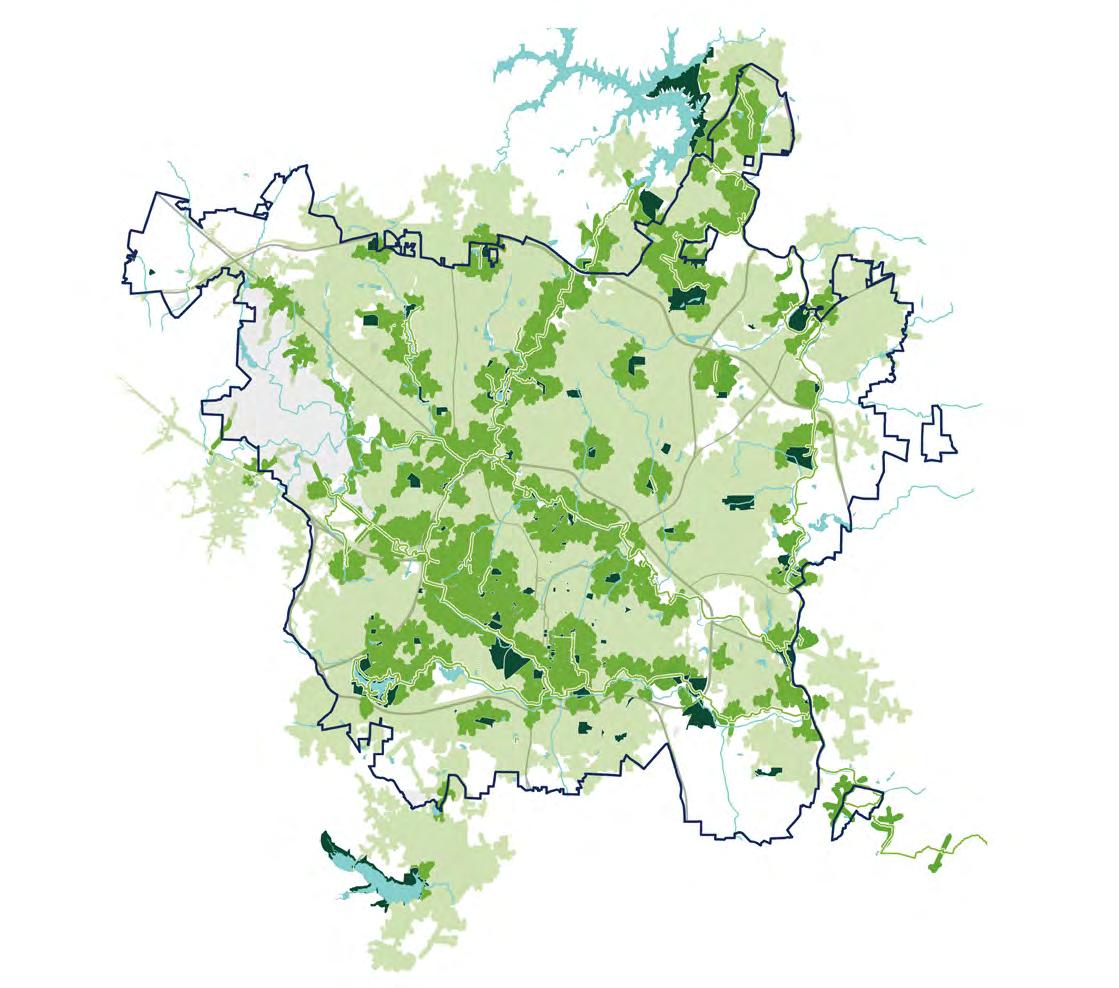
Environmental Resilience
Raleigh is a leader in environmental stewardship, and the park system is the backbone of the local ecosystem. The lands and waters Raleigh Parks manages are crucial in limiting flood risk, reducing temperatures, cleaning the air, and protecting wildlife. Parks and greenways are vital to the city’s resilience in the face of climate change and the biodiversity crisis, and Raleigh Parks is committed to preserving these natural spaces for future generations.
The Environmental Resilience lens includes four health outcomes:
#1
#3 #2
#4
ECOLOGY: A sustainable, resilient, citywide ecological framework
SITES & FACILITIES: Best design, management, and operational practices in all sites and facilities
STEWARDSHIP: A community of active and passionate stewards
PROTECTION: Sensitive habitats and corridors are protected
Action
Use existing standards or create a new Raleigh Parks green building standard for all capital improvement projects and develop guidelines for eco-friendly operations in all facilities.
Minimize environmental impacts, including to animal and plant habitats, for development and maintenance projects. Consider the tradeoffs to requiring the use of adaptive planting.
Increase use of Protected Natural Area designation (or create new designation/definition) to support consideration of sensitive species and habitats in planning and design.
Programs
Strengthen invasive species removal, especially in riparian corridors and in natural areas and parks with significant natural resources.
Expand environmental educational programs that provide climate change and sustainability curricula for youth and adults.
Projects
Expand natural areas and connected wildlife corridors through investments in existing Raleigh Parks properties, easements, and land acquisition opportunities.
Pilot green stormwater infrastructure (GSI) in parks with community centers and tie programming to those GSI investments.
Increase and actively steward Raleigh’s urban tree canopy through a combination of city-led efforts on public land as well as partnerships with community groups and private property owners.
Develop a City of Raleigh Natural Resources Strategic Plan that aligns with both the Comprehensive Plan and the Parks Plan Update and reflects external input.
Sites & Facilities
Sites & Facilities
Protection
Protection
Stewardship
Ecology
Sites & Facilities
Stewardship
Ecology

Organizational Commitment
To keep Raleigh Parks at the forefront, it must support and empower staff to be innovative, creative, and collaborative. Embracing diversity and fostering a culture of teamwork are key to Raleigh Parks’ success. By investing in its workforce, Raleigh Parks ensures that the parks system reflects and serves Raleigh’s diverse community effectively.
The Organizational Commitment lens includes four health outcomes:
SUPPORT: Difference embraced and invested in, in all of its forms
CULTIVATE: A workforce representative of the community
INNOVATE: A culture of innovation, creativity, and collaboration
EMPOWER: A model parks and recreation agency committed to equity and effectiveness
Prioritize existing operation and maintenance and Capital Improvement reinvestment.
Expand part-time employee inclusion through cross training, committee engagement, and initiatives.
Collaborate with staff to update the Department's values using the Parks Plan Update as a guide.
Update Raleigh Parks' code of ethics.
Programs
Create staff wellbeing programs for year-round support.
Expand sponsorship, partnership, and philanthropy opportunities, and fortify the department’s reputation so that Raleigh Parks is a partner of choice for external agencies.
Projects
Innovate
Cultivate
Support
Empower
Support
Empower
Achieve national accreditation (CAPRA) by upholding high standards in staff performance, customer service, and overall departmental excellence. Innovate
Implement the Raleigh Parks Programming Assessment. Empower
Develop a process for using data to drive equitable budgeting for capital investment in Raleigh parks. Innovate
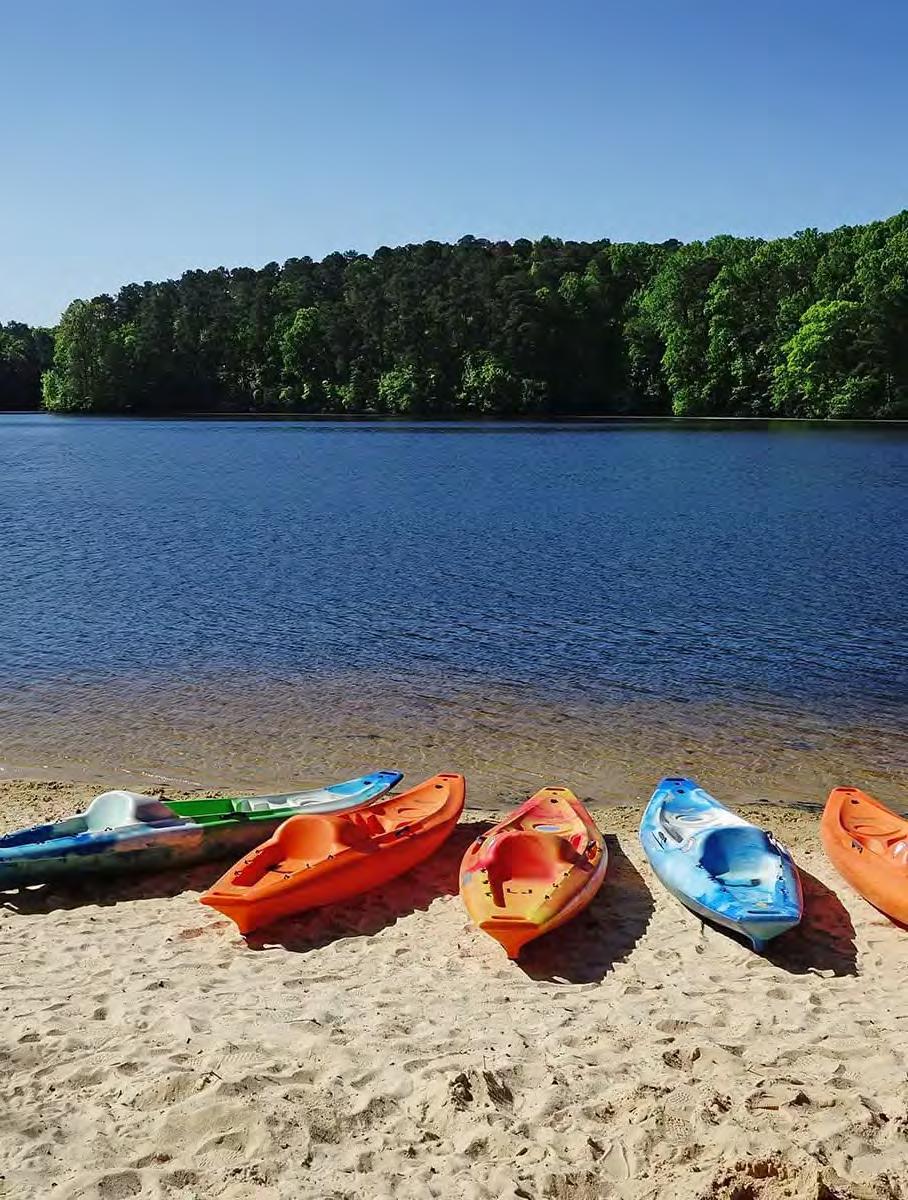
CHAPTER 1 INTRODUCTION
Plan Update Purpose
The Raleigh Parks, Recreation and Cultural Resources Department (Raleigh Parks) undertakes strategic planning on a consistent and ongoing basis for a number of reasons. These include aligning with citywide planning and vision, providing high-level direction to all aspects of the department’s delivery of services, understanding the community’s needs, and keeping ahead of broader local and national trends. Raleigh Parks mission, Together we connect and enrich our community through exceptional experiences, ensures the department’s priorities are met. Adopted in May 2014, the City of Raleigh Parks, Recreation and Cultural Resources System Plan, a companion to the City of Raleigh 2030 Comprehensive Plan, provided this roadmap for a twenty-year timeframe.
In Spring 2023, Raleigh Parks launched an equity-focused update to the 2014 Parks System Plan. This update is not intended to be a comprehensive revision of the 2014 Parks System Plan. Rather, the update focuses specifically on the evaluation of and recommendations for the following topics:
• Equity in the Park System - a focused understanding of how the department can prioritize equity to dismantle the policies and systems that have created and sustained
existing inequities. This update reassessed policies, priorities, and recreation programs through the lens of social, health, and racial equity.
• User Fee Policy Study - a strategic evaluation of Raleigh Parks’ User Fee Policy. This update includes a gap analysis, specifically addressing changes in community needs, priorities, and expectations since 2014.
• Level-of-Service Data Analysis and Modeling - an assessment of the Level-of-Service modeling, including recommendations for establishing goals and standards in keeping with nationwide best practices.
• Implementation Plan Update and Progress Report - a report that identifies achievements and progress of the original, 2014 Parks System Plan, while also significantly streamlining and enhancing future actions within an equity lens.
Focused on these topics, the plan set out to achieve an updated vision and roadmap to implementation that reflects the needs of Raleigh’s current system, while still holding true to the 2014 Parks System Plan’s guiding principles and Raleigh Parks’ vision of Bringing people to parks and parks to people
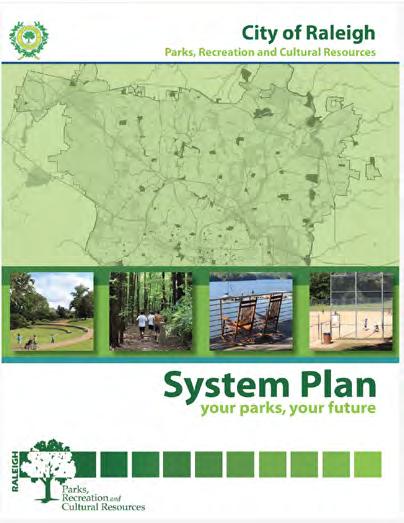
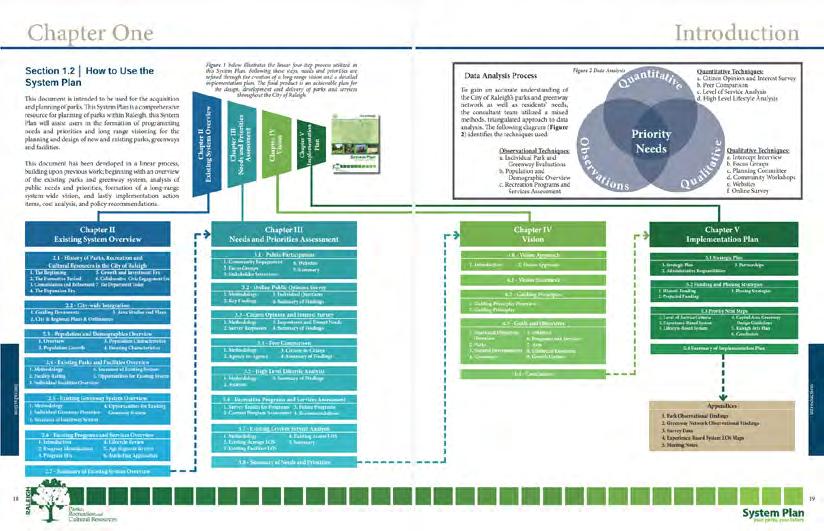
HOW HAVE THINGS CHANGED SINCE THE 2014 PLAN?
In the decade since the adoption of the 2014 Parks System Plan, many changes have made it necessary to update the plan. These changes have affected both Raleigh Parks and the entire city.
The City’s Strategic Plan helps guide the types of investments Raleigh Parks should make across the city. New projects, programs, and policies have come from the progress made since the 2014 Parks System Plan and Comprehensive Plan. The city has bought land for future parks and greenways, put together pre-development assessment plans (PDAP), and funded bond referendums. Many park and greenway projects
are at different stages of completion. The focus is improving or reinvesting in parks, greenways, and cultural facilities. The COVID-19 pandemic also showed how important the park system is. The Parks Department adapted quickly to provide more frontline services.
Outside of Raleigh Parks, new challenges have emerged in the last decade that require a closer look at current services. Safety and public health have become top priorities due to the impact of COVID-19. A better understanding of racial inequities, the need for social justice, and concerns about “green gentrification” present a chance to improve policies and build public trust.
Advances in other city departments, like transit and housing, create opportunities for Raleigh Parks to grow in the short and long term.
How to Use this Document
This update is a stand-alone document with no reference materials. It updates and works alongside the 2014 Parks System Plan, sharing important information from that plan. This update is meant to guide decisions for the next five to ten years.
Along with the introduction, the second and third chapters—Existing System Snapshot and Plan Process—explain the current state of Raleigh Parks and how this update was created.
The Vision chapter lays out a plan for the entire park system, focusing on health in four areas: physical, social, environmental, and organizational. This chapter also includes "deep dives," which are brief explanations of assessments or policies developed during this update. Here, you can see the outcomes Raleigh Parks wants to achieve.
The last chapter, Implementation Plan Update, explains how the changes will happen. It includes the policies, programs, and projects that align with the health goals in the Vision. This section also includes tools like the equity matrix and level-of-service modeling to make sure results are fair and equal across the city. You can find information on the short-term and long-term changes expected from this update here.
At the end of the document, the Glossary of Terms and Appendices provide presentations, community feedback, and more detailed information.
VISION
Bringing people to parks and parks to people.
EIGHT GUIDING PRINCIPLES
Connectivity and Access
Equity and Justice
Continuous Reinvestment
Collaboration and Coordination
Nationwide best practices research Engagement of the Raleigh community and staff Individual Wellbeing
Physical Wellbeing
Mental Wellbeing
Inclusion & Relevance
Projects, Policies, and Programs
Organized by Heath Lens and tagged to the outcomes they each support.
Creativity and Innovation
Community and Belonging
Culture and History
Resilience and Stewardship
HEALTH-FOCUSED FRAMEWORK
Four health lenses and fifteen health outcomes.
CONTEXT FOR RALEIGH PARKS:
CHAPTER 1
Introduction (Pgs.18-25)
Describes the structure of the plan, what informed the plan, and how it should be used.
CHAPTER 2
Existing System Snapshot (Pgs. 26-43)
Summarizes the current state of Raleigh Parks, the parks system, and the Raleigh community.
CHAPTER 3
Plan Process (Pgs. 44-71)
Outlines the steps taken and key findings used to inform the plan update’s creation.
CHAPTER 4
Outlines the process for enacting change, structured by the four health lenses and organized into priority policies, programs, and projects. WHAT RALEIGH PARKS AIMS TO ACHIEVE:
Vision + Health Outcomes (Pg. 72-129)
Defines the four health lenses and fifteen health outcomes that the plan should achieve over the next five to ten years, as guided by the Raleigh community, Raleigh Parks staff, the guiding principles, and the 2014 Parks System Plan vision.
CHAPTER 5
Implementation Plan Update (Pg. 130-149)
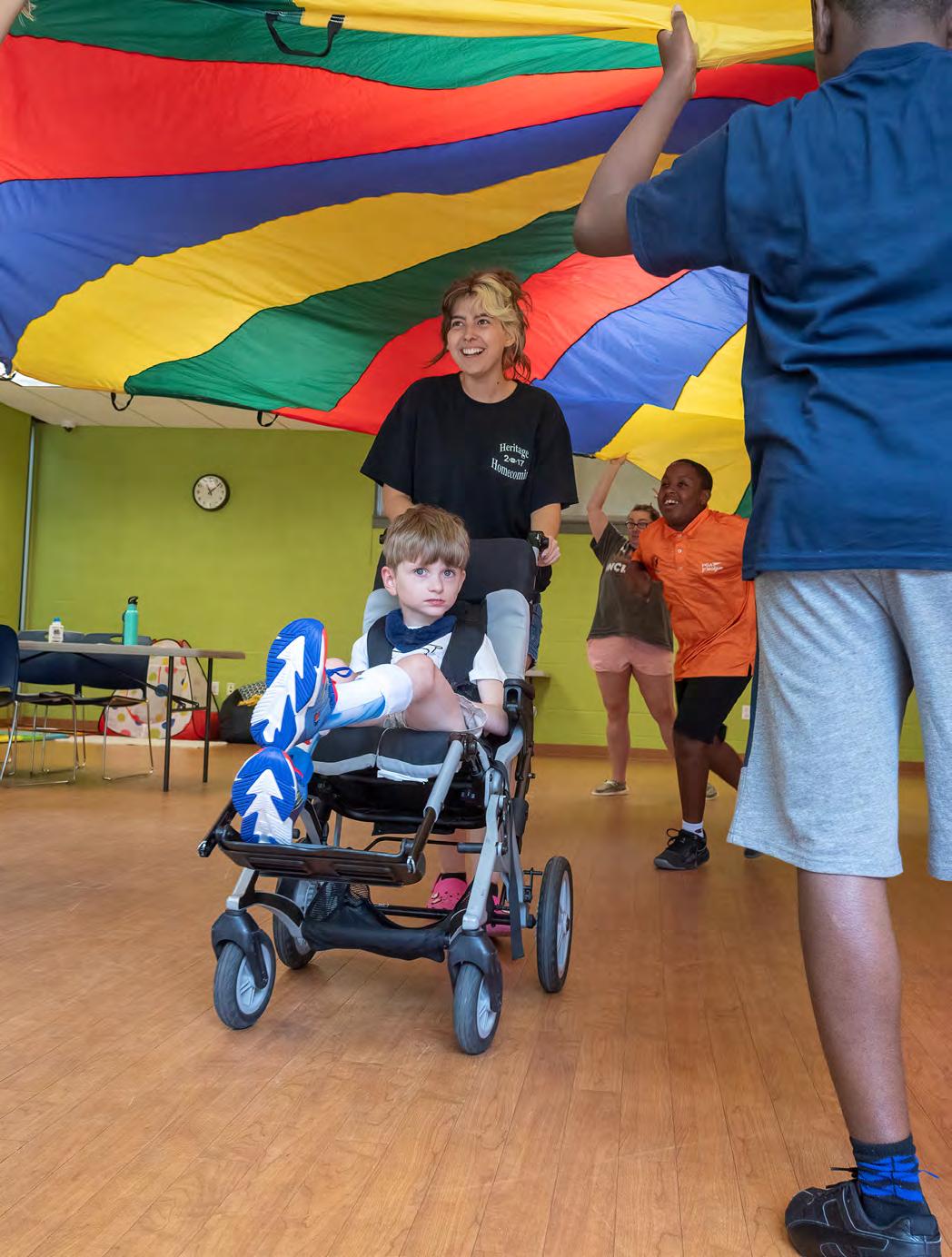
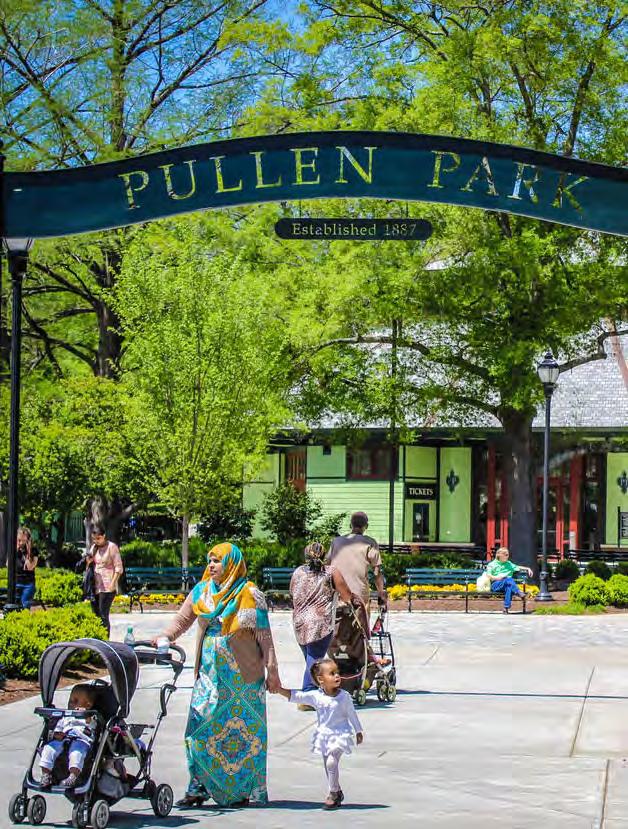
CHAPTER 2
EXISTING SYSTEM SNAPSHOT
Parks System Snapshot
This chapter summarizes Raleigh’s current park system, including what it offers and how well it meets the community’s needs. It looks at the park system’s history through an equity lens, provides a snapshot of Raleigh’s community today, and highlights the achievements of the 2014 Parks System Plan. This understanding of the past, present, and future is the foundation for updating the Parks Plan.
Raleigh has a large and complex park system, with 10,055 acres of parks, greenways, open spaces, and different facilities. Over the past ten years, the city has worked to improve park access, focusing on providing parks that offer a variety of experiences.
EQUITABLE ACCESS TO EXPERIENCES
There are over one hundred different types of park experiences that everyone can enjoy in Raleigh Parks. Of those experiences, Raleigh Parks currently considers four core experiences which include:
• Walking or Riding a Bike
• Open Play (sports, fields, etc.)
• Playgrounds
• Gathering or Community Spaces
Raleigh’s parks are designed to meet the community’s needs, making sure everyone has access to a variety of park experiences close to where they live. Some park activities, like walking or meeting up with friends, are considered “core” experiences. More specialized activities, like swimming in a public pool, going to a skate park, or visiting an art center, are considered “citywide” experiences.
What counts as a “reasonable distance” to a park depends on the neighborhood, how people get around, and whether they have families, are older, or have a disability. That’s why Raleigh uses national standards to set goals for park access. Since Raleigh was mostly built for people driving cars, it can be harder to walk, bike, or use
Parks and Open Space
Existing Raleigh Parks
Other Public Open Space
Future Raleigh Parks Greenway Trails
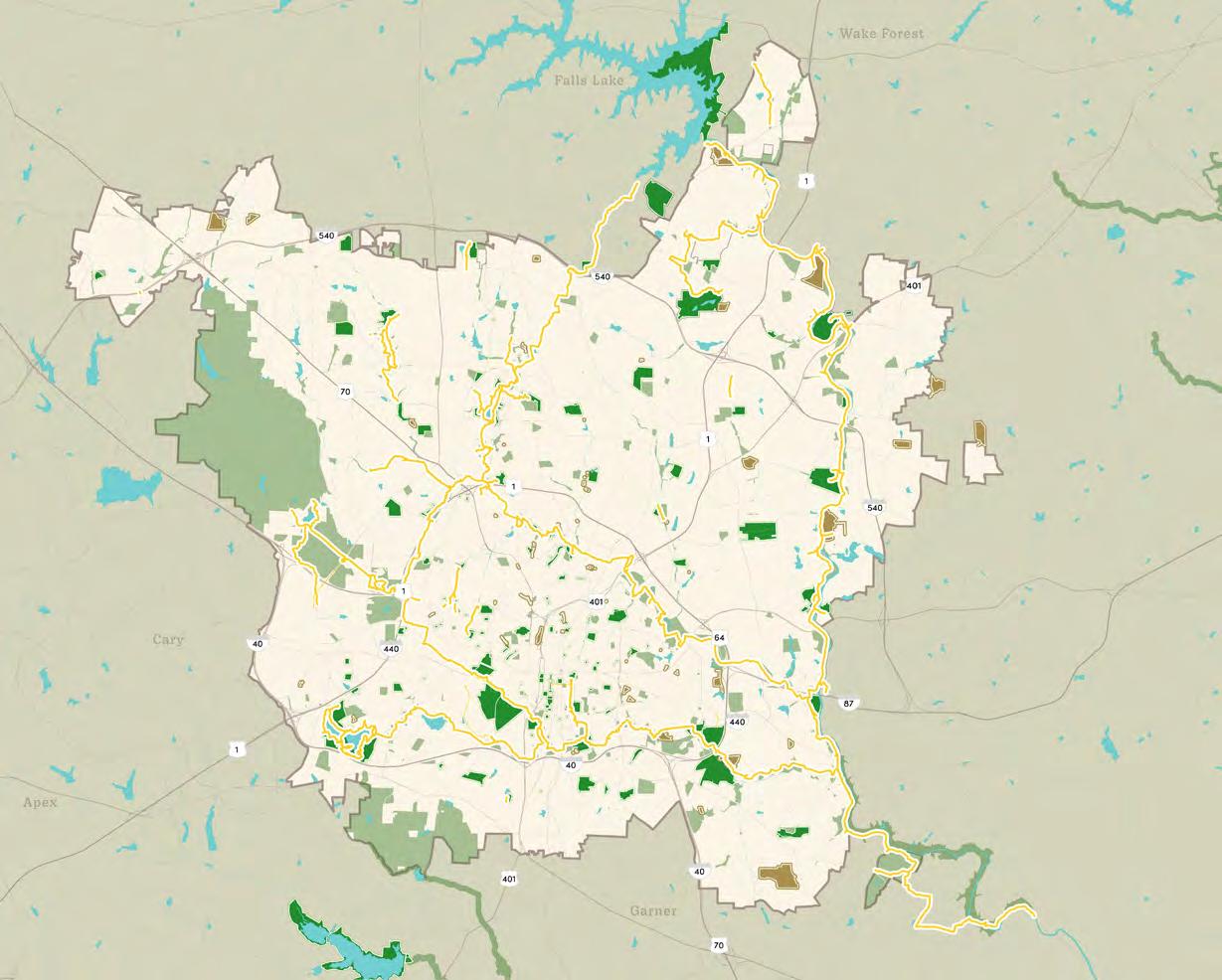
transit to get to parks. The goal is for core park experiences to be within a half-mile, or a tenminute walk, of home. For citywide experiences, the distance can vary depending on what the park offers. For example, a 2018 study set a goal for dog parks to be within a ten-minute drive. In Chapter 5, the Reshaping Equitable Access section has more information on how Raleigh Parks is evaluating access to park experiences and improving ten-minute walking access to parks and greenways.
Raleigh’s park system is flexible, so it can change as the community’s needs change. In the past ten years, people spent more time indoors, which has led to physical and mental health challenges. During the COVID-19 pandemic, there was a huge increase in people using
greenways and programs to support health and wellness. Surveys and community feedback during the Parks Plan Update highlighted the importance of health and wellness programs. A majority of residents selected “Health and Wellness” as the most important value they would like to see drive future decision making. In response to these demands, Raleigh Parks has increased its Health and Wellness programs, and they are consistently the program category with the highest enrollment.1
As Raleigh Parks plans for the next five to ten years, changing community trends will shape park designs, the types of programs and activities offered, and the policies that are created.
1 Raleigh Parks Recreation Program Plan, 2024.
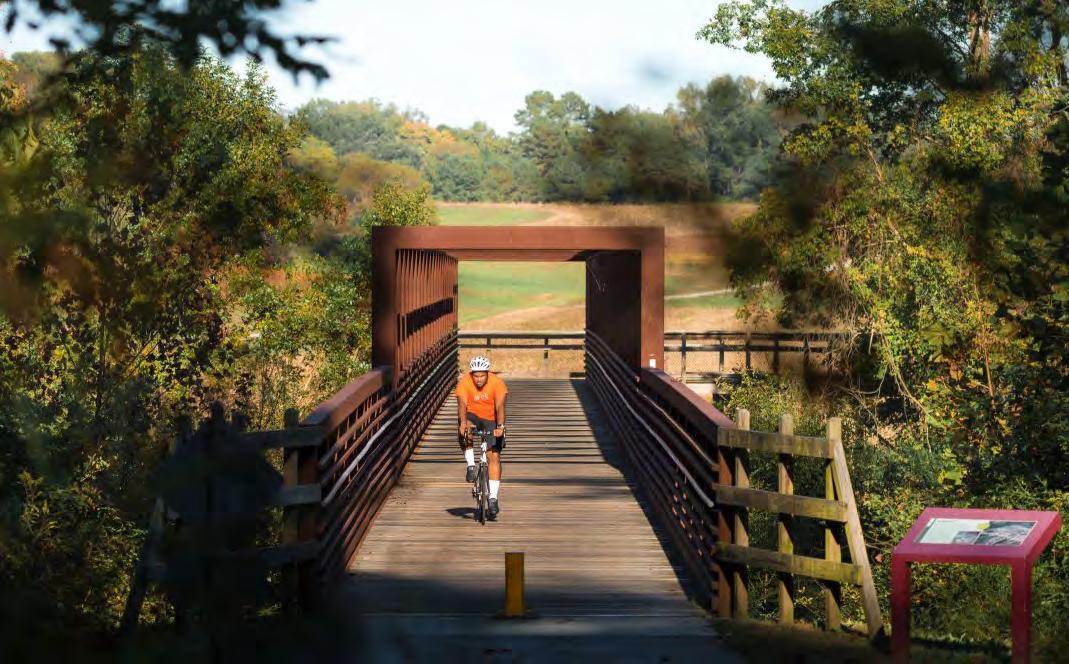
WHAT DOES RALEIGH PARKS OFFER?
Raleigh Parks offers hundreds of programs for all interests, ages, and abilities. Striving to be able to offer something for everyone, it regularly adapts programs to meet changing community needs. The programs that are offered make up some of the following categories:
• Active Adults
• Aquatics
• Arts
• Before and After School Care
• Camps/Summer Camps
• Cultural Events
• Cultural Outreach and Enrichment
• Dance
• Early Childhood
• English Language
• E-sports
• Fitness
• Gardening
• Gymnastics & Cheer
• Healthy Lifestyle
• Historic Resources and Museums
• Martial Arts/Self Defense
• Music Lessons
• Nature/Environmental Education
• Nutrition
• Outdoor Recreation
• Physical Activity
• Specialized Recreation
• Sports (Baseball, Basketball, Boxing, Cricket, Pickleball, Rip-a-Flag Rugby, Soccer, Tennis, Volleyball, etc.)
• STEM/STEAM (Science, Technology, Engineering, Math + Art)
• Wellness
Raleigh residents value the city’s recreation programs and activities. Arts courses and events are in high demand. New programs, including expanded arts options in Spanish, aim to meet this growing interest. Nature-based education and outdoor recreation programs are also popular with residents and visitors. Like many places across the country, the demand for outdoor activities in Raleigh has risen since the COVID-19 pandemic.
Raleigh Parks works to make its programs accessible to everyone. The Play It Forward program offers financial assistance to those who need it. Specialized Recreation and Inclusion Services (SRIS) provides programs for individuals with developmental or physical disabilities. Programs like Give Play, supported by the City of Oaks Foundation, help lower the cost of nature camps for youth. This makes sure everyone has the chance to participate. These programs help remove financial barriers and make it easier for under-resourced community members to stay active and healthy.


REVISITING RALEIGH’S PARK HISTORY
COMMON NARRATIVES
1792
Raleigh established on 1,000 acres acquired from Joel Lane. The original city plan included five public squares, including Moore and Nash Squares, as well as the street grid still recognized in downtown Raleigh today.
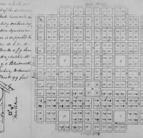
1840
The 2014 Parks System Plan highlights how parks have played a key role in Raleigh’s history and identity. The plan outlines Raleigh’s park history, showcasing milestones and achievements across five eras of development. Raleigh Parks continues to use parks to share historic resources, driven by the community’s desire to celebrate the city’s unique history. During the Parks Plan Update process, community members ranked “Culture & History” as one of their top values.
Work is completed on the Raleigh and Gaston Railroad, bringing a new decade of growth and development.
1887 Land was transferred to the City of Raleigh to establish Pullen Park, North Carolina’s first public park.
Early 1900s
As seen nationally, parks in Raleigh become places of relief from city life, with a focus on leisure and recreation.
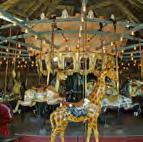
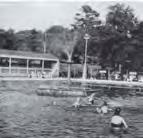
1959
Raleigh’s Research Triangle Park is founded, set to become a model for research, innovation, and economic development in North Carolina.
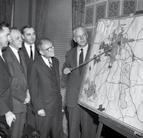
Native settlement
Raleigh is home to several native communities and is located on the border of Tuscarora and Siouan territory.
1798
City Cemetery develops on four acres with graves segregated for Black and white residents.
LESSER KNOWN HISTORIES
Early 1800s
Moses Mordecai marries into the Lane family and acquires the 1785 home known today as the Mordecai House (now Mordecai Historic Park). Between 1820 and 1860, the Mordecai property grew, eventually becoming a sprawling plantation. Over time, more than 200 enslaved African Americans lived and labored on the land.
1865
The first Historically Black College in the South, Shaw University, is founded.
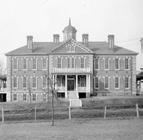
1.1 Timeline of common and lesser known histories of Raleigh’s Parks System.
1930s
Raleigh creates a separate Black Parks department prior to the opening of a “separate but equal” designated park for African Americans, John Chavis Memorial Park
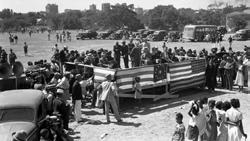
1950s
Raleigh adds five white-only parks, totaling 100 acres, and one Blackonly park, totaling 7 acres. At this point, 93% of parks in Raleigh exist in white and affluent areas.
1969
To honor these priorities, Raleigh’s Historic Resources and Museum Program team spotlighted many lesser-known stories from the city’s park history for the Parks Plan Update. The two timelines below show how these stories have shaped Raleigh’s parks. One timeline highlights
Raleigh publishes its open space plan for the coming decade, called “Raleigh, The Park With a City In It,” as Raleigh begins its greatest period of park development.

Maps courtesy of the 1968 Capital City Greenway report
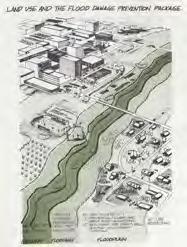
2004 Raleigh publishes its Parks and Recreation Plan, which establishes new goals for the Park and Recreation Department.
well-known events, like the creation of the Pullen Park Carousel and the Raleigh Rose Garden. The other timeline reveals lesser-known stories, such as the city’s thirty-year history of racially segregated parks.
2009
The City of Raleigh adopts its 2030 Comprehensive Plan, providing guidance for the city’s services and development over the next two decades.
2012 City Council adopts Raleigh’s Comprehensive Public Participation and Park Master Planning Program.
2014
Raleigh Parks completes its Parks System Plan, serving as a guide for future parks, facilities, and programs.
2015 Dorothea Dix Park opens to the public!
1961 John Winters becomes the first African American to serve on City Council.
1969
Raleigh integrates the white and Black park systems.
Late 1970s
Raleigh begins a study of the park system, making reinvestment in South and East Raleigh a priority, with the goal of providing parks “within a service radius of one mile” from residents.
1980s
Despite progressive goals, 17 of the 38 new parks (821 acres) exist in neighborhoods with the highest income.
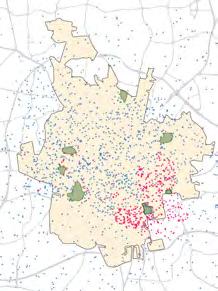
2000s
For the first time in the city’s history, Raleigh’s lowest income residents gain access to parks in line with national standards, gaining 393 acres of new park land.
TODAY!
Currently there are 10,055 acres of parks and open space in Raleigh’s park system. As work is undertaken to update the Parks System Plan, it becomes even more important to strive for equitable planning that serves all Raleigh residents.
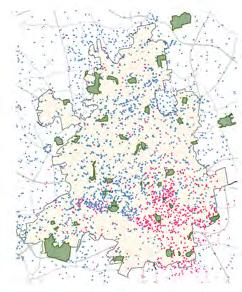
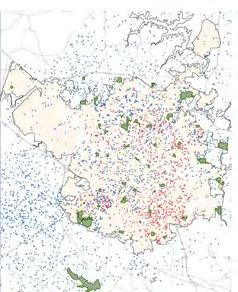
Community Snapshot
In the last decade since the 2014 Parks System Plan, Raleigh Parks responded to a series of unanticipated local and national changes. The COVID-19 pandemic, in particular, dramatically impacted the ways in which communities interact with the outdoors, commute in cities, and use city services. The City experienced a significant rise in the number of employees working from home, with recent estimates from the American Community Survey showing a 380% increase in the number of remote workers within Raleigh since 2012.2
As Raleigh continues to become more dense, more people are choosing to live alone in smaller homes or apartments that might lack backyards or green spaces. Many people are delaying having children or choosing not to have children, as seen by the number of children under ten in the city dropping in the last ten years.3 The number of residents over the age of 65 is also growing, reflecting a national trend in the population. The United States is aging, with the number of people aged 65 and older growing almost five times faster than that of the total population.4
Both Raleigh and North Carolina also continue to welcome many newcomers, including continued growth in individuals with limited English proficiency (LEP) immigrating to the United States from other countries. Of the total number
of immigrants currently living in the state, about 31% of immigrants arrived to North Carolina after 2009. About half of the foreign-born population living in the state are from Latin America, such as Mexico and Honduras. Another 28% are from Asia, such as South Korea and China.5
Over 37,000 new people have moved to Raleigh since 2012,6 and it is projected that Raleigh’s population will continue to boom over the coming years. This number includes the tens of thousands of new students arriving each year, given Raleigh’s ten colleges and universities. The Raleigh metro area population is projected to grow almost 80% percent by 2060, making it the eleventh fastest growing of all 384 U.S. metro areas.7 This continued growth further reinforces Raleigh Parks’ role within the larger city. More than ever, a high-quality parks system driven by equity and dedicated to providing exceptional service is a key indicator of overall city health.
Raleigh Parks continues to incorporate trends in community demographics and preferences in future investments in the types of programs, parks and community facilities, and cultural and natural resources offered.
2 American Community Survey 2012-2022
3 US Census, 2020
4 Economic Innovation Group, 2024
5 North Carolina Office of State Budget and Management
6 American Community Survey 2012-2022
7 “Raleigh, NC Will be Among the Fastest Growing Cities by 2060”, 24/7 Wall St, 2022.
Recent Development
Built 2010-2020
Built since 2020
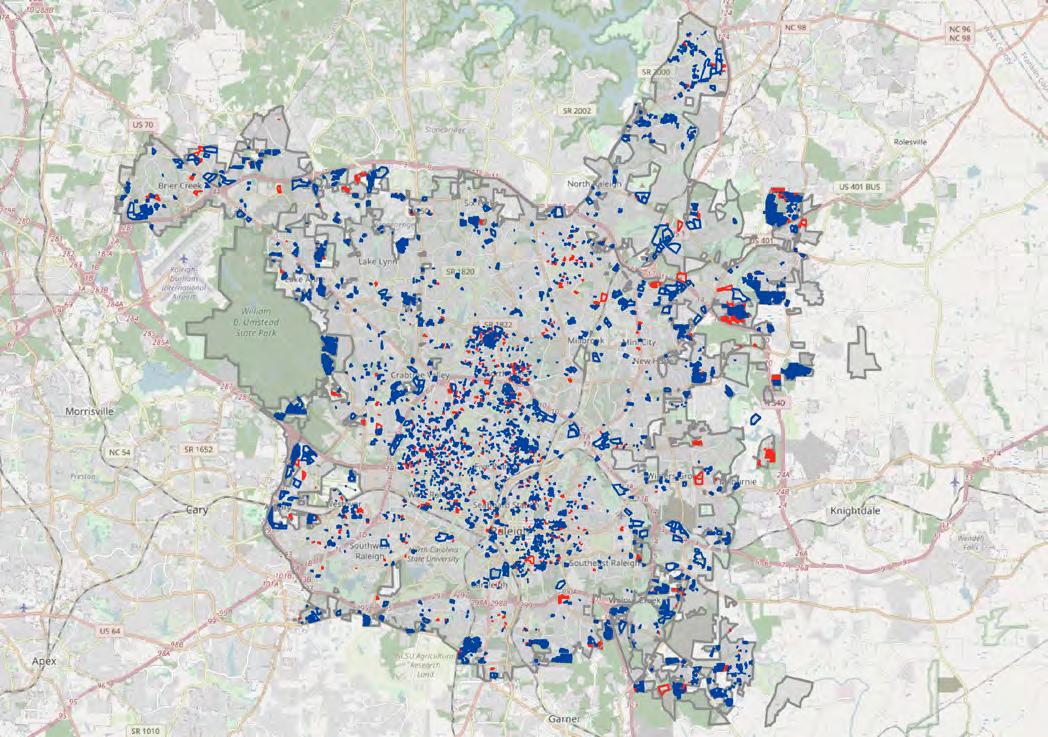
Raleigh’s Hispanic population more than tripled between 2000 and 2022, and its Asian population more than quadrupled.
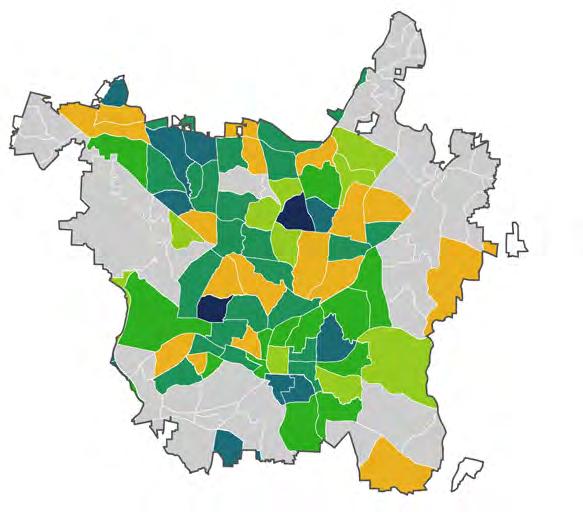
Total Population Percent Change from 2011-2021 (ACS 5-yr estimates)
< -40%
-20% to -40%
-20% to 0%
0% to 20%
20% to 40%
> 40%
Insufficient data
MODELING PARKS SUPPLY
Raleigh’s Park System is based around a range of core and citywide experiences, which allows the City to be flexible and provide better service to the community. Raleigh Parks’ mission, Together we connect and enrich our community through exceptional experiences, reinforces how valuable a range of positive, accessible experiences is to the department and the community. Core experiences are used to measure how well the City is meeting its 10-Minute Walk® goal. Raleigh Parks has organized over one hundred types of experiences into four core experiences, but not all experiences fit within these categories. Part of this plan is including a fifth core experience focused on nature-based amenities and spaces. This model evaluates where various park experiences are in relationship to Raleigh residents and where there are gaps within communities to allocate investments that will bring these experiences to the people and neighborhoods that need them the most (as identified in the equity matrix). Through this process, the four original park experiences were expanded to respond to community desires for a greater connection to nature. The five core experiences are:
Walking or Riding a Bike: The types of amenities that are found in Raleigh parks and greenways that provide this experience include hiking trails, walking paths, and greenway trails.
Open Play: Amenities found in open play spaces include sports fields and unprogrammed lawn spaces.
Playgrounds: Play spaces that range in age and ability - from nature play to traditional play areas.
Gathering or Community Spaces: Parks that include pavilions and picnic tables that can support groups large and small fall within this category.
Nature Spaces: The newest core experience, evolved out of the Parks Plan Update, which includes trails, forested areas, and riparian corridors.
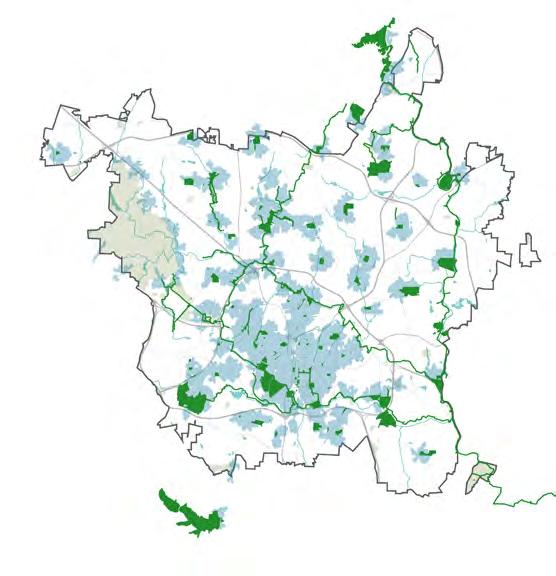
Gathering Space Experiences
Raleigh Park Greenway Ten-Minute Walk
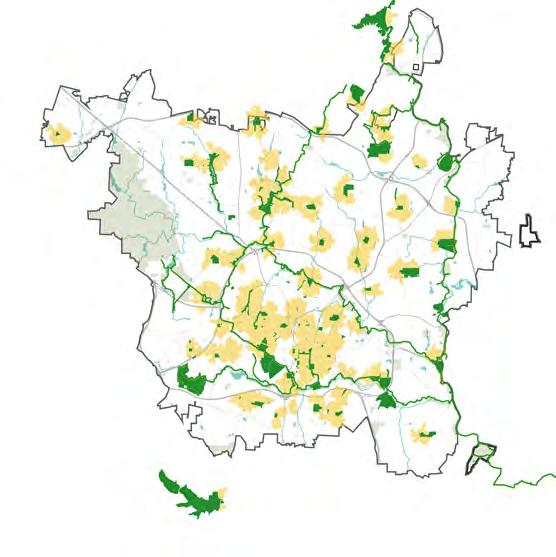
Playground Experiences
Raleigh Park Greenway Ten-Minute Walk
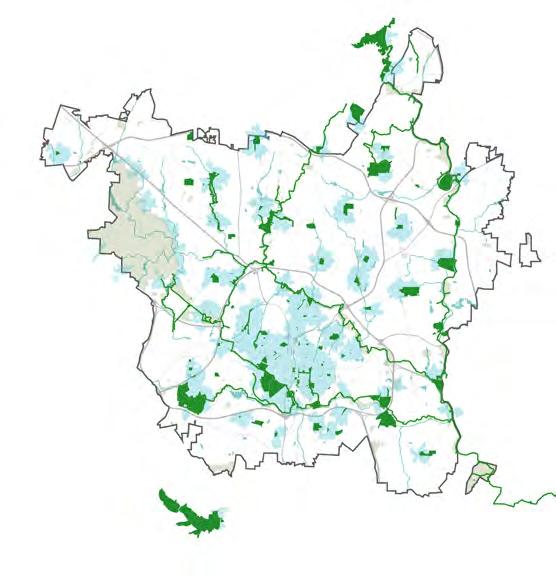
Open Play Experiences
Raleigh Park Greenway
Ten-Minute Walk

Nature-Based Experiences
Raleigh Park Greenway
Ten Minute Walk
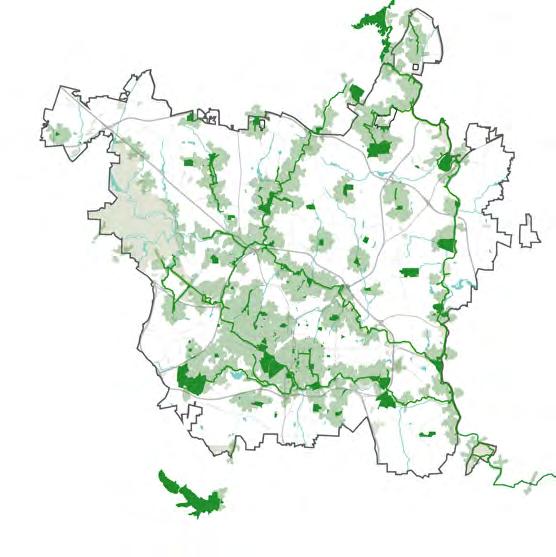
Walk and Bike Experiences
Raleigh Park Greenway
Ten-Minute Walk from Park or Greenway
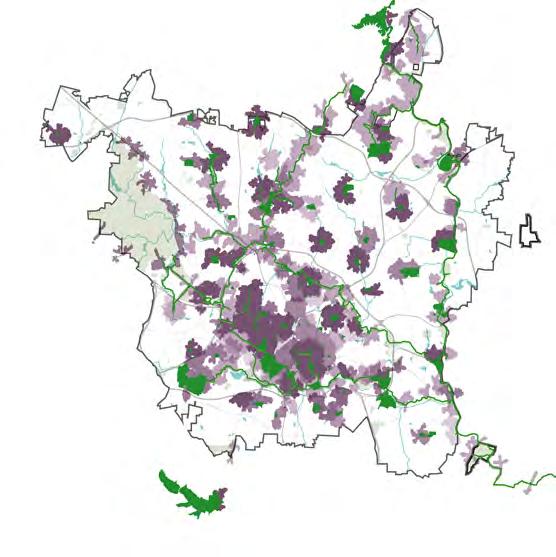
Variety of Core Experiences
Access to Less Experiences
Access to More Experiences
Raleigh Park Greenway
What has been achieved since 2014?
The 2014 Parks System Plan has guided numerous projects and has elevated the role of parks, recreation programs, and facilities in enhancing the city’s quality of life. Raleigh’s population is growing and becoming more diverse, changing how people use parks, greenways, and facilities. Raleigh Parks is adapting to these needs while staying committed to its mission and the 2014 Parks System Plan. Selected examples of those accomplishments are summarized here, organized by the 2014 Parks System Plan subsystem chapters:
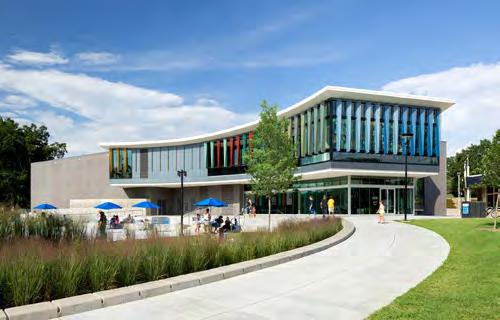
Parks
The 2014 Parks System Plan was completed alongside the approval of the 2014 bond referendum for parks projects, totaling $91.8 million. In 2022, Raleigh voters approved a $275 million bond referendum. The referendums were a public vote to authorize Raleigh Parks to issue bonds to finance specific park projects and initiatives. The Parks Bonds include projects that continue to provide the community with healthy park and recreation options for everyone to enjoy. The projects included as part of the 2022 bond referendum focus on heightened community priorities that have emerged as a result of the City’s focus on equity and the impacts of the COVID-19 pandemic.
In 2014, John Chavis Memorial Park completed a revised master plan. The Phase 1 implementation of the adopted master plan resulted in renovations to the park grounds and facilities, including a new 41,600-square-foot community center, splash pad, and playground. The 2022 bond referendum allocated funds to complete the implementation of Phase 2 of the adopted master plan, including a new aquatic center, Heritage Plaza improvement, expanded historic interpretive displays, and associated parking and stormwater investments.
Natural Environments
Planning and capital investments supported peak attendance to Raleigh’s three nature preserves, with over 243,000 visitors between 2020 and 2021. Programming has increased in response to increased interest in Raleigh’s natural environment, sustainability, and climate resilience.
Raleigh Parks continues to expand public access to natural spaces and environmental education with the implementation of natural resource management plans, the opening of Horseshoe Farm Nature Preserve and the Annie Louise Wilkerson, MD Education Center in 2015, and investments beyond its nature parks and preserves, like those in Lake Johnson’s Thomas G. Crowder Woodland Center in 2016 and Forest Ridge Park in 2017.

Athletics
Measures to improve parks and make them safer and more accessible have enabled the growth and enhancement of the City’s athletics programs and facility offerings.
Raleigh Parks was awarded the ‘Better Sports for Kids Quality Program Provider’ designation in 2018-2021, exceeding national standards for safety, quality, and evaluation in youth sports leagues.
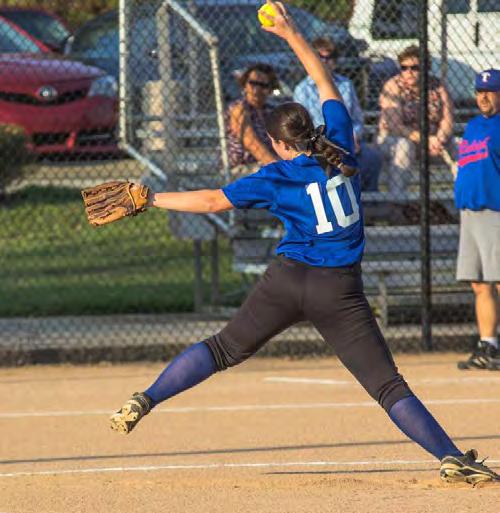
Greenways
Raleigh’s extensive greenway system has continued to expand since the 2014 Parks System Plan with the help of the Capital Area Greenway (CAG) Master Plan, originally created in 1976 and most recently updated in 2022.
Completed in 2024, the Crabtree Creek West Trail Extension is the final piece of a continuous 14.6 mile trail that stretches across Raleigh, from Umstead State Park to the Neuse River Trail.
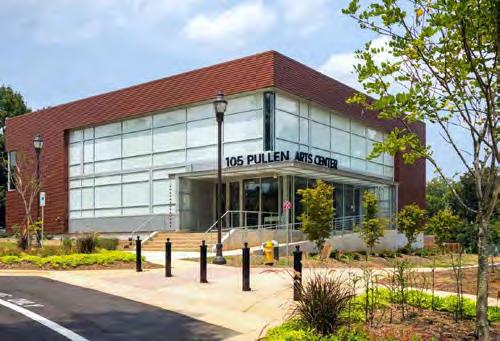
Programs & Services
Since 2014, the City’s allocation of programs, services, and events has adapted to meet the changing needs of residents and broader trends in recreation. Since 2014, Raleigh Parks has expanded programs that support more adult programming, senior activities, and general youth programs.
Beyond regular programming, the City has created various ways to connect Raleigh residents and visitors to relevant cultural trends and meaningful storytelling, with events like the Dreamville Festival and the Dix Park Inter-Tribal Pow Wow.
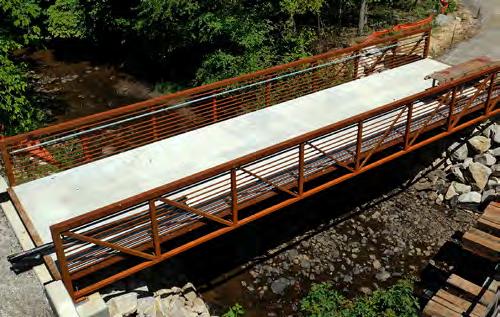
Arts
Many actions within the 2014 Parks System Plan identified strategic planning efforts that will enable the implementation of other longer term investments. The Raleigh Arts Plan and the Public Art Plan, completed in 2016 and 2022 respectively, identified gaps in storytelling, investment, and communications. These plans provided a roadmap to bolster investments in the arts citywide.
In 2016, the Raleigh City Council increased the Percent for Art program’s allocation from 0.5% to 1% of municipal construction funds for public art. Finally, in 2021, with the guidance of the Raleigh Arts Plan, the Pullen Arts Center re-opened. The Pullen Arts Center focuses on visual arts education and events, as well as classes in pottery, bookmaking, printmaking, painting, drawing, jewelry making, and more.
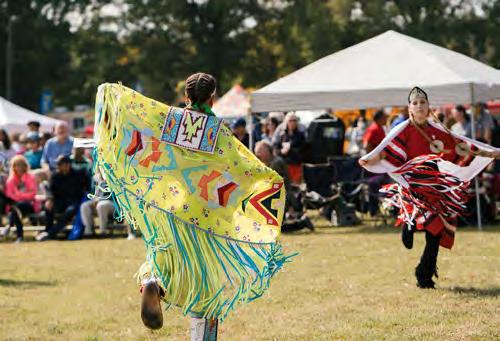
Historic Resources
In 2012, the City of Raleigh created the Historical Resources and Museum Program (HRM) to protect historic spaces and stories and to share them with the broader Raleigh community. The 2014 Parks System Plan signaled its inclusion in the long-term trajectory of the department and included recommendations which would enable the HRM team to achieve their goals. In 2018, HRM completed their own strategic plan to evaluate the operations and management of the program and make recommendations to strengthen the mission of the HRM Program and respond to the needs of the community.
Raleigh has digitized and published online the Historic Resources and Museums artifact collection. Through 2024, almost 30,000 objects are now published online! Many of Raleigh’s museum exhibits and educational programs are now hosted on the City’s website, making history more accessible for residents and visitors.
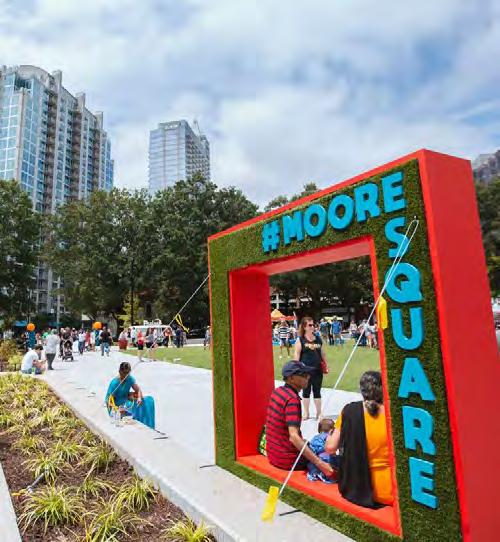
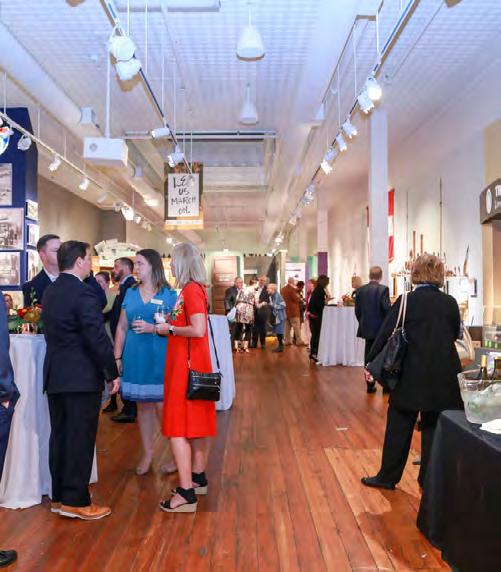
Growth Centers
In 2014, Raleigh was quickly growing, and ten years later, that trend has not changed. In alignment with the Comprehensive Plan, Raleigh Parks identified areas projected for growth as places to prioritize for future land acquisition, park reinvestment, and allocation of new park experiences. As Raleigh continues to grow and urbanize, this subsystem reinforced that parks and recreation facilities are an essential piece of the puzzle.
The redesign of Moore Square, completed in 2019, has helped catalyze new development in Raleigh’s historic downtown core. Projects like Fisher Street Park, completed in 2022, provide world-class park spaces alongside affordable housing in neighborhoods like East College Park.
ACTION PROGRESS FROM THE 2014 PLAN
The 2014 Parks System Plan established eight subsystems that cover the breadth of resources, facilities, and programs managed by Raleigh Parks. There were many successes in the implementation of this plan - notably, its clear structure which allowed each of the eight areas to be evaluated individually and for progress to be tracked consistently over the past ten years.
Raleigh Parks also accomplished many noteworthy actions that were not identified by the 2014 Parks System Plan. Notable achievements not included in the 2014 Parks System Plan include the Green Stormwater Infrastructure (GSI) Policy and Monitoring Pilot Program, which tracks the progress of Raleigh’s GSI projects. The Neighborhood and Community Connections (N&CC) Program was also introduced to identify and prioritize new walkable routes to parks and greenways. Additionally, the Penny Tax, a one-cent property tax increase, was implemented to support park system maintenance, among other initiatives.
In March 2024, Raleigh Parks met with staff representing each of the subsystems in order to confirm progress on the 2014 Parks System Plan’s action items. Staff identified completion status and top priority action items to consider in the Parks Plan Update. Based on this progress, the following takeaways emerged:
1. Nearly all top priority action items can be accomplished inside of the organization (seventy internally to Raleigh Parks, fifteen inter-departmentally).
2. Studies, plans, or assessments still make up the largest portion of top priority actions, at thirty percent of all actions.
3. Of all top priority action items, 79% are high or medium equity impact, and 75%of these
items are short-term actions that can be accomplished in the next five years.
4. Half of all top priority actions support the area focused on programs and services.
5. There is not currently a method within the 2014 Parks System Plan to capture actions taken that were not originally identified by the plan.
For more details about progress in the 2014 Parks System Plan actions, visit Appendix A.
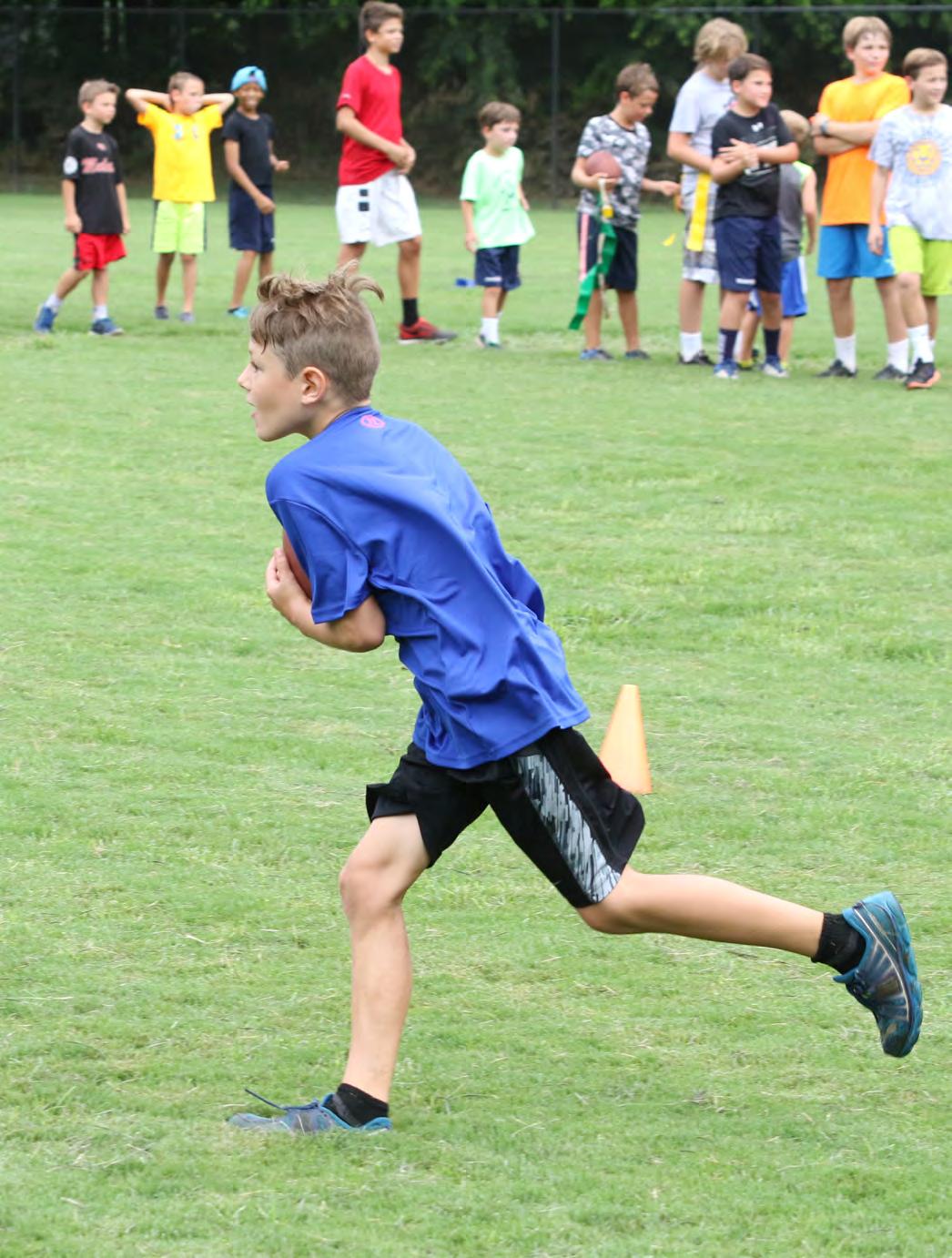
CHAPTER 3 PLAN PROCESS
Planning Process
The Parks Plan Update kicked off in April of 2023 as a sixteen-month process to plan for the next five to ten years of Raleigh Parks. The process was organized into three phases and set out to accomplish the following:
• Craft and deploy equitable public and stakeholder engagement
• Encourage broad collaboration with City leadership and staff
• Evaluate park access and share best practices focused on equitable outcomes
• Study and update user fees and policies
• Assess recreation programming
• Move from plan to action with an implementation plan update
• Share an update on the status of the 2014 Parks System Plan’s action items
The first phase of the planning process, Listen & Learn, focused on understanding the Raleigh Parks system and learning from staff about their experiences with existing policies, projects,
programs, and the system in general. The second phase, Vision & Framework, focused primarily on creating a shared vision and an updated plan framework focused through a health equity perspective. The third phase, Outcomes & Actions, outlined specific outcomes and actions that Raleigh Parks could work toward to achieve that shared vision grounded in health equity.
Throughout the Parks Plan Update process, Raleigh Parks staff and leadership played an important role. This involvement included sharing experiences of the system at the beginning of the project, many workshops with leadership that advanced plan milestones, staff-led actions progress meetings, and engagement pop-ups. It also included time spent actively building out future projects, policies, and programs to take on within the implementation plan. Raleigh Parks helped to create a plan that reflects this inclusion and input and will be critical to guiding the next five to ten years of parks, recreation, and programming that will benefit the city as a whole.
PHASE 1: LISTEN & LEARN
The Parks Plan Update was created as a team effort that involved Raleigh Parks leadership, staff, the Parks, Recreation, and Greenways Advisory Board (PRGAB), and the Raleigh community. Throughout the process, key meetings were held to move the plan forward, along with important opportunities for community input. In Phase 1, the focus was on gathering data from both local and national sources and looking at the current condition of the parks system.
Task 1: Equity in the Park System
The Parks Plan Update took a close look at Raleigh’s park system, focusing on fairness and equitable access for everyone. The team reviewed older plans and used this information to create new goals and guiding principles based on current community needs and
national trends. They studied a wide range of documents, policies, GIS data, and past research to understand the parks, recreation centers, and cultural resources in Raleigh.
The team combined goals from earlier plans and identified gaps on where more data was needed. They updated the Parks System Plan by including city policies adopted since 2014. The current state of Raleigh’s parks system was evaluated, and best practices for the Commission for Accreditation of Park and Recreation Agencies (CAPRA) accreditation were identified.
In this task, the team created an online interactive timeline using a program called ArcGIS StoryMap. This timeline shares the park system’s history more broadly than in past plans. This analysis highlighted ongoing efforts to address where access was lowest, forming the basis for recommendations to enhance equity. For more information about equity in the park system, head to the Equity-Centered Process section, on Page 62 of Chapter 3.

Task 2: Public and Stakeholder Engagement
At the start of the process, the Parks Plan Update looked at how Raleigh was already engaging with the community. Then the team created a new engagement plan to make sure everyone could participate fairly. This plan included focused conversations, pop-up events, community-wide workshops, online engagement, newsletters, and surveys. For more information on what was learned and how it helped shape the Parks Plan Update, see the next few pages. A full summary of staff and community engagement are available in Appendix B.
Task 3: Raleigh Parks Programming Assessment
The Parks Plan Update looked at how Raleigh manages its services and fees, comparing them to the best practices across the country. It found ways to collect and use feedback from park users to make programs better. A gap analysis examined how the community’s needs and expectations have changed since 2014 and checked how well current programs meet those needs.
The team suggested ways to improve outreach to different communities, offer more enrichment programs, and create more learning opportunities. These results were shared with city leaders, leading to ideas for making the system fairer, boosting program participation, and improving communication and how things are run. For more information about the Programming Assessment, go to the Deep Dive in Chapter 4.
Task 4: User Fee Policy
The Parks Plan Update looked at Raleigh Parks’ current fees, how the city recovers costs, and special events to make sure they fit with the department’s financial and fairness goals. A cost analysis helped create a plan to balance costs and make services more affordable for everyone.
Workshops and focus groups with staff provided useful ideas for managing programs. Suggestions were made to improve financial aid programs so everyone can have fair access to recreation services. The city also looked at what other cities are doing to create fair fees for special events. Feedback from Raleigh Parks staff and the community was used to make improve the plan. For more details on the User Fee Policy, check out the Deep Dive in Chapter 4.

PHASE 2: VISION & FRAMEWORK
At the end of the first phase, everything the team learned from each task and from community feedback were combined into three plan options. After doing visioning exercises to improve Raleigh Parks’ core experiences and access to those experiences, the options were narrowed down to one plan. This final plan focuses on health, wellbeing, and social connections, as well as organizational and environmental health.
Task 5: Level-of-Service Data Analysis & Modeling
The Parks Plan Update reviewed Raleigh’s current services and suggested changes to better meet the community’s many needs. The Park Access and Social Equity models were summarized, and ideas were shared to help achieve community goals. The city also reviewed its ParkScore and ParkServe rankings from the Trust for Public Land, offering ideas to improve these scores through targeted changes.
Data and research on equity were studied, leading to ideas for including things like demographics, environment, health, and fairness in future policy and project planning. A plan was
made to help guide the funding and prioritizing of future projects. These suggestions were shared with city leaders to make sure they match the city’s overall goals.
As part of the process, pop-up engagement was held at community centers to get feedback from residents on park access. People were asked how far they would be willing to travel to visit parks for different experiences. For more information on the engagement, see Appendix B.
PHASE 3: OUTCOMES & ACTIONS
With the plan framework as a guide, a series of outcomes were developed to transition from planning to action. The actions associated with each outcome were organized into policies, programs, and projects.
Task 6: Implementation Plan Update and Progress Report
A draft report shared a series of health-focused goals and actions. This report was shared with community members, Raleigh Parks staff, and the PRGAB. For more information about the implementation plan, go to Chapter 5.
ENGAGEMENT GOALS
As part of Phase 1, the Parks Plan Update identified a series of goals for public outreach and engagement. These goals included the following:
Reach Underserved Groups
Make special efforts to engage historically underserved communities in the city, such as:
• Low-income families
• Individuals with disabilities
• Residents with limited English proficiency
• Black, Indigenous, and People of Color (BIPOC) residents
• Local youth
• Residents who are unfamiliar with park system offerings
Promote an Inclusive and Accessible Process
Ensure a broad representation of both communities who currently enjoy Raleigh’s parks, recreation, and cultural resources and communities who could in the future.
Encourage Education and Inspiration
Provide opportunities for open dialogue and mutual learning, and encourage participants to ask questions about problems and challenges and explore solutions. Promote a greater understanding of the overall planning process and the Raleigh parks system.
Co-create a Vision for an Equitable Parks System
Work alongside community members to develop a framework for equitable future park investment and development.
Grow Stewardship
Build a community of civically engaged residents for the long-term success of the Raleigh Parks system.
Keep It Fun!
Make participation in the engagement process an enjoyable activity for a wide range of ages and abilities.
Raleigh Plan de
BINGO BINGO
ENGAGEMENT APPROACH
Three community engagement milestones defined the planning process. The first engagement milestone invited community members to share their experiences, identified community priorities, and asked participants to express what values should guide decision making. The second engagement milestone set out to understand key needs and barriers, as well as determining how far people are willing to travel to parks and specific experiences, to envision a more equitable and accessible system. The third engagement milestone focused on receiving feedback on the updated draft plan framework and proposed goals.

Each of these milestones outlined specific objectives resulting from engagement. The engagement was driven by: (1) identifying key questions to inform the plan, (2) creating thoughtful methods for how questions were posed to participants, and (3) forecasting what outcomes were desired that would enable the planning process to move forward. Each milestone engagement was designed to:
• Track who is engaged and who is missing in the plan effort.
• Inform the Raleigh community about the role of Raleigh Parks and the process, function, and impact of long-term planning for Raleigh’s parks, centers, trails, and resources.
• Solicit Feedback to confirm community needs, barriers, and aspirations against those identified in the 2014 Parks System Plan, and learn from new voices - especially youth and people who typically do not participate in these processes.

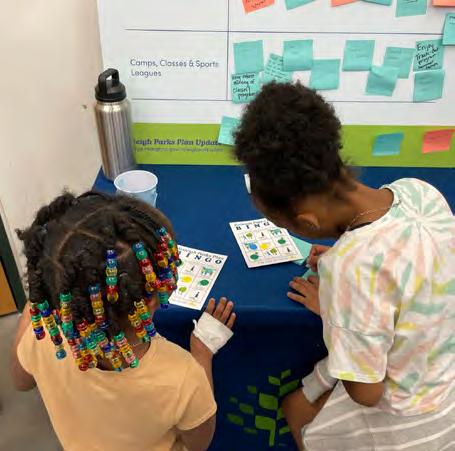
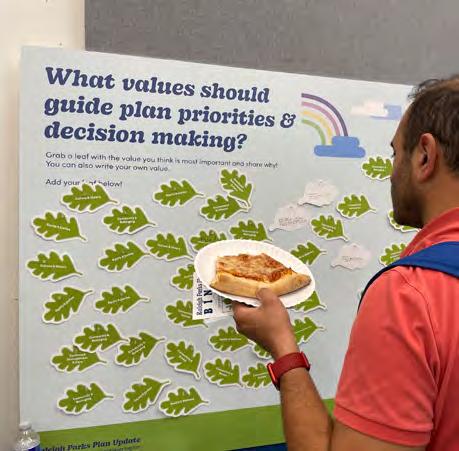
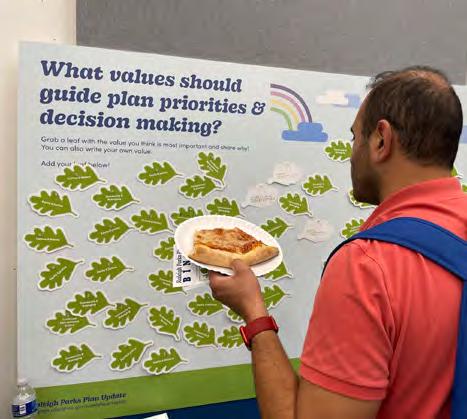
ENGAGEMENT TACTICS
Throughout the Parks Plan Update engagement process, engagement opportunities captured a holistic picture of community needs and aimed to lower barriers to participation. Concurrently, coordinated topic-specific meetings with key stakeholders and Raleigh Parks staff offered insights on how to better understand existing challenges and potential opportunities regarding implementation.
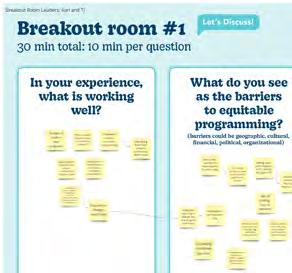
Listening Sessions
Four listening sessions were held in Summer 2023 to invite staff from all levels of the department to discuss operational barriers, departmental successes, and aspirations for the next ten years of Raleigh Parks. These Listening Sessions were also used to introduce the planning process to Raleigh Parks staff.
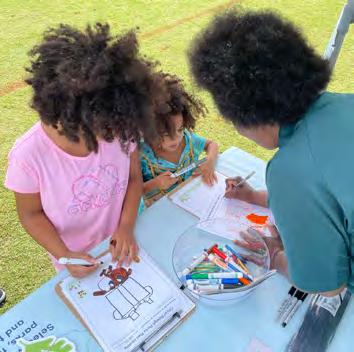
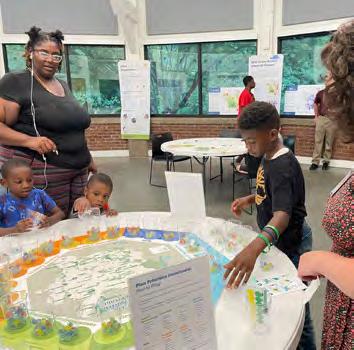
Pop-ups & Tabling Activities
Throughout the planning process, Raleigh Parks hosted nineteen staffed and unstaffed pop-ups at various community centers and events across the city. These pop-ups aimed to inform community members of the ongoing process and to receive feedback on community values to guide future decisions. The pop-ups provided a valuable opportunity to meet people where they are, share information regarding Raleigh’s many programs and services with those who may not be as familiar, and to promote future engagement opportunities.
Community-Wide Workshops
Two community-wide workshops were held at John Chavis Memorial Park in September of 2023. Each meeting consisted of an open-house format with multiple interactive activities for: 1) learning more about Raleigh Parks and the Parks Plan Update planning process, and 2) giving feedback on priorities and values that should drive the plan’s decision making. These stations aimed to facilitate both high-level input and deeper one-on-one conversations.
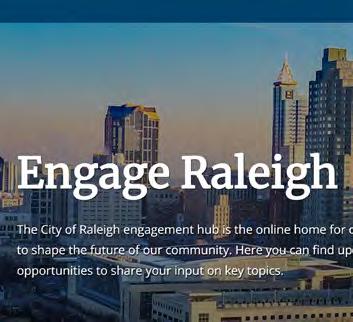
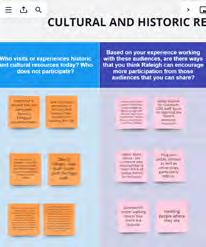


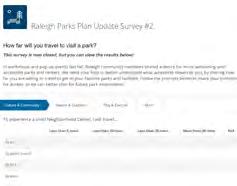
Plan Website
The City of Raleigh regularly utilizes a platform called Engage Raleigh (PublicInput) as a form of accessible engagement for residents. During the Parks Plan Update process, the project team used this platform to post regular updates, provide contact information, and share interactive activities and surveys for residents to provide feedback.
Focused Conversations
In the Spring of 2024, a total of eight focused conversations were held with relevant external stakeholders, neighborhood leaders, and internal department leads to identify possible future priorities for Raleigh Parks. These meetings drew from previous topic areas that were used in the 2014 Parks System Plan, including arts and culture, cultural and historic resources, parks, recreation, environment, greenways, mobility/connectivity, and growth centers.
Questionnaires/Surveys
The Parks Plan Update used inperson surveys at ten community centers across Raleigh, as well as online surveys, shared via email blasts, newsletters, and social media, to identify patterns and needs from a sample of current and potential users of Raleigh’s current park system. A total of 399 participants submitted responses over the course of three online surveys. The overall goal of the surveys was to achieve a high level of participation in the Raleigh Parks Plan Update planning process. Although the survey data was not intended to be statistically valid, due to the random nature of the survey distribution, conclusions could still be drawn from summarized results.
2,028 PARTICIPANTS
Planning Context
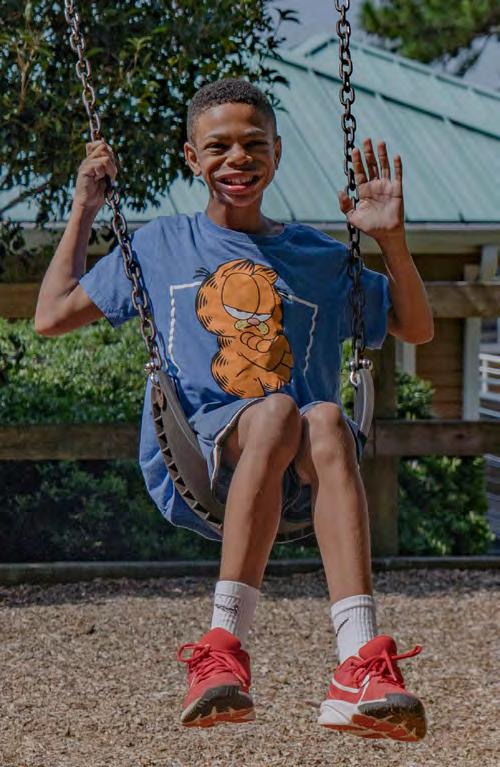
Throughout the Parks Plan Update process, Raleigh worked to align the parks department’s goals with other City and regional plans. This coordination is key to ensuring that Raleigh Parks’ vision for the future fits with the broader goals of the City. By connecting the Parks Plan with other City and County documents, Raleigh can create parks and facilities that meet the City’s long-term vision.
While not all plans directly focus on parks, recreation, and cultural resources, many of their goals require support from other City departments and outside agencies. As Raleigh grows, it’s important for city plans to work together on key issues like preserving natural spaces, developing housing alongside parks, improving transportation options, and building green infrastructure like stormwater systems.
As Raleigh Parks continues to expand its services, working closely with City and regional plans will help make a bigger impact on the community. Raleigh Parks recognizes the importance of parks in improving residents’ lives and is committed to providing high-quality park experiences to all neighborhoods across the city.
More details about the City and County plans that shaped the Parks Plan Update can be found in the following pages.
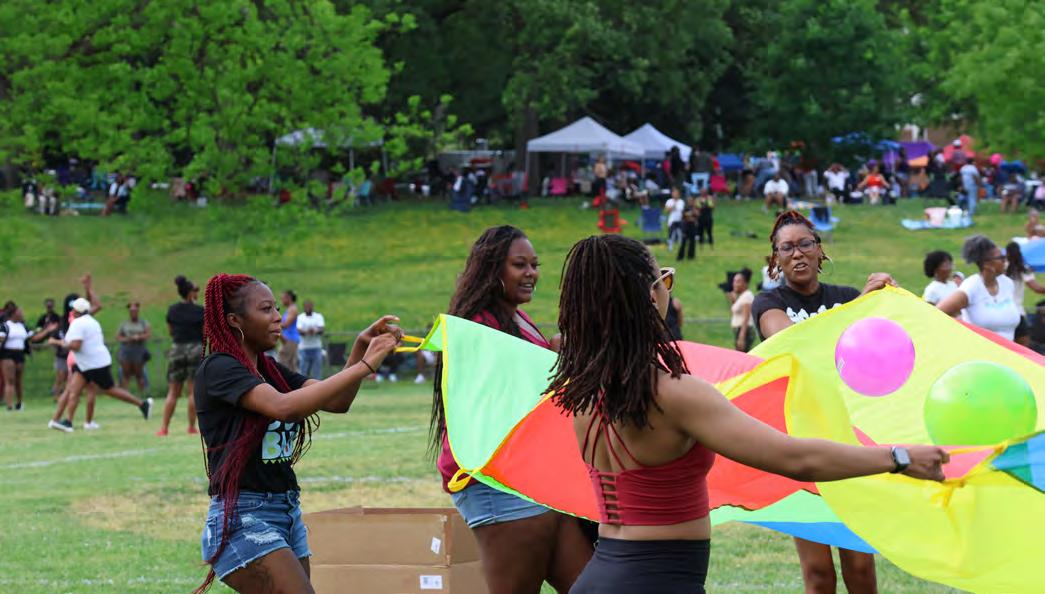
The Raleigh Parks System Plan (2014)
The 2014 Raleigh Parks System Plan shaped the direction, development, and delivery of the City’s parks, recreation, and cultural resource facilities and services over the next twenty years. The plan identified the top ten community priorities and seven guiding principles. The plan actions were communicated through eight topical chapters with twenty-five total goals. The eight topical chapters attempted to categorize what Raleigh Parks provides: Parks, Natural Environments, Greenways, Athletics, Programs and Services, Arts, Historic Resources, and Growth Centers.
Relevant Recommendations:
• Develop high-quality parks available within walking distance of homes and places of employment.
• Identify and address needs for high-quality park facilities and programs.
• Continue to protect, enhance, and expand natural environment areas while continuing to provide appropriate public access and use.
• Provide access to outdoor recreation and adventure opportunities throughout the city.
• Improve connectivity and enhance quality to greenway corridors and trails.
• Provide athletic venues and programs for every resident to maintain a healthy lifestyle.
• Improve outreach and foster a welcoming multicultural environment.
• Provide inclusive spaces, facilities, and programs that are accessible to all residents regardless of ability, age, or economic status.
• Make art more accessible to residents and support innovative arts through traditional and non-traditional venues and partnerships.
• Support historic resource preservation, protection, and acquisition, and attract more use and visitation of historic resources.
• Provide adequate park and open spaces within urbanizing areas of the City.
The Capital Area Greenway Master Plan Update (2022)
The 2022 Capital Area Greenway (CAG) Master Plan Update develops strategies to refine the vision for the CAG Program. The plan provides guidance for policies, projects, and programs, that address the environmental, recreational, and transportation needs of the community.
Relevant Recommendations:
• Expand the trail user data collection program and supplement data counters with in-person, mailed, and online surveys.
• Continue to improve trail connectivity to jurisdictions neighboring the City of Raleigh.
• Add bike share stations at key trail access points and trailheads.
• Establish and grow industry, economic development, and tourism partners.
• Evaluate active transportation, recreation, and open space preservation needs.
• Prioritize reinvestment for existing trails, while strategically building new trails.
• Extend operational hours to support active transportation uses of the trail network.
• Prioritize trail user safety and evaluate trail planning and designs that enhance safety.
• Continue to promote trail safety education, awareness, and outreach.
• Explore a range of operating and capital funding sources to support the growing needs and public expectations of the CAG System.
• Integrate new trail development as part of private development and research standards to encourage trail-oriented development.
• Encourage opportunities for public art along the CAG System.
Alignment with the broader vision for the CAG will expand bike and pedestrian connections within the city, increase the environmental protections of Raleigh’s green corridors, and improve the health and wellness of neighboring communities.
The Bike Raleigh Plan Update (2016)
The 2009 Bike Raleigh Plan was created to improve Raleigh’s bike paths and make biking safer and easier for everyone. It included ideas for new bike lanes, programs, and rules to help expand the city’s bikeway system. In 2016, the plan was updated to keep working on those goals and create a long-term vision for biking in the city. The main idea from community meetings was that people of all ages and abilities should be able to bike comfortably and safely. The 2016 update, revised in 2020, showed progress on projects and suggested new changes to improve biking in Raleigh.
Relevant Recommendations:
• Incorporate capital projects in the design and construction pipeline.
• Complete missing spine route connections on neighborhood sections.
• Add an existing sidepath rehabilitation and upgrade element.
• Align future park and greenway development with bike and pedestrian infrastructure to expand the opportunities for safe and comfortable non-car connections from neighborhoods to new parks and greenways.
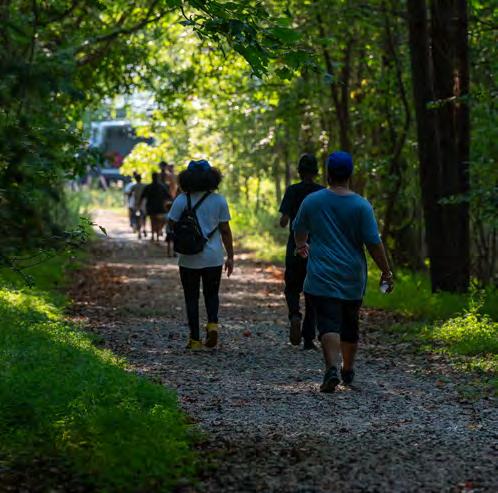
Community Survey
(2016, 2018, 2020, 2022)
Every two years, the City commissions a community survey to gather information about how satisfied the Raleigh community is with a range of issues impacting their quality of life within Raleigh. The purpose of these periodic surveys is to help the City gather input from the community on a wide range of issues impacting the overall quality of life, to measure progress toward responding to community needs, and refine departmental priorities for future investments. While these surveys identified that residents are highly satisfied with the quality of the City’s parks and greenways, some residents noted feeling unsafe when using parks and greenways.
Ensuring a strong sense of safety for all who visit Raleigh’s parks and greenways will play a vital role in creating welcoming and accessible spaces for all in the community.
The Wake County Greenway System Plan (2017)
The Wake County Greenway System Plan focuses on establishing and improving greenway trail connections inside of Wake County.
Relevant Goals:
• Improve access to outdoor recreation for health and wellness.
• Increase connectivity for multi-modal transportation.
• Support economic development and capitalize on trail-based tourism.
• Protect waterways, wildlife habitat, and natural areas along greenways.
As Raleigh Parks continues to expand greenway access across the city, it is important that all new developments advance these goals.
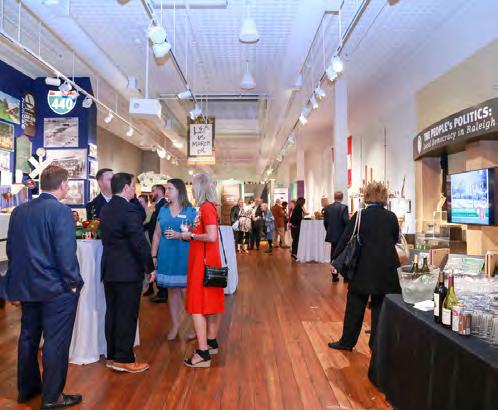
Historic Resources & Museum Program Strategic Plan (2018)
The Historic Resources and Museum (HRM) Program Strategic Plan assessed the operations and management of the HRM Program and identified ways to expand operations, effectively steward the city’s historic resources, grow and diversify the audiences the program reaches, and innovate in methods of interpretation and organizational governance.
Raleigh Arts Plan (2016)
The Creative Life vision focuses on the cultural interests of Raleigh’s residents. The plan laid out a a vision and ten-year blueprint for its cultural future. It is result of a yearlong process of community dialogue, research and refinement, involving more than 4,000 citizens from throughout the city’s many communities. The plan emphasizes coordination across all City departments to include arts, culture and creativity as essential strategies for assuring fulfilled lives for all.
The City of Raleigh Dog Park Study (2018)
The City of Raleigh Dog Park Study looks at the growing need for dog-friendly parks in the city and makes a long-term plan for creating and taking care of these spaces. This plan follows the recommendations from the 2014 Parks System Plan. It points out that both Raleigh’s expanding outer areas and the busy, crowded downtown need dog parks. The plan also focuses on three main things when thinking about future needs: public interest and community support, having enough suitable land, and the demand for dog parks. This helps Raleigh Parks plan where to add new dog parks in the future.
City of Raleigh Data Book (2019 and 2020)
The City of Raleigh Data Book is updated yearly and includes demographic and household trends, allocation of land use and zoning, economic development indicators, and transportation, public utility, and environmental resource summaries.
The 2030 Raleigh Comprehensive Plan Update (2019)
The 2030 Comprehensive Plan (adopted in 2009) and the 2019 Update seeks to prepare and respond to Raleigh’s twenty-first-century changes. The plan sets long-term visions and goals, provides policy guidance for growth and development, and contains action items for the City to achieve. The Plan contains six themes, which include Economic Prosperity and Equity, Expanding Housing Choice, Managing City Growth, Coordinating Land Use and Transportation, Sustainable Development, and Growing Successful Neighborhoods and Communities. The City of Raleigh then develops strategic plans based on the plan, which include
metrics and strategies for implementation within a five year timeline. Through the creation of citywide land use and environmental protections, the City empowers Raleigh Parks to continue creating high-quality parks and greenways.
Relevant Recommendations:
• Maintain and renovate existing parks and recreation facilities to meet current demographic needs and national trends.
• Acquire adequate land for future park development prioritizing underserved areas.
• Develop recreational facilities offering a wide variety of experiences in close proximity to all residents, equitably distributed throughout the city.
• Provide better interconnectivity between the parks, greenways, and open space system locally and regionally.
• Provide best practice management and stewardship of Raleigh’s natural resources, park lands, and open spaces.
• Integrate the parks and recreation system into a broader context of green infrastructure to maximize ecosystem conservation.
Fiscal Year 2021-2025
Strategic Plan (2020)
The 2021-2025 Strategic Plan looks to build a stable platform of evolving services for the community through which positive and sustainable growth are championed and visionary ideas are realized for all. The plan turns visions and goals from the larger 2030 Comprehensive Plan into actionable strategies and metrics for the next five years.
Relevant Strategies:
• Utilize parks, green spaces, and recreation facilities as cultural hubs, gathering spaces, and neighborhood resource centers to foster connection, creativity, and economic development.
• Identify opportunities to refine and enhance policies and programs that protect and improve environmental resources to include
the tree canopy, open space, and plant management policies and practices.
• Complete, adopt, and implement the Capital Area Greenway Master Plan to support a balance of environmental, multi-modal transportation, and recreational uses.
The Wake County Transit Plan Update
(2021)
As Wake County’s population grows rapidly, the existing transit infrastructure must grow and adapt to meet the future needs of the region. The Wake County Transit Plan created strategies to diversify the region’s transportation investments, increase travel opportunities to destinations, and improve the overall quality and mobility of its residents. Alignment with the Wake County Transit Plan helps Raleigh Parks plan proactively for new active transportation networks and parks that could be coordinated with transitoriented development.
Community Climate Action Plan (2021)
The Raleigh Community Climate Action Plan (CCAP) was the city’s first climate plan and was released in 2021, with implementation reports released on a yearly basis to track success toward the action plan’s goals. The CCAP recommendations include goals and strategies to invest in cleaner transportation, renewables, and energy efficiency and create a more equitable, healthy, just, accessible, walkable, and resilient community.
Capital Improvement Maintenance Study (2023)
The Capital Improvement Maintenance Study includes an assessment of current and ongoing capital maintenance across Raleigh Parks, identifying gaps and process improvements with City staff and stakeholders. It also includes a prioritization matrix based on stakeholder input and organizational values to guide future decisions. This matrix is used to create five-year and ten-year Capital Improvement Plan (CIP) Maintenance Plans.
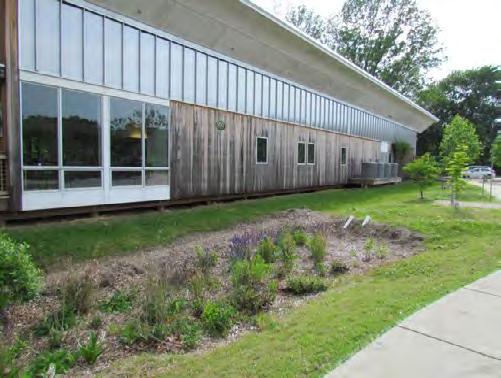
Green Stormwater Infrastructure Evaluation Policy (2023)
The City’s Green Stormwater Infrastructure (GSI) Evaluation Policy requires the evaluation of GSI on all City-led projects and promotes the installation of various types of GSI improvements to reduce stormwater runoff, improve water quality, and provide ecological benefits.
Summary & Key Findings
Across the many forms of engagement, the Parks Plan Update reached more than 3,000+ people across the City, both internal to Raleigh Parks and across the Raleigh community. Based on interactions with community members, stakeholders, staff, and leadership, a better understanding of the community’s diverse needs and priorities became clear. These findings helped guide the plan’s health framework, outcomes, and recommendations to ensure a final plan that lowers barriers to park access and empowers Raleigh Parks to create equitable parks, facilities, and programs for all. While engagement findings are not based on statistically valid data, engagement efforts did succeed in reaching a diverse range of residents across the various strategies. These community priorities are aligned with the Parks Plan Update’s Vision and Health Framework outlined in the following chapter, and accomplished the following:
1. A confirmed vision
2. Refined guiding principles
3. A revised framework
MILESTONE #1 LISTEN & LEARN THEMES
Raleigh should embrace and amplify healthy, vibrant communities.
Activities and conversations centered on the role of Raleigh Parks in healthy lifestyles that can adapt to a growing and aging community.
Connectivity and access remain a priority.
Residents continue to desire comfortable, accessible, and safe ways to get around without a car.
Parks should consistently feel safe and cared for.
Many participants highlighted opportunities to make parks and greenways feel safer and more welcoming. Community members expressed a desire for existing parks to be updated to be more equitable and inclusive.
Awareness and variety should be expanded in park experiences.
Community members shared a range of priorities for future investments in what their parks and facilities offer - from more English language classes, to more complete telling of the City’s history, to more activities for older adults and teens, to expanded aquatics programs and water access.
MILESTONE #2
VISION & FRAMEWORK THEMES
There was consensus across focused conversations related to the following topics:
Parks are critical infrastructure.
Most conversations acknowledged the outsized impacts of city parks, programs, and Raleigh Parks in the lives of the Raleigh community.
A desire for clear, regular dialogue.
Continued requests for “more” (partnerships, resources, capital investments) but also an acknowledgment that there is a fine line “between collaboration and advocacy.”
An opportunity to make space for “safe.”
Safety in parks and greenways came up across conversations as something that is front of mind across the Raleigh community.
A willingness to travel for special experiences.
Community members shared that they would be willing to travel longer distances to access dog parks, aquatics, and larger events. In contrast, teens expressed a desire for more relevant amenities closer to home.
MILESTONE #3 OUTCOMES & ACTIONS THEMES
In this phase, Raleigh Parks shared the draft plan framework and focus on health outcomes. Raleigh Parks posted informational boards and shared questions about the health outcomes to identify ideas for the plan’s direction. The following topics rose to the top of both staff and community engagement:
Prioritize investments in the protection of natural resources and nature-based programs.
Residents and staff recognize the role of trees, critical habitats, and natural resources in supporting their health and the health and resilience of the city.
Staff are one of the City’s greatest asset. Staff are Raleigh Parks greatest resource, and this plan can facilitate strategic planning to ensure staff also have the resources they need to do their best work.
Access and connectivity should be centered on Raleigh’s varied needs. There is abundant support to grow the greenway system and make it more of a destination, with opportunities for public art, events, food trucks, and other amenities.
EquityCentered Process
Even before the 2014 Parks System Plan was crafted, it was Raleigh’s vision to provide everyone with meaningful access to high-quality experiences that meet their recreation and health needs. Ribbon cuttings for new facilities, greenways, and parks are always exciting moments to celebrate investments in Raleigh’s community. However, to ensure these spaces remain valuable community assets, they require adequate maintenance budgets, continuous updates, and a strong connection with residents.
To ensure that the Parks Plan Update centered equity in its structure and outcomes, this process looked to guidance from well-respected organizations leading equity research and advocacy, best practices from other communities across the country, conversations with Raleigh staff and community members, and a review of Raleigh’s own history and policies, to make better investments in park access.
EQUITY IN PARKS AND RECREATION
Two national organizations have been instrumental in defining what equity means in park and recreation. Trust for Public Land (TPL) and National Recreation and Park Association (NRPA) have developed equity driven approaches to expanding access to parks and recreation services, briefly described in the following paragraphs.
Trust for Public Land believes that access to the outdoors is a fundamental human right, and that communities are stronger, healthier, resilient, and more connected when everyone can get outside and engage with nature. Yet, 1 in 3 people in the United States – 100 million people, including 28 million children – do not have access to a park within a 10-minute walk of home. Beyond access,
TPL views park equity holistically, comprised of factors such as quality, condition, and meeting of community needs. In 2021, TPL included an initial set of equity measures in its annual ParkScore Index, measuring the distribution of parks and park space within a city by race and income. These measures of distributional equity largely reflect the historical legacies of discriminatory policies that have resulted in troubling national patterns we see today. For example, residents of neighborhoods of color have, on average, 44% less park space per person than residents in predominantly white neighborhoods. TPL works through highly collaborative processes, including with the City of Raleigh, to close the outdoor and park equity gaps in the U.S., via a wide range of activities – from on-the-ground parks and land protection efforts, to policy, planning, and funding work, to research, trainings, and other forms of technical and capacity-building assistance. All of this work is driven by the organization’s commitments to health, climate,
Who are the national leaders in Parks and Recreation research?
The Trust for Public Land (TPL) believes everyone should have access to the outdoors. TPL is a national non-profit that has worked for over 50 years with communities across the country to champion land protection, park development, planning, funding, and advocacy. With commitments to health, climate, community, and equity, TPL helps communities create and protect places that bring us outside—parks, trails, community schoolyards, and public lands—and make them available and welcoming to all. TPL is dedicated to ensuring that every person, in every community, has access to safe, free, quality outdoor space to connect with nature and other people.
The National Recreation and Park Association (NRPA) is a group that supports parks and recreation programs across the U.S. The NRPA helps communities by promoting healthy activities, protecting green spaces, and providing resources for Park and Recreation agencies to improve their operations, capital investments, and quality of their programs and facilities.
community, and equity. Community is always centered in these efforts, through partnership with historically and economically marginalized communities to ensure their voices lead the way in expanding access to parks and public lands.
The NRPA starts by identifying where equity can have the most impact. The organization defines equity in parks and recreation by starting with race, acknowledging that racial inequities persist in every system across the country, including parks and recreation. This approach is underpinned by a commitment to continuous learning, growth, and collaboration. The NRPA
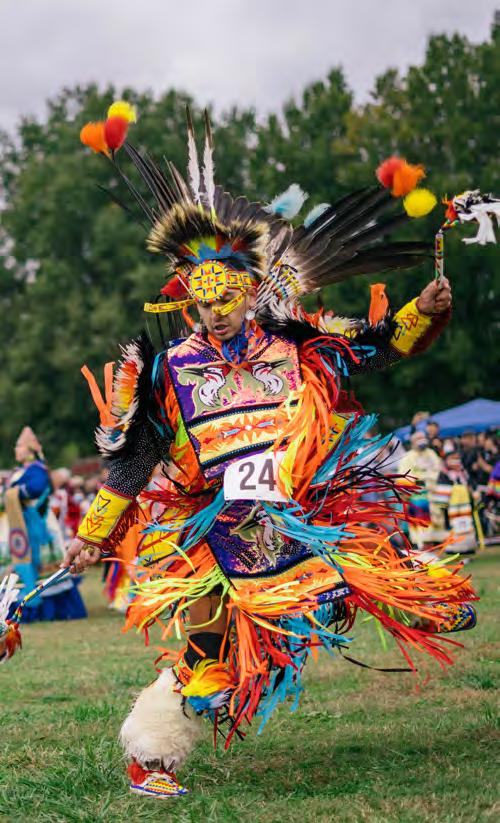
emphasizes the importance of examining organizational practices to identify and address inequitable systems and exclusionary practices, ensuring accountability for taking action. Additionally, equity is defined by expanding park access, ensuring fair distribution, proximity, and connectivity to quality parks, green spaces, and recreation facilities. The NRPA aims to provide programming that is safe, inclusive, culturally relevant, and welcoming to everyone.
RALEIGH’S RELATIONSHIP WITH EQUITY
The City of Raleigh is committed to building a fair and inclusive community for everyone. Achieving racial equity means addressing policies and systems that have negatively impacted Black, Indigenous, and People of Color (BIPOC) community members and working on policies that correct these historic inequalities, improving the quality of life for all residents. Because of past discriminatory practices in parks, planning, and development, not everyone has had fair access to parks, trails, community centers, and programs that help people live healthier lives. This is part of a larger history, including the taking of Indigenous lands and the segregation of parks based on race, that has harmed BIPOC communities in Raleigh.
Raleigh Parks has been focusing on equity in its recent decisions and investments, and the Parks Plan Update continues this effort. The plan centers on equity, using community engagement to share the history of Raleigh Parks, understand current barriers to access, assess changing needs, and create a vision for an equitable park system where everyone can enjoy quality parks and green spaces. For more information about how Raleigh is evolving its approach to equityinformed investments, go to Chapter 5.
Denver, CO
Los Angeles, CA
San Diego, CA
Minneapolis, MN*
Raleigh, NC
Mecklenburg County, NC
Charleston, SC
Austin, TX
COMMUNITY BEST PRACTICES
To learn how other cities are addressing equity in their park and recreation investments, the Parks Plan Update looked at seven peer cities with similar racial and socioeconomic makeups to Raleigh (listed on the next page). Of these, three cities had clear equity-focused park plans and prioritized investments in social and racial equity. These best practices show different ways to ensure that all communities have access
to quality parks that improve public health, strengthen social connections, and support environmental sustainability. Each city uses data-driven decisions and allocates resources to prioritize underserved areas. While these cities differ in growth patterns, climates, and social challenges, their responses to equity needs have been inspiring and helped shape the Parks Plan Update’s structure and approach.

City and County of Los Angeles
The Park Proud LA Strategic Plan and Los Angeles Comprehensive Parks and Recreation Needs Assessment
Home to approximately 3.9 million people, Los Angeles boasts one of the largest and most comprehensive parks systems in the country. The system encompasses approximately 16,000 acres of parkland and has an annual budget of around $300 million per year.
In March 2015, the Los Angeles County Board of Supervisors launched the Countywide Comprehensive Parks and Recreation Needs Assessment. This groundbreaking initiative documented existing parks and facilities across all communities, using data to identify areas of
need. The assessment guides local officials, park agencies, and residents in ensuring equitable park access. With Proposition A funding expiring in 2019, this assessment was crucial for future planning and funding decisions. By initiating this assessment, the Board underscored the role of parks as essential infrastructure, vital for public health, community cohesion, environmental improvement, and economic growth.
Los Angeles’ City and County Parks Departments centered equity in their long-term planning efforts through seven priority goals that identify a series of desired outcomes. Each outcome lists objectives along with a key metric used to measure, evaluate, and report on its progress annually. By centering desired outcomes before the objectives, this approach gives the department flexibility as they determine how best to achieve outcomes while still providing a target metric.
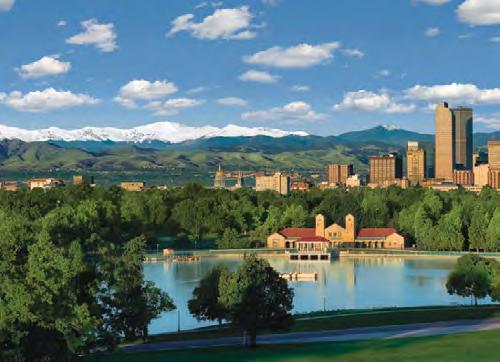
City and County of Denver
Denver Game Plan
Denver Parks and Recreation has positioned itself with a balanced approach to providing high quality parks and programs for residents. The parks system includes thirty recreation centers and almost 20,000 acres of urban and mountain park spaces.
This plan is guided by four guiding principles that work to support the vision of achieving a healthy city. The guiding principles are supported by goals and strategies, and an implementation chapter highlights recommendations, priority action steps, and metrics to measure progress over time.
Since the plan was released in 2018, the City has released annual reports that are shared as online ESRI StoryMaps, which are organized by the four guiding principles. Each StoryMap links to CIP maps that highlight past and future funding priorities tied to the plan’s “equity index” which maps different community demographics (race, morbidity, poverty, education, access to food, among others) and overlays those demographics over park access maps. The equity index helps the City identify where to spend tax dollars on facility renovations and new park spaces and ensures that the majority of future projects are located in the communities that need investments most.
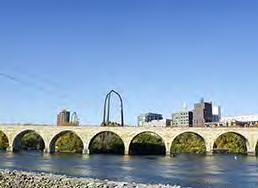
City of Minneapolis
Parks for All: Minneapolis
Comprehensive Plan
Minneapolis is consistently named the nation’s top park system for its unrivaled park access, level of investment in improvements to existing parks and new parks, and its diverse range of amenities and experiences. The Minneapolis Park and Recreation Board oversees 7,000 acres of park spaces, forty-nine recreation centers, and 102 miles of trails. Minneapolis’ population of 425,000 residents is also a similar size to Raleigh’s 476,000 residents, even though Minneapolis covers less geographic area than Raleigh.
The City’s plan, completed in 2021, outlines nine goals with associated strategies. These goals are guided by department values, and respond to nine potential future realities that Minneapolis is likely to experience in the coming years. Each goal is paired with a series of indicators that are publicly accessible through the Parks for All Goals Dashboard, a storytelling tool that tracks overall progress with the broader public and keeps the department accountable to its goals and actions.
Equitable Park Access
Raleigh is committed to improving equitable access to parks, greenways, arts and cultural resources. Understanding and addressing the causes of disparities in access to quality parks and green space is central to making these changes. Access, community needs, and demographics across the city vary. This means that Raleigh Parks has the unique challenge of providing and maintaining enough park land and variety of experiences to ensure access is equitably distributed and is most responsive to the communities that have been historically underserved.
WHAT IS PARK ACCESS?
Park access is a measure of how easily residents can get to a City park, facility, or greenway trail. Today, Raleigh Parks uses specific criteria to evaluate how parks and park experiences are distributed to make decisions about where future investments should be made. These criteria are driven by values like providing equitable access
and meeting the highest community need, to help prioritize park access and park investment. This update is a chance to modify this system to respond to the community’s values and increase park access to the communities that need it most.
The most common tool that Raleigh Parks uses is the 10-Minute Walk® program. This evaluates whether a resident can reach a high-quality park experience within a ten-minute walk, typically considered to be about half a mile, of their home. Launched in 2017 with National Recreation and Park Association (NRPA) and the Urban Land Institute, this effort continues to champion equitable access to parks and to promote policies and practices that would help achieve park equity. These organizations partnered to champion equitable access to parks and to promote policies and practices that would help achieve this goal.
An early adopter of the standard, Raleigh Parks recognizes the importance of accessible parks for fostering healthier, more connected communities and improving residents’ quality of life through recreation and being outdoors.
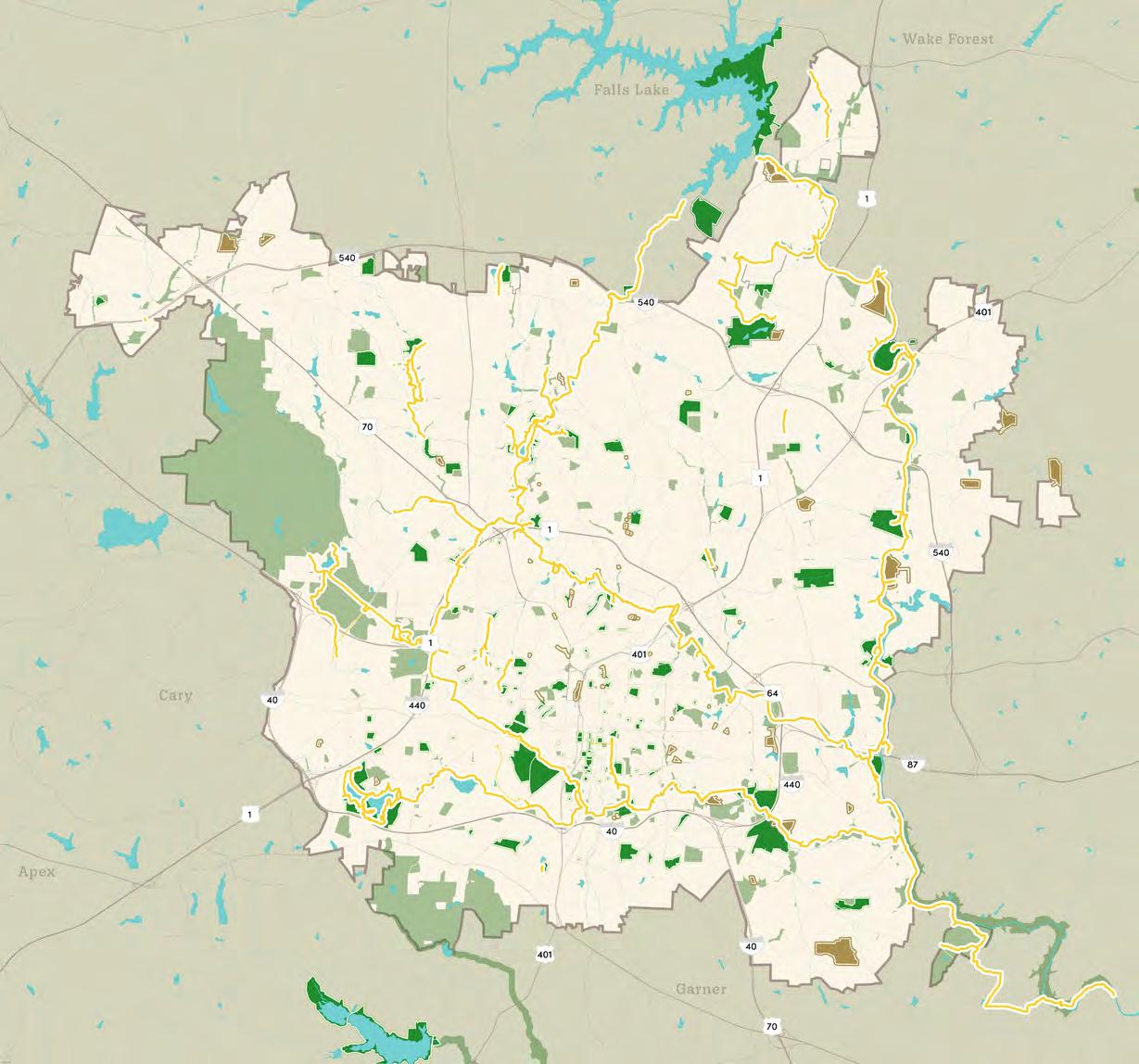
Parks and Open Space
Existing Raleigh Parks
Other Public Open Space
Future Raleigh Parks
Greenway Trails
Working to align with the 10-Minute Walk® program, Raleigh Parks creates maps and inventories of all parks and experiences to better understand park access and investment across the city. This standard of understanding access and investment is called Raleigh Parks’ Level-ofService.
Since the 2014 Parks System Plan and the introduction of the 10-Minute Walk® program, Raleigh Parks has been moving toward a goal of ensuring that every resident lives within a ten-minute walk to core experiences and varying goals for travel for the range of citywide experiences beyond those core experiences.
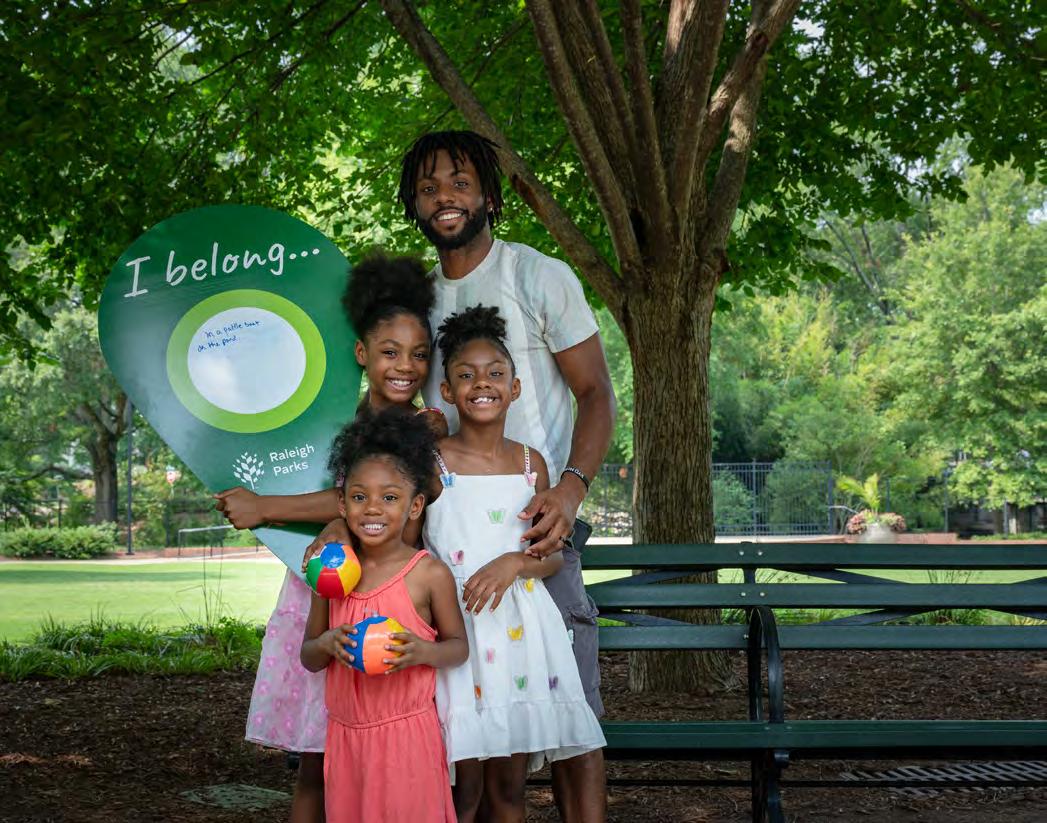
Providing Equitable Access
Park access can be defined by a few key factors. The distance that residents may have to travel to get to their favorite park or greenway trail is an important component. Park acreage in nearby parks is also important, in addition to the number of experiences residents have access to in nearby parks. Today, Raleigh Parks evaluates access using four factors: distance community members need to travel to their nearest park, distance community members need to travel to their nearest greenway trail, amount of park acreage in nearby parks, and number of different experiences residents have access to in nearby parks.
Responding to Community Health Needs
When the City first began to evaluate park access and community needs for parks, Raleigh Parks used Wake County Health and Human Service’s Community Vulnerability Index, which prioritizes health equity in decision making. Wake County Health and Human Services identifies community need as a combination of five indicators relating to data on health equity, including unemployment, low educational attainment, age dependency, housing vacancy, and poverty rate.
Evolving the Park Access Model to Center Equity
To further evolve the City’s park access model, Raleigh Parks is participating in the 10-Minute Walk® Park Equity Accelerator (PEA), which is a technical assistance program hosted by TPL to test policy ideas, pilot best practices from other cities, and increase access to park experiences, while centering equity in decision making. In addition, learnings from the 10-Minute Walk® Communities of Practice’s “Park Qualities Incubator” track are also informing the evolving model Raleigh Parks uses to stay ahead of park access modeling and implementation innovation.
Raleigh’s Equity Modeling Achievements and Accolades!
G. Herbert Stout Award
In 2017, the Geographic Information System (GIS) model created by Raleigh Parks for the Neighborhood & Community Connections (N&CC) Program was awarded the G. Herbert Stout Award for Visionary Use of GIS by a Local Government in North Carolina. The model helped identify and prioritize investments in new walkable connections to parks and greenways.
On Common Ground Program
In Spring 2023, Raleigh Parks received a $25,000 grant from TPL to enhance community interactions through parks. Using this grant, the “Welcome to Raleigh Parks” pilot program was launched, introducing community members to the department’s inclusive and diverse offerings.
10-Minute Walk® Park Equity Accelerator (PEA)
In Fall 2023, Raleigh was selected as a participant in TPL’s PEA program. TPL’s Park Equity Accelerator is the first of its kind, addressing the root causes of park inequities shared by many of the 10-Minute Walk® program’s champion cities. The Accelerator will provide focused resources and technical assistance, partnership, and education to help move the needle on park equity by field-testing policy ideas, gathering real-world insights on the process of systems change, and scaling learnings to benefit other communities.
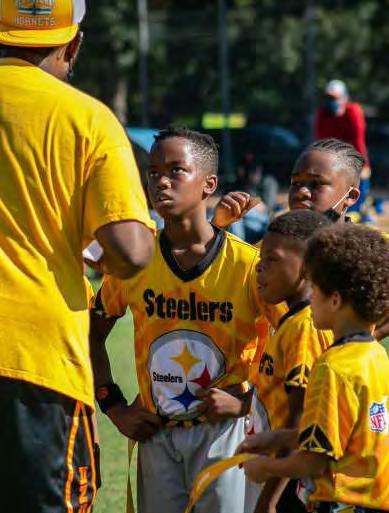
CHAPTER 4 VISION & HEALTH-FOCUSED FRAMEWORK
Vision Bringing people to parks and parks to people
Across the nation and around the world, the importance of public open spaces and recreation programs is growing as issues like equity, public health, economic development, environmental change, financial sustainability, and cultural identity take center stage. Raleigh Parks plays a crucial role in addressing these issues, forming a vital part of a healthy and resilient community. Recent challenges, including the COVID-19 pandemic and climate change, along with the enduring realities of systemic racism, have underscored the need to rethink relationships with parks, facilities, and programs.
Raleigh Parks’ vision, Bringing people to parks and parks to people, positions the organization to address the needs of all and foster a community of creativity, engagement, healthy lifestyles, and welcoming neighborhoods. This bold vision, the guiding principles, and the plan’s health outcomes will be essential to achieve the community benefits Raleigh Parks is striving toward and will help make the City more accessible, resilient, and just.
WHAT we have
A HEALTHY SYSTEM
WHAT are the needs
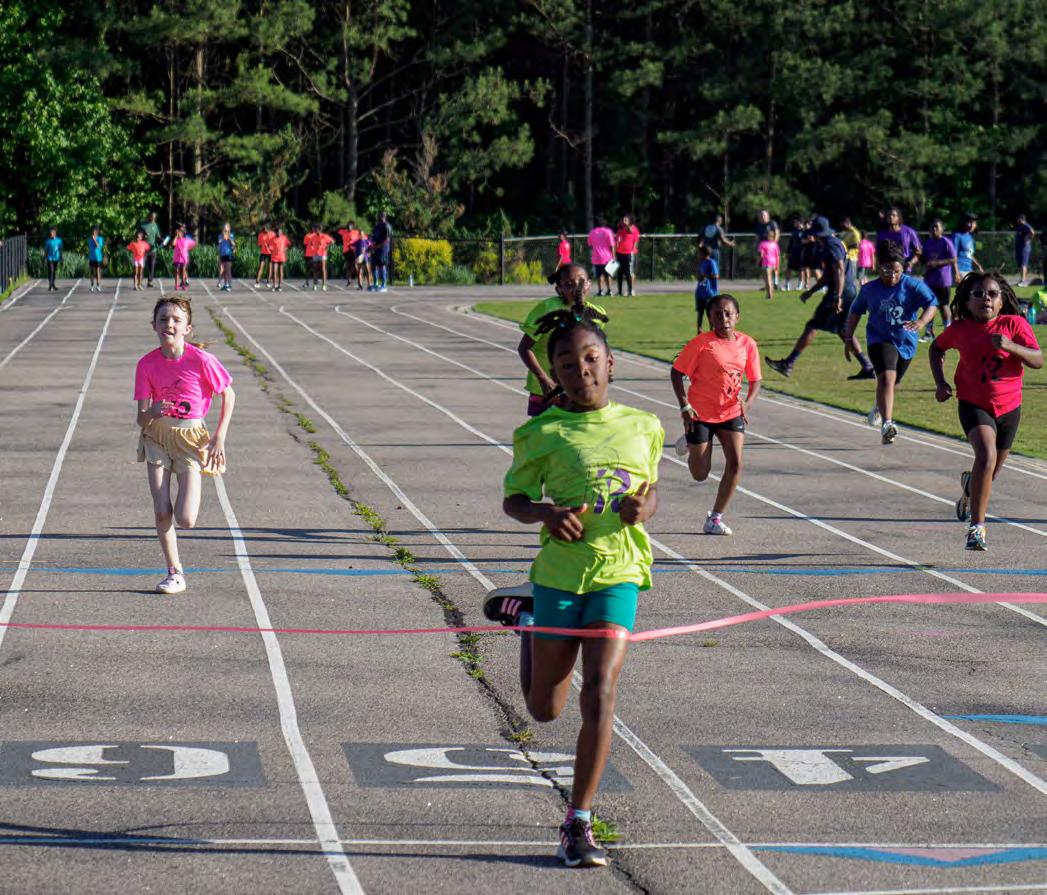
2014 Parks System Plan
Guiding Principles
• Connectivity and Accessibility
• Equitable Distribution
• Continuous Reinvestment
• Collaboration and Coordination
• Balanced Experience
• Innovation
• Communication and Engagement
Parks Plan Update
Guiding Principles
• Connectivity and Access
• Equity and Justice
• Continuous Reinvestment
• Collaboration and Coordination
• Creativity and Innovation
• Community and Belonging
• Culture and History
• Resilience and Stewardship
GUIDING PRINCIPLES
Supporting Raleigh Parks’ vision, guiding principles articulate the shared values of the community and provide strategic direction to the department about what is most important while navigating change. Based on community feedback through the engagement process, the eight principles below evolve the guiding principles from the 2014 Parks System Plan to address evolving and heightened community interests and priorities and guide the next phase of Raleigh Parks’ practice in the provision of parks, recreation, cultural facilities, and services throughout the city.
Connectivity and Access
Plan, design, adapt, and operate parks, open spaces, greenways, and facilities to maximize connectivity and access in all its forms: physical, economic, programmatic, and symbolic. The system should promote health, wellness, and economic development through connectivity among facilities, neighborhoods, commercial areas, and employment centers to achieve the goal of walkable access for all residents and provide a strong sense of community across the region.
Equity and Justice
Ensure that equity and justice are key drivers in the everyday experiences offered by the park system, as well as its long-term evolution. While equitable distribution of facility and service offerings is still key, Raleigh Parks should go beyond equitable distribution of offerings and collaborate with other agency and community partners to address displacement and green gentrification concerns with a holistic approach.
Resilience and Stewardship
Evaluate evolving interests and priorities regularly, striving for the highest level of environmental resilience practicable. Focus on improvements to and preservation of Raleigh’s air, water, soil, and habitats and reduction of reliance on non-renewable resources. Improvements and preservation should be sustained through continuous investment, education, and partnership.
Culture and History
Understand and celebrate the unique and diverse cultures, histories, arts, and peoples that make Raleigh a special place to live, work, and play. Through cultural enrichment and public art engagement that reflects and showcases the local community, Raleigh Parks can offer authentic places and experiences that resonate broadly with residents and position Raleigh as a cultural destination.
Continuous Reinvestment
Continue to evaluate and evolve the system and its offerings to align with the City of Raleigh’s Strategic Plan, the community’s changing needs, and broader trends in parks, open spaces, greenways, and facilities. Raleigh Parks and its partners should continue to regularly invest in, maintain, and upgrade the system to keep up with the growing population, changing demographics, and industry trends, in order to sustain a high quality of life for City residents.
Collaboration and Coordination
Welcome broad, inclusive, and healthy collaboration via multifaceted approaches. Raleigh Parks relies on many agencies, partners, and institutions to deliver services and maximize its impact, and it should continue to embrace opportunities to grow and leverage resources through relationships, including inter-departmental collaboration, interagency cooperation, and public-private partnerships.
Creativity and Innovation
Embrace an organizational mindset of creativity, risk-taking, and innovation, and empower all members of the Raleigh Parks’ team and the community to be part of continuous and collaborative learning. This willingness to experiment and test ideas will allow for Raleigh Parks to respond to evolving priorities of the community in a timely manner, seek outof-the-box solutions along with tried-andtrue strategies, and continue its reputation as a national model for excellence.
Community and Belonging
Exercise care for the community in all places, programming, communications, and engagement processes. By expanding tools, tactics, and strategies, Raleigh Parks can bridge historic barriers such as race, language, economics, and work culture. This can help welcome broader community perspectives to enjoy park system resources and engage in decisionmaking processes.
A HEALTHY SYSTEM: Reframing through the Lens of Equity & Health
Individual Outcomes
Community Outcomes
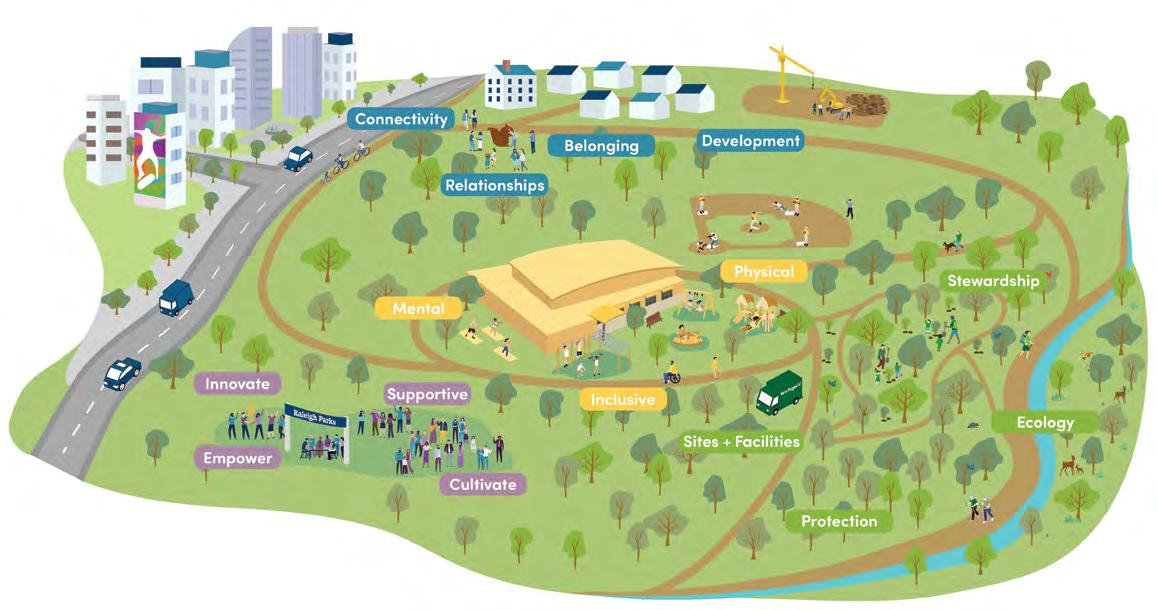
A Healthy Raleigh
There is growing recognition that parks and recreation systems are closely linked to health and wellness, across multiple dimensions. Parks impact the health and wellbeing of both individuals and their communities. The World Health Organization describes these health benefits through four lenses: physical, mental, social, and environmental.1 A similar framework developed by the Urban Institute, specifically related to health outcomes and parks, also serves as an inspiration for this approach.2
Green space provides opportunities for outdoor activity and can improve physical health. Being in and among nature can promote mental health and relieve stress.3 Parks are places where people can gather, connect, learn, and socialize. Moreover, parks can help communities be more resilient to environmental change, offering shade, storing water, and preserving diverse habitats. In short, park and recreation systems are treasured assets that also play an important role in helping communities to thrive.
A quality park system can improve public health and advance health equity, meaning everyone has a fair chance to be as healthy as possible. When we think about how parks help us stay healthy, we consider their size, quality, and the experiences they offer. Whether the park is a smaller neighborhood park or larger community park, has trails that are easily accessible, or includes public art amenities or programs that the surrounding community desires, these factors affect community health. For example, parks can help reduce preventable health issues by offering affordable fitness and recreation programs or healthy food options in community centers.
1 What is Health Equity? CDC: Centers for Disease Control and Prevention
2 A Framework for Assessing Equitable Health Outcomes of Parks, Urban Institute
3 Elevating Health Equity Through Parks and Recreation: A Framework for Action. National Recreation and Parks Association (NRPA). 2021.
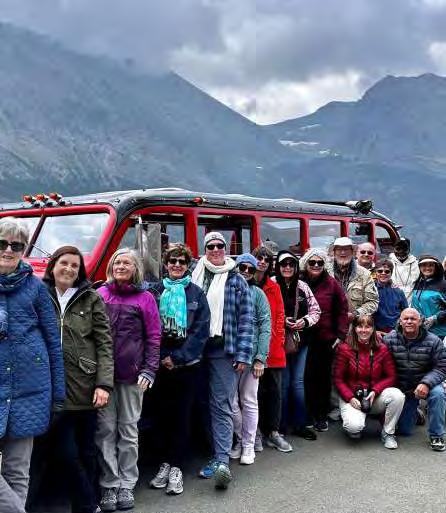
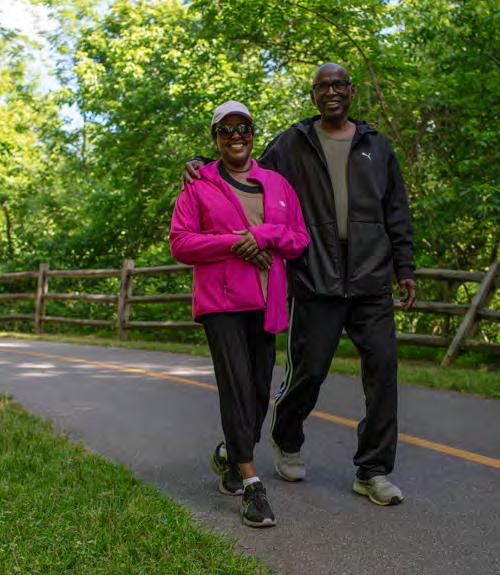
Health Outcomes
Individual Wellbeing
WellbeingIndividual Environmental Resilience Community Cohesion Organizational Commitment
A vision for health equity in projects, policies, and programs can help to ensure equitable access to high-quality park spaces for all. This approach helps develop a critical eye for current systems and adjust those accordingly to ensure equitable access. When health equity is achieved, everyone can enjoy equitable access to places, programs, and services that improve health while also enjoying a robust parks system. Now more than ever, it is important for park and recreation professionals to make sure everyone feels welcome and can enjoy the benefits of park and recreation systems. With this in mind, this update centers health equity as the primary focus of Raleigh Parks over the next five to ten years. To do so, the plan defines a series of desired health outcomes within four lenses – the individual, community, environment, and organization.
Physical Wellbeing. Access to play, exercise, and a healthy lifestyle
Mental Wellbeing. The ability to pursue emotional, psychological, and social wellbeing
Inclusion and Relevance. Reduced barriers and something for everybody
Community Cohesion
Belonging. A sense of community identity and belonging
Relationships. Strong relationships with communities
Development. Balanced growth and a robust local economy
Connectivity. Connections between people, places, and communities
These outcomes serve as goals to move toward in both the short and long-term actions of Raleigh Parks.
This update is driven by desired health outcomes, a unique approach within the context of traditional park system plans. Many system plans set forth a complex structure of goals, strategies, and defined actions as a means of creating change. While this allows a high level of certainty for immediate action, it also risks becoming obsolete as time passes and the plan context changes. This was the case for many park systems during the COVID-19 pandemic, where new challenges were immediate and urgent.
Environmental Resilience
Ecology. A sustainable, resilient, citywide ecological framework
Sites & Facilities. Best design, management, and operational practices in all sites and facilities
Stewardship. A community of active and passionate stewards
Protection. Sensitive habitats and corridors are protected
Organizational Commitment
Support. Difference embraced and invested in, in all of its forms
Cultivate. A workforce representative of the community
Innovate. A culture of innovation, creativity, and collaboration
Empower. A model parks and recreation agency committed to equity and effectiveness
ACTION-ORIENTED System Deep Dive
For each of the health lenses, a “System Deep Dive” is provided to showcase work underway today or specialized analysis conducted during this planning process. These include:
Individual Wellbeing
Learn about recommendations for an equitable User Fee Policy
Community Cohesion
Understand potential big ideas included in the Raleigh Parks Programming Assessment.
Environmental Resilience
Explore how Raleigh Parks is walking the walk when it comes to environmental initiatives.
Organizational Commitment
See how Raleigh Parks is driving toward departmental by pursuing CAPRA accreditation
An outcome-driven process offers more flexibility, providing a “finish line” but not prescribing exactly how to run the race. This approach empowers staff and leadership alike, allowing everyone to play a role in imagining, testing, and troubleshooting how to get to a particular goal. Actions can be adjusted based on what is needed at the moment, instead of sticking to a fixed plan that might become outdated or prove to be difficult to achieve. Outcome-driven processes embrace risk, shared learning, innovation, and accept that paths to reaching stated goals are not always clear or linear. Having a flexible framework allows changes to be made months or years down the line as new situations arise or more is learned along the way.
This chapter identifies plan outcomes that help to achieve a more equitable and healthy community. These outcomes are framed by four lenses that represent different scales of impact - the individual, community, environment, and organization.
The next chapter, focused on the implementation plan, discusses how potential actions can help reach each of these important community outcomes.
Individual Wellbeing HEALTH OUTCOMES
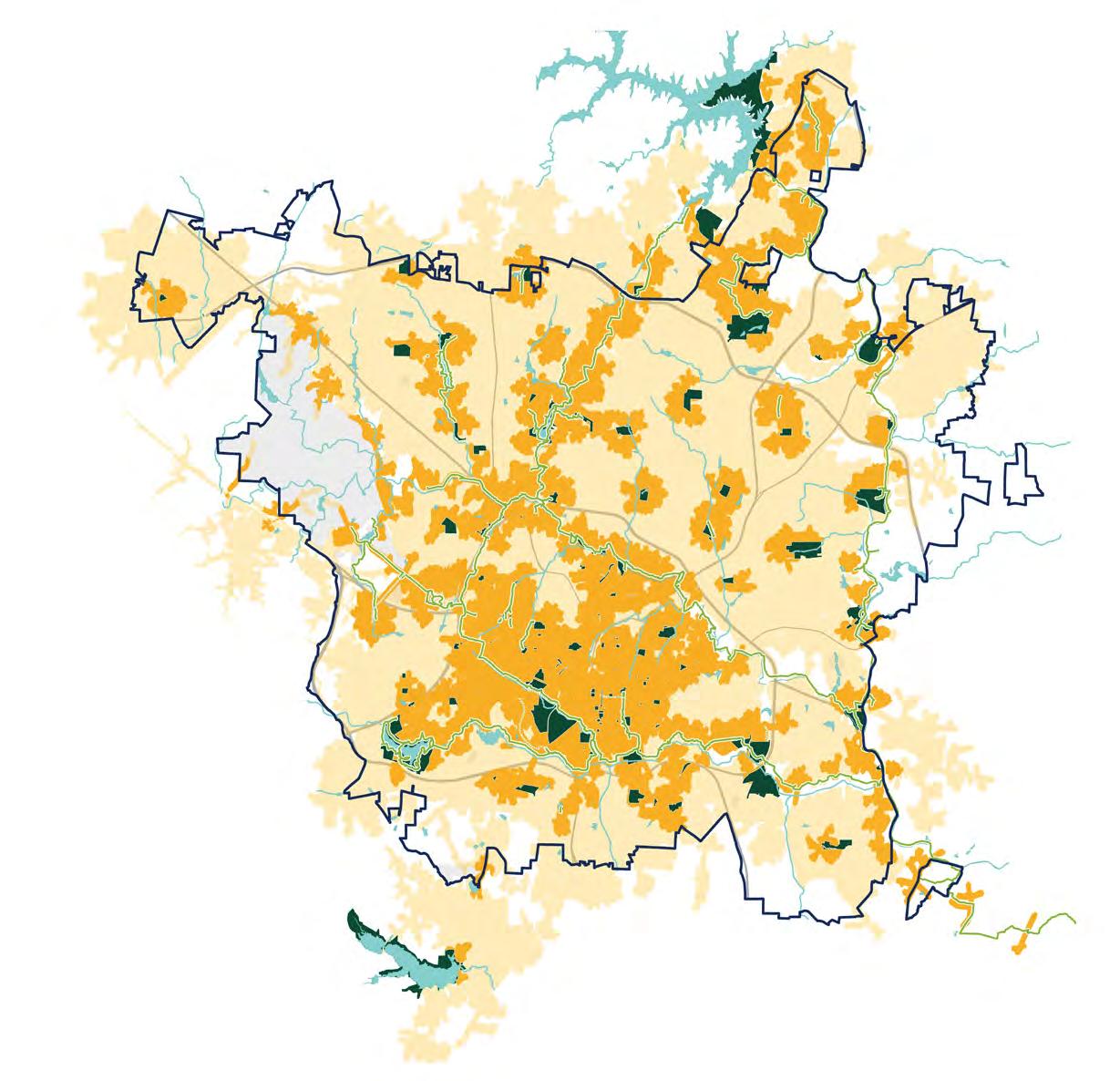
Individual Wellbeing Park Experience
Raleigh-owned Parks
Other Open Space
Core Experience (10-min walk)
Neighborhood Experience (5-min drive) Greenways
Raleigh’s park system provides resources that offer some of the best ways for residents and visitors to get and stay healthy. Individual benefits of park systems include greater physical and mental wellbeing. Access to parks and nature has been linked to improved mood, reduced stress levels, and overall wellness. Even just viewing trees and nature improves health.4 Communities with high-quality parks and facilities tend to have higher levels of physical activity among residents, reducing the chances of serious illnesses, such as heart disease and diabetes, helping to limit depression and anxiety, and enhancing mental wellbeing. The majority of adults in the United States agree it is important to have access to indoor and outdoor recreational areas, classes, and activities in order to lead a healthy lifestyle.5
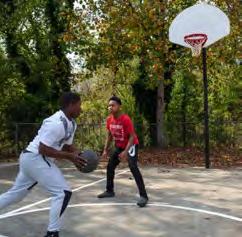
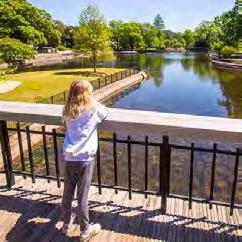

Parks have a big impact on health equity. They are often the only free, publicly accessible, welcoming places for physical activity. Parks can contribute to the elimination of health inequities by ensuring that all individuals have access to recreational spaces and affordable activities, classes, and programs. By creating opportunities for people to get out and exercise, gather with family and friends, or just relax, parks are more than just places to play - they help people live longer and healthier, improving quality of life!
Within the lens of individual wellbeing, there are three health outcomes that the Park Parks Plan Update strives to achieve: physical wellbeing, mental wellbeing, and inclusion and relevance.
Physical Wellbeing
Access to play, exercise, and a healthy lifestyle
Mental Wellbeing
The ability to pursue emotional, psychological, and social wellbeing
Inclusion & Relevance
Reduced barriers and something for everybody
4 Erica Gies, The Health Benefits of Parks: How Parks Help Keep Americans and Their Communities Fit and Healthy, Trust for Public Land, 2006; Parks and Recreation Is Essential. National Parks and Recreation Association.
5 Physical Activity, Parks, Recreation, and Green Spaces, Center for Disease Control.
INDIVIDUAL WELLBEING
Physical Wellbeing
ENGAGEMENT FEEDBACK
“Healthy lifestyles” and “places to walk or ride a bike” emerged as top priorities across all engagement methods.

Access to play, exercise, and a healthy lifestyle
Places that provide opportunities for movement, whether they are basketball courts, open grassy areas, trails, or indoor gyms, play a crucial role in physical wellbeing. Physical wellbeing can be defined as the ability for all individuals to pursue play, exercise, and a healthy lifestyle. Park and greenway systems create safe spaces for physical activity and recreation, offering opportunities for various forms of movement, from walking to biking to sports and athletic programs. According to the CDC, people who have more access to green spaces tend to be more physically active than those who have limited access.6 Additionally, the closer people live to a park and the safer they feel in the park, the more likely they are to use those spaces for physical activity on a regular basis.
Regular physical activity in parks, on trails, and in community centers can increase life expectancy, reduce major mortality risk factors, and increase quality of life. Participation in these physical
6 Physical Activity, Parks, Recreation, and Green Spaces, Center for Disease Control.
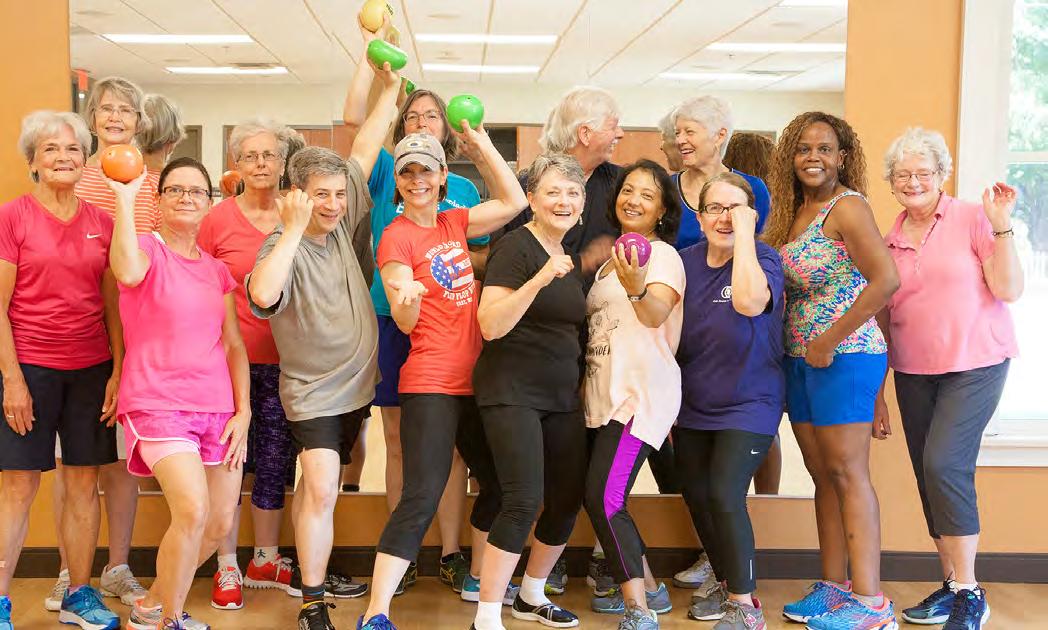
activities can manage and reduce the likelihood of certain illnesses such as cardiovascular disease, diabetes, and arthritis. Physical activities are therefore a preventative health measurereducing the likelihood of these illnesses along with associated medical costs.
There are many examples of Raleigh Parks’ successes with improving physical wellbeing across the city. Identified as high-priority action items from the 2014 Parks System Plan, Raleigh Parks continues to identify potential partners for program and event opportunities to promote healthy living options. Another high-priority action item that could help achieve this outcome includes the work that Raleigh Parks is doing to review policies on healthy food options offered at community centers, including identifying barriers to access and increasing community participation.
Relevant Achievement
Raleigh has made increased investments into health and wellness programing, like the mobile healthcare bus, Adult Recess Festival, and adult sport leagues.
Current Challenge
Physical inactivity in NC among adults is 23%. This includes residents who report no additional physical activity or exercise other than their regular job.
-National Institute of Health
INDIVIDUAL
WELLBEING
Mental Wellbeing
ENGAGEMENT FEEDBACK
“Staff can be community partners who can help normalize discussions around mental health to destigmatize it, particularly among teens.”
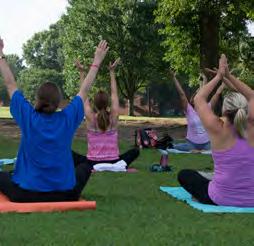
- Focused conversation participant
The ability to pursue emotional, psychological, and social wellbeing
More time spent in parks and green space can have positive effects on mental wellbeing. Proximity to and density of green space is associated with improved mental health outcomes, including self-reported happiness.7 As highlighted in a study by the National Recreation and Park Association (NRPA), people living more than one kilometer away from a green space are fifty percent more likely to experience stress than those living less than 300 meters from a green space.8
7 Capaldi, Colin A., Raelyne L. Dopko, and John M. Zelenski. “The Relationship between Nature Connectedness and Happiness: A Meta-Analysis.” Frontiers in Psychology 5: 976. 2014.
8 Parks and Improved Mental Health and Quality of Life, Parks and Recreation Fact Sheet, National Recreation and Parks Association, 2015.
9 Mental Health Benefits of Parks and Recreation, National Recreation and Parks Association, 2021.
Beyond green spaces, there are many other ways that parks and recreation provide mental health benefits - from arts and cultural programs, to meditation, yoga, and tai chi classes, to community events that foster new relationships and community connections. These mental health benefits can have a larger impact on public health, including reducing associated behavioral health service costs.9 One way Raleigh Parks can work to achieve this outcome is to continue to identify art center capacity needs to expand arts programming in alignment with the Raleigh Arts Plan.
Increasingly, Raleigh Parks staff take on larger roles within the community and may serve as social support for community members. Continuing Raleigh Parks’ staff policy that requires training on how to recognize and best support neighbors struggling with mental health issues will be important to achieving this outcome. Additionally, building capacity within the department to provide trauma-informed
care, whether through partnerships or training, will allow for more comfort with dealing with mental health challenges broadly.
Mental health and wellbeing is not only important for the public but is also an important factor for Raleigh parks staff. The department can model this outcome by prioritizing policies and programs that support Raleigh Parks’ staff mental wellbeing.
Relevant Achievement
Raleigh Parks partnered with the Jordan Porco Foundation in 2024 to begin a unique Community Mental Health Check-In Program.
Current Challenge
Between 2016 and 2020, there was a 49% increase in depression or anxiety cases in children ages 3-17 in North Carolina.
-North Carolina Institute of Medicine

INDIVIDUAL WELLBEING
Inclusion & Relevance
ENGAGEMENT FEEDBACK
“Having ‘third places’ is so important; I love having places that are safe and free to go together with my family and friends.”
- Public workshop participant
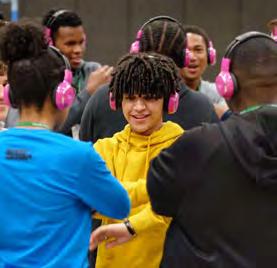
Reduced barriers and something for everyone
A parks system should be inclusive and relevant to meet residents where they are at. Park professionals should strive for every member of every community to have access to the many great benefits that these systems have to offer. Many parks agencies are trying to remove barriers to inclusivity and often work with other city agencies to make changes possible. Prioritizing park amenities adjacent to or inside affordable housing complexes and creating different ways to get to parks are just a few ways cities support people of all ages, income levels, and abilities.
There are many ways Raleigh Parks works to reduce barriers within its park system. Integrating universal design in parks and facilities is a key way to make sure everyone can use them; Raleigh Parks is striving to incorporate universal design principles into new and ongoing projects. Raleigh Parks is also focused on financial support, and new financial assistance

policies like those in the User Fee Policy can help more people access programs. Raleigh Parks can also offer more language support in their design and programming for people who speak a language other than English. Finally, while many barriers are about physical infrastructure or policies, the culture within departments can also create barriers. Nurturing a culture of collaboration and belonging within the organization itself can lead to more inclusive programming.
Relevant Achievement
Last year, Raleigh gave scholarships to 1,200 individuals through the financial assistance program - more than double the number given out by similarly-sized peer agencies.
Current Challenge
In the last ten years, portions of Raleigh have seen an increase in immigration from other countries and cultures, expanding the diversity of users and needs.
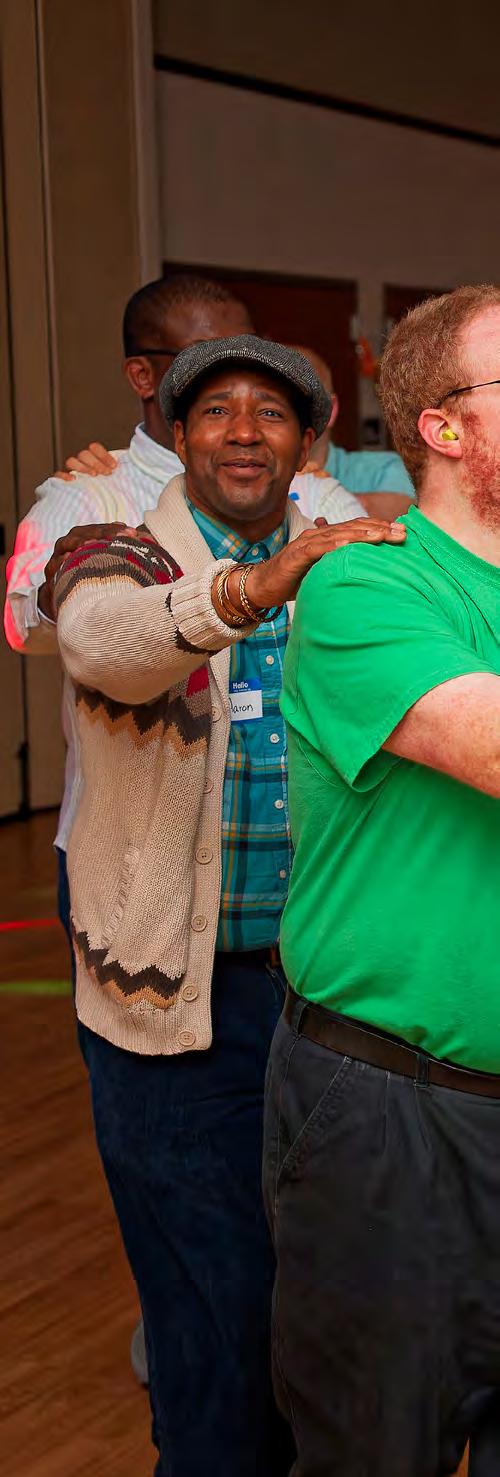
System Deep Dive
AN EQUITABLE USER FEE POLICY
To support the wide range of experiences it offers, Raleigh Parks invests in keeping spaces and activities clean, safe, and fun. A user fee policy acknowledges that users might need to pay for some of the more cost-intensive places or programs. User fees help the department generate revenue to keep up with operation and maintenance expenses and ensure quality service offerings. Here are a few examples of user fees in Raleigh’s fee policy today:
• Joining a basketball league requires a registration fee.
• Using the community pool requires an entry fee.
• Renting a pavilion or getting a permit for an event in a park for a family picnic or community event comes with a rental fee. These fees are important because they help Raleigh Parks continue to provide high-quality services and facilities without relying solely on tax money. A key part of the Parks Plan Update involved a study of Raleigh Parks’ User Fee Policy. The User Fee Policy outlines how much Raleigh Parks should charge for its many programs and services, with a focus on fee policy changes that support equitable access and the removal of financial barriers to low-income families.
The process to update the User Fee Policy involved multiple steps. The study looked at how much money comes in from fees for activities, programs, and services and how much it costs to offer them. It examined how Raleigh Parks sets prices and helps people pay for services through their financial assistance program. It also evaluated the department’s own goals for cost recovery; that is, how the department weighs the type of activity offered, the associated benefits to the community, and the revenue needed to
provide that activity. All of this study led to a complete picture of Raleigh Parks’ current model, its forward-looking decision-making criteria, and ultimately a series of recommendations to make updates to the User Fee Policy.
TAKEAWAYS FROM THE USER FEE POLICY
Continue evolving fees and pricing where the impacts are greatest.
Prices for services should be set based on how much they help the community. For example, services that provide a large community benefit, like youth or active adult programs, could have fees that are lower than market rate. But for services that mostly benefit individuals, like adult sports leagues, Raleigh Parks could charge more to increase departmental revenue to support other programs and services.
Recalibrate how and where Raleigh Parks charges fees.
setting fees, consideration should be given to non-financial factors like giving local residents priority, competition, similar services nearby, and how visible the service is to the community.
Remove financial barriers to participating in programs.
Raleigh Parks’ core values prioritize providing many services regardless of the user’s ability to pay. The department can continue improving the approach to the “ability-to-pay” policy and clearly define how it applies to each type of service evaluated in the updated cost recovery policy. Together with this policy, Raleigh Parks can expand financial assistance by developing a financial assistance program funding plan.
Refine and clarify approach and roles related to special events.
Raleigh Parks plays different roles in supporting a wide array of special events. There is room to clarify, for the department, the event host(s), and the users alike, the steps and important decisions needed to manage and approve rentals and events. The department can also include consideration of wear and tear on park spaces and facilities in setting its special event fees. #1
User fee policies do need to be revisited as user trends and markets change. Today, there is opportunity to increase fees for park rentals and for certain activities, programs, and services that have the potential to generate more revenue. When
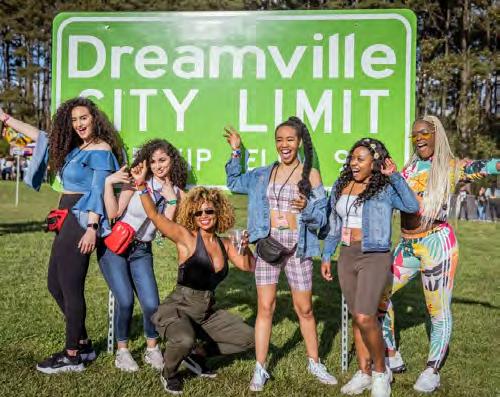

Community Cohesion HEALTH OUTCOMES
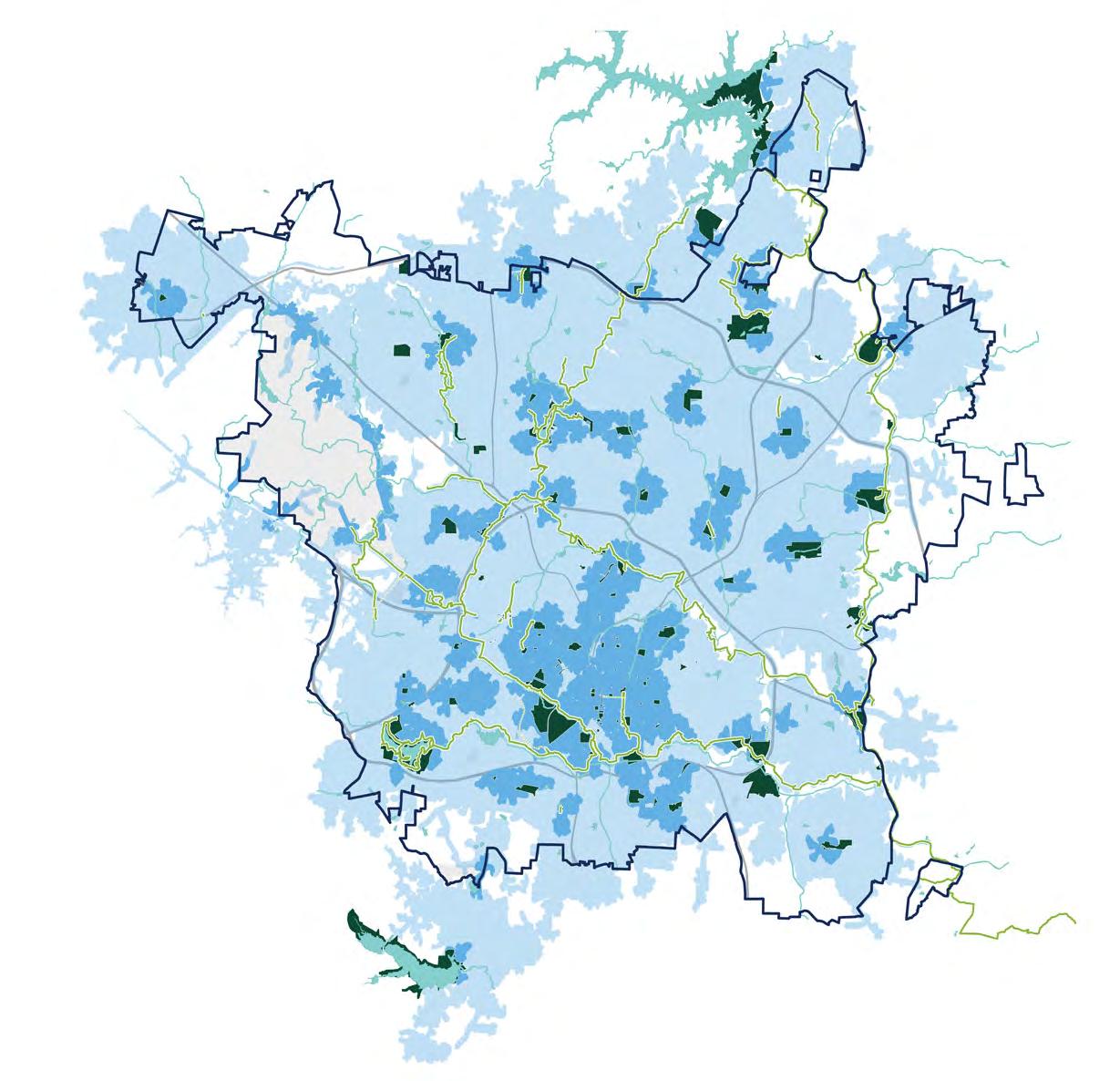
Community Cohesion Park Experience
Raleigh-owned Parks
Other Open Space
Core Experience (10-min walk)
Neighborhood Experience (5-min drive)
Greenways
In the unique tapestry of Raleigh’s neighborhoods and communities, parks emerge as important informal spaces that foster a sense of belonging, forge stronger relationships, and catalyze economic growth. These places not only bring people together but also enhance physical and mental wellbeing, connecting individuals to their surroundings and instilling a sense of stewardship toward their communities.
The unique character of each community is mirrored in its parks, which can adapt to community changes and evolving needs. By
9 Treskon et al., A Framework for Assessing Equitable Health Outcomes of Parks, Urban Institute, 2022.
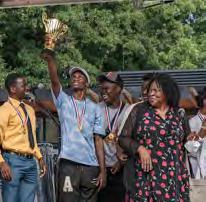

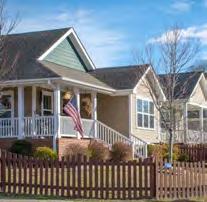

committing to park reinvestments and new programs that support the many cultures, languages, and histories that make Raleigh such a desirable place to live and work, these centers and spaces can embrace a piece of the Raleigh Parks’ vision. This is true now more than ever. Since 2014, Raleigh has emerged as one of the fastest growing communities in the country. While numerous studies have highlighted the individual health benefits of parks, rarely does this research cover the impacts of a park, facility, trail, art, or program on an entire community.9
Belonging
A sense of community identity and belonging
Relationships
Strong relationships with communities
Development
Balanced growth and a robust local economy
Connectivity
Connections between people, places and communities

The Community Cohesion lens holds the potential to bridge these gaps, fostering a sense of belonging, strengthening social bonds, and driving economic growth in diverse communities. It is important that every resident, regardless of their background, has access to quality green spaces where they can enjoy recreation, relaxation, and meaningful social connections.
Within this lens, there are four health outcomes that function to enable Raleigh Parks to welcome and support the recent growth and diversity of the many communities that make the city special.
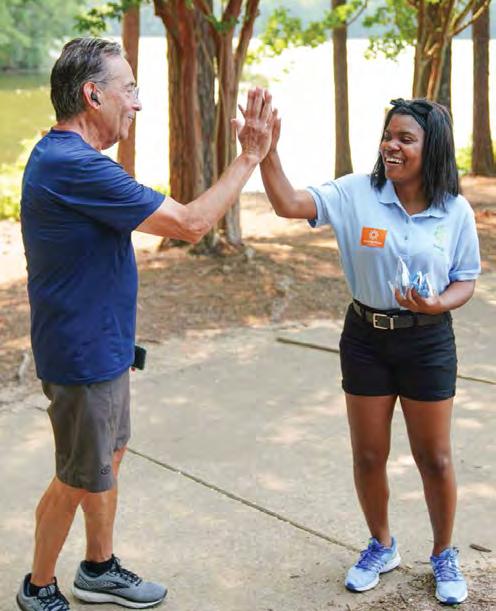

COMMUNITY COHESION
Belonging
ENGAGEMENT FEEDBACK
“Community & Belonging” emerged as a top value during the Listen & Learn phase of engagement.

A sense of community identity and belonging
Feeling a sense of belonging fosters community connections, supports mental and physical wellbeing, encourages stewardship, and enhances overall enjoyment and use of spaces. Inclusive environments are where everyone feels welcomed, valued, and engaged. If community members feel that they belong, whether it be in a physical space, at an event, or within an activity, they will develop relationships with the people, spaces, and experiences that they, in turn, share with their friends, neighbors, and families. This expands the impact of those spaces and experiences more broadly. In the long term, community belonging results in cities that feel more alive and authentic, which generates greater trust and engagement among the public.
Raleigh’s park system provides many opportunities for social expression and can be a platform for community storytelling. At the start of the community engagement process, participants highlighted community and belonging as the number one value that they would like to see Raleigh Parks prioritize over the next five to ten years. From better equipping facilities to be more reflective of neighboring communities and the services they want, to ensuring community
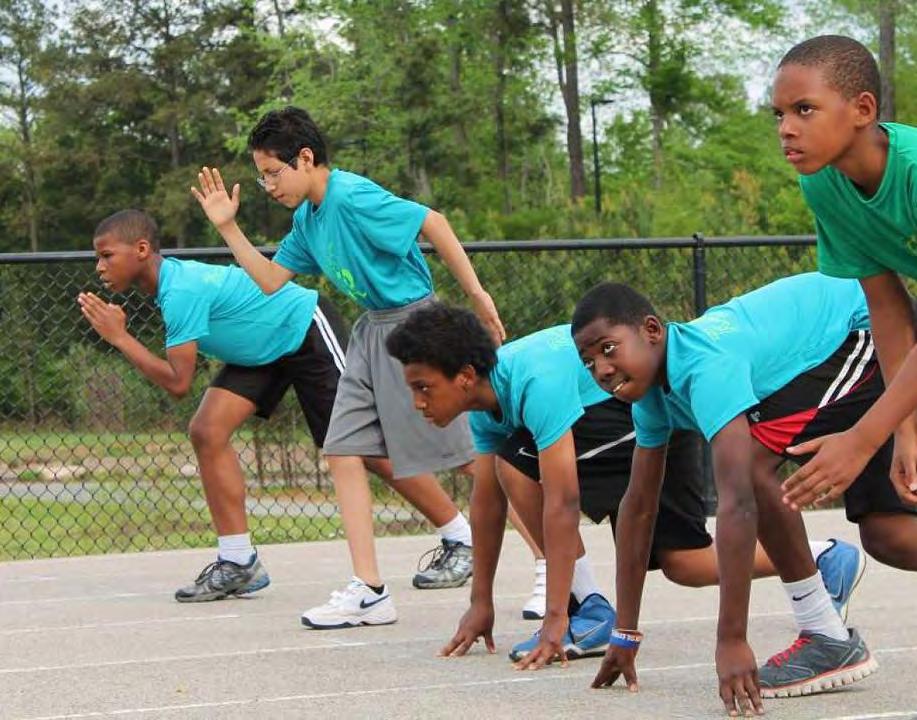
center staff have what they need to best to serve their communities, to interpreting and sharing the history of a neighborhood, Raleigh Parks can lead the way in creating places that foster belonging for generations to come.
There are a few examples of how Raleigh Parks can work to achieve this outcome. Raleigh can continue to expand their Welcome to Raleigh Parks program to foster belonging with underresourced groups. They can also commit to continuing to provide spaces that support all community members. As an example that was highlighted as a priority action item from the 2014 Parks System Plan, Raleigh Parks can work to identify and evaluate gaps in offerings and facilities for active adults and commit to implementing new projects, such as the proposed Spanish Speaking Senior Club.
Relevant Achievement
Raleigh Parks regularly partners with local organizations to amplify community stories and celebrations through events like Juneteenth Celebration and Dia de Oakwood.
Current Challenge
Staff highlighted that several community centers and facilities lack the needed infrastructure to host special events and programs.
COMMUNITY COHESION
Relationships
ENGAGEMENT FEEDBACK
“Maintaining parks and community centers offers places to gather for both recreational purposes and for formal meetings for community and City groups.”
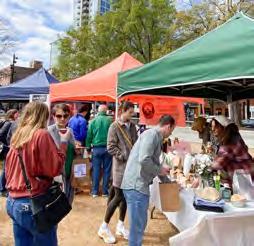
- Online survey participant
Strong relationships with communities
Community center staff are often the friendly face that people who participate in Raleigh Parks programs and events see when they enter the door or leave after a class or child pickup. As Raleigh Parks’ frontline staff, they naturally build relationships with community members and have the best sense of community needs, worries, and dreams for their park system. This Community Cohesion lens focuses on the relationships between community members and Raleigh Parks.
For engagement to be truly transformational, staff have a key role to play in showing up consistently to the community, responding to needs as they arise, and being a stable source of support. To further support staff in this practice, Raleigh Parks can continue the Recreation Roundtable Program, which helps guide staff on how to respond to crisis situations and how to connect people to vital services.
Committing to regular and thoughtful community engagement is another important method to ensure relationship building with communities. Community engagement processes can oftentimes become transactional and quickly

become focused on a means to an end rather than a long-term sustained relationship. One way Raleigh is overcoming this potential barrier through its Community Connector Program, an initiative to work closely with trusted voices in the community for ongoing community engagement support. Additionally, Raleigh Parks can also continue to form partnerships with trusted organizations in order to reach communities that may not be well represented in city processes.
Inclusive outreach, communication and partnerships are a strong start. It is further enacted through planning and design processes where Raleigh Parks staff follow the Public Participation Playbook to ensure ongoing community engagement.
Raleigh Arts, for instance, builds relationships with communities though engagement. The community is welcomed to present ideas for public art works, to collaborate with artists on ongoing works, and to participate in the various planning processes related to public art. The inclusion of the public strengthens relationships between the artist, artwork, and community.
Relevant Achievement
The “Better With A Buddy” Campaign promotes greenway safety and encourages people to visit with a friend, which reduces feelings of insecurity when on greenways.
Current Challenge
Keeping up with demographic changes and their impact on community outreach methods is an ongoing challenge.
COMMUNITY COHESION Development
ENGAGEMENT FEEDBACK
“Add vendors (food and drink) to parks and playgrounds!”
- Focused conversation participant
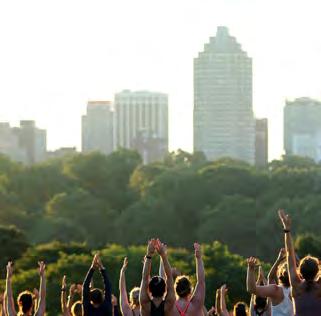
Balanced growth and a robust local economy
There are many ways that parks can be powerful vehicles for economic development. Parks can provide jobs, coordinate with new housing development, host special events that bring visitors from all over, and support local businesses. In 2021, local park and recreation agencies in the United States generated more than $201 billion in economic activity and supported more than 1.1 million jobs.10
To work toward this outcome, Raleigh Parks can continue to work with the Housing and Neighborhoods Department to co-develop community serving facilities alongside new housing development. They can also continue to adopt citywide policies to advance the development of parks, greenways, and recreation opportunities in coordination with private-sector partners. Additionally, Raleigh Parks can expand
10 The Economic Impact of Local Parks, National Recreation and Park Association (NRPA), 2021.
partnerships with local and state professional sports teams to continue attracting tourism, including building on programs, such as NFL Play60 in partnership with the Carolina Panthers. In order to remain committed to supporting women and minority-owned enterprises, Raleigh Parks can collaborate with the City’s Minority and Women-Owned Business Enterprise (MWBE) Program and strengthen outreach and training efforts for MWBE businesses.
Relevant Achievement
With the Swing Racquet + Paddle sports complex partnership project, significant positive impact is expected on local sportstourism.
Current Challenge
The 2022 Raleigh Community Survey highlighted the local economy, efforts to promote small, minority, & women-led businesses, and innovation as the top issues for Raleigh to face.
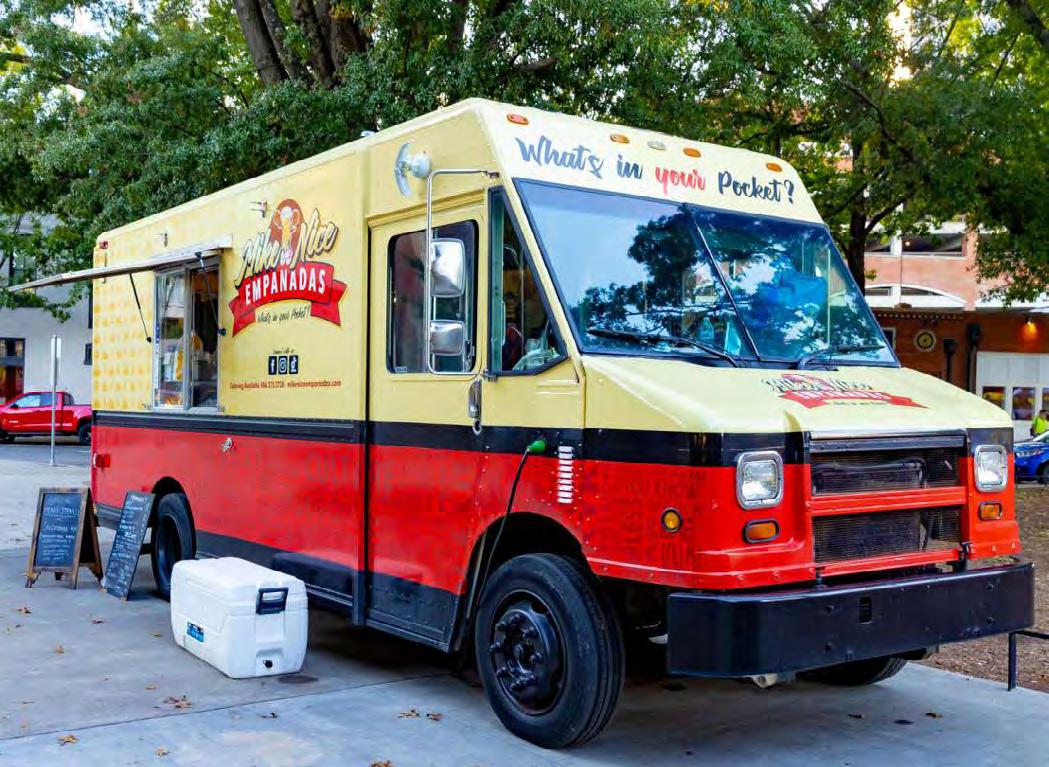
COMMUNITY COHESION
Connectivity
ENGAGEMENT
FEEDBACK
“We need to focus on preserving and telling the stories of diverse communities, especially highlighting African American landmarks.”

- Focused conversation participant
Connections between people, places, and communities
Greater amounts of high-quality physical connectivity provide more opportunities for social connections among community members. Safe, walkable sidewalks and greenway trails connect between homes and important community destinations. Residents get to know their neighbors at a nearby playground, make new friends who attend the same weekly recreation program, or engage in dialogue and mutual learning at a cultural arts event.
These physical and social connections are more important now than ever. A 2018 study highlighted how nearly half of Americans report sometimes or always feeling alone or left out, lacking meaningful social interactions on a daily basis. Lower-income adults are more likely to be lonely than those with higher incomes. Sixty-three percent of adults who earn less than $50,000 per year are considered lonely, which
11 CIGNA 2018 U.S. Loneliness Index, The Cigna Group, 2018. The Loneliness Epidemic Persists: A Post-Pandemic Look at the State of Loneliness among U.S. Adults, The Cigna Group, 2021.

is ten percentage points higher than those who earn more than $50,000 per year. 11
Raleigh Parks can be the heartbeat of the Raleigh community by creating places and programs that foster connections between people, places, and communities, improving societal health. As an example, the Neighborhood and Community Connections Program is an effort to identify, prioritize, and build new walkable connections to parks and greenways. Within this program, Raleigh Parks uses data to guide investment in those communities which are most at-risk of negative health outcomes and most in need of improved access to outdoor recreation opportunities.
Relevant Achievement
Each year, Raleigh Parks celebrates and honors the backgrounds and experiences of Raleigh’s newest neighbors through their World Refugee Day Celebration.
Current Challenge
As Raleigh continues to increase the number of greenways and connections, the need for continued maintenance is vital to ensuring equitable access and quality.

System Plan Deep Dive
RALEIGH PARKS PROGRAMMING ASSESSMENT
To respond to changing community needs and to keep up with trends, the Parks Plan Update evaluated Raleigh’s programs, including a review of the types of programs Raleigh Parks offers and a series of staff conversations about the staffing and facilitates that make programs successful. Additionally, the Programming Assessment analyzed local and national demographic trends and conducted benchmarking with other communities. Using this evaluation, the plan identified ways to recalibrate the City’s program offerings and opportunities to streamline the delivery of programs and events.
Staff engagement guided better understanding of how Raleigh Parks’ programs are serving the community. During the study, a survey for fulltime programming staff was sent out for staff to complete. As a follow up, a series of virtual focus groups were held with programming staff. This feedback was important for learning more about the process for leading programs and where improvements can be made.
Understanding what has changed since the 2014 Parks System Plan was an important part of the Raleigh Parks Programming Assessment. Program data from 2014, 2019, and 2023 was organized and analyzed to provide a clear picture on what has changed over this time period. Key items that were analyzed included the total number of programs that Raleigh Parks offers, the types of programs offered, the types of programs that people sign up for most, how much money different programs make, and waitlists of different types of programs. Communities served, based on age group, were also analyzed to understand differences.
Another key part of this study included a review of how recreation programs are currently evaluated. After a Raleigh Parks program is completed, it is important to receive feedback from program participants to understand what participants liked and what could have been better. This feedback is useful information for making improvements to recreation programs in the future.
PARKS PROGRAMMING ASSESSMENT
BIG IDEAS
The COVID-19 pandemic has changed program participation.
#1
Since 2020, the number of programs for preschool kids and teens have decreased by twenty-five and fifty-four percent, respectively. The number of youth and senior programs peaked in 2019 and have since decreased. Seniors have been more cautious about participating in group activities since the COVID-19 pandemic hit.
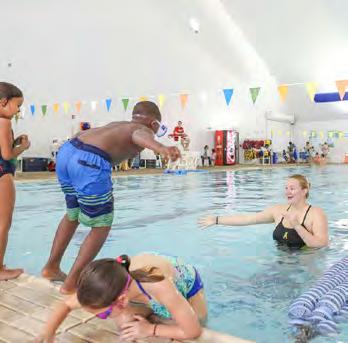
#3 #2
Raleigh residents are leaning into health and arts!
Health and Wellness programs continue to be the most popular programs offered by Raleigh Parks, with over 14,000 enrollments, and Arts programs are growing steadily in popularity, with over 6,400 enrollments.
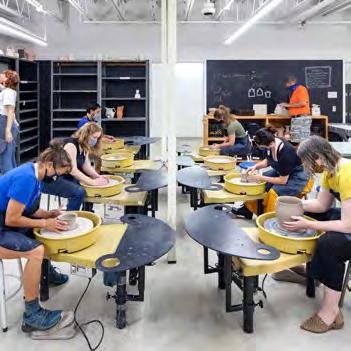
For staff, quality is paramount.
The staff who provide programs are a passionate, knowledgeable group of professionals who feel a strong sense of connection to the field of parks and recreation and to Raleigh Parks. A common theme among staff conversations was a desire to provide the best quality programs to residents, over a large number or mix of programs.
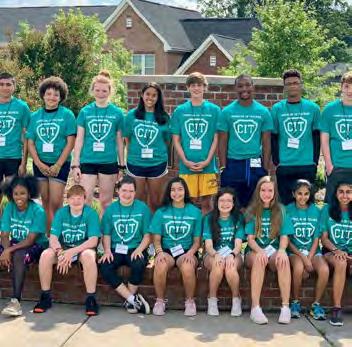
Environmental Resilience
HEALTH OUTCOMES
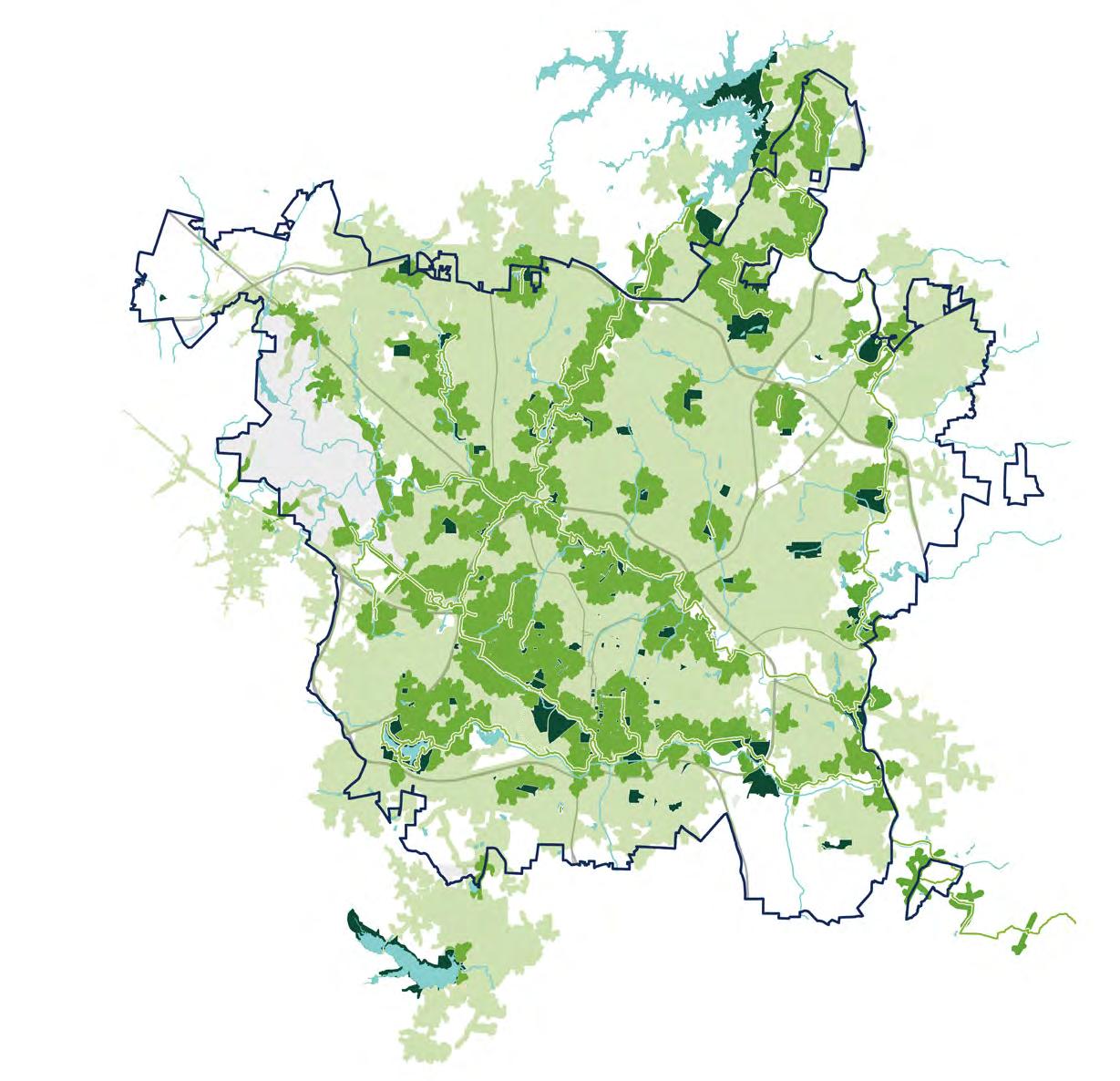
Environmental Resilience Park Experience
Raleigh-owned Parks
Other Open Space
Core Experience (10-min walk)
Neighborhood Experience (5-min drive)
Greenways
Raleigh is often referred to as the “The City of Oaks,” acknowledging its role as a trailblazer in environmental stewardship. Early on, Raleigh recognized the irreplaceable value of parks, forests, waterways, and interconnected natural spaces. Today, there is a greater emphasis on how these green spaces also provide environmental resilience and perform essential ecological functions critical to urban health. Large, undeveloped natural areas and continuous greenway corridors play an important role in managing and protecting the environment, serving as the lungs and lifelines of the city. Parks and greenways are vital to preserving urban land and nature, and they reflect the health of a city. Parks help control stormwater by providing permeable surfaces to reduce and redirect it, which lessens the pressure on the city’s drainage systems. They also fight the “heat island” effect by lowering temperatures compared to nearby paved areas, offering cool spots in hot urban areas. Through ecosystem services like purifying the air, removing carbon dioxide and pollutants, protecting habitat, stabilizing soils, and cleaning water, parks offer
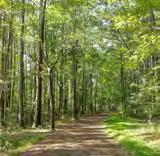

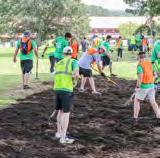

many environmental health benefits. These improvements can lead to better public health, such as lowering asthma rates by improving air quality.
People who support parks play a key role in promoting sustainable land use and development for everyone to enjoy. By backing city projects, people actively conserve land, water, and natural resources while strengthening environmental health and well-being. Parks and greenways also bring together different generations and social groups by providing educational opportunities, connecting people of all ages with nature, and coordinating environmental efforts between public and nonprofit groups. Protecting the habitats and pathways within parks ensures healthy ecosystems now and in the future.
Within this health lens, four key outcomes can help Raleigh expand its focus on environmental care across its parks, open spaces, nature preserves, greenways, natural resources, and facilities. These outcomes ensure a healthier, stronger urban environment for all.
Ecology
A sustainable, resilient, citywide ecological framework
Sites & Facilities
Best design, management, and operational practices in all sites and facilities
Stewardship
A community of active and passionate stewards
Protection
Sensitive habitats and corridors are protected
ENGAGEMENT FEEDBACK
“We need to preserve as much tree canopy as possible since we have a climate crisis. Trees clean the air and water and keep cities cool.”
- Online survey participant
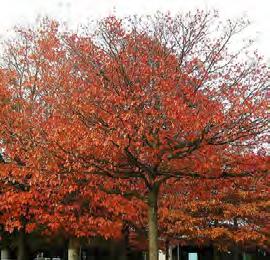
A sustainable, resilient, citywide ecological framework
In the past decade, Wake County has lost more than 11,000 acres of tree canopy, and tree loss was especially acute in the northeastern and southeastern parts of Raleigh, where growth and development are widespread. In 2023, Raleigh faced sixty-six days over ninety degrees12 which is notable because of the connection between tree canopy loss and increased temperatures. On the hottest days in cities, people living in areas with few trees, little green space, or lots of paved surfaces can experience up to a 20 degree difference in temperature from communities in shadier, less paved areas.13
The world is also facing a biodiversity crisis. Climate change and the influence of people (through pollution, development, and more) are causing significant loss and decline in plants and animal species. Wake County is home to more unique native species than almost anywhere else in the country.14 Our parks and nature preserves are key to protecting that diversity.
12 Raleigh-Durham Airport Temperature Records, National Weather Service.
13 Mapping Urban Heat Islands, RaleighNC.
14 Natural Resources Inventory Database, Wake County Gov.
Like many cities around the nation grappling with similar climate-related changes and impacts, Raleigh aspires to greater environmental resilience. Resilience is the ability of a system to absorb unexpected events and bounce back quickly. “Resilience thinking” embraces the idea that human and natural systems are complex and continually changing. It advocates for a process of understanding the components of a system and developing strategies to maintain them in order to achieve sustainability. Environmental resilience is advanced through investments in biodiversity, healthy soils, clean air, and nature-based or green infrastructure. Raleigh Parks system’s extensive acreage, expertise in natural resource management and diversity of resources positions it as a key driver in environmental resilience for the City. Raleigh’s parks, open spaces, nature preserves, and greenways offer myriad opportunities to improve environmental resilience. Its extensive greenway system buffers and protects the City’s waterways. As a connected and thriving ecological framework, the greenways also provide many other benefits, such as improved air and water quality, heat mitigation, flood risk reduction, and a diverse and healthy tree canopy. Importantly, greenways are ecological corridors that also allow animals to move between larger areas of habitat. Raleigh Parks can amplify these many benefits by increasing greenway easement dedication and acquisition, continuing to grow this already robust ecological framework.
Raleigh’s parks and nature preserves also play a major role in managing and supporting the ecological health of the city. Programs and experiences increase public awareness of the diversity of living things in our parks and ways to help preserve biodiversity. Continued, focused investments in urban ecology can also help to advance the goal of environmental resilience. For example, Raleigh Parks can continue to improve the city’s urban forest through the Street Tree Equity Program, which seeks to reduce environmental inequities across Raleigh by planting street trees in neighborhoods that are
severely lacking tree canopy. Another example, highlighted as a high-priority action item in the 2014 Parks System Plan, Raleigh Parks can work to increase environmental protections of its open space by identifying priority natural resource lands that are opportunities for acquisition or partnered development.
Relevant Achievement
Through the Street Tree Equity Project, 350 street trees were planted in front of churches, schools, and parks in its first year. Now, over 1000 have been planted.
Current Challenge
In Raleigh, street trees are inequitably distributed based on a 2020 assessment of tree survey data and social vulnerability factors.
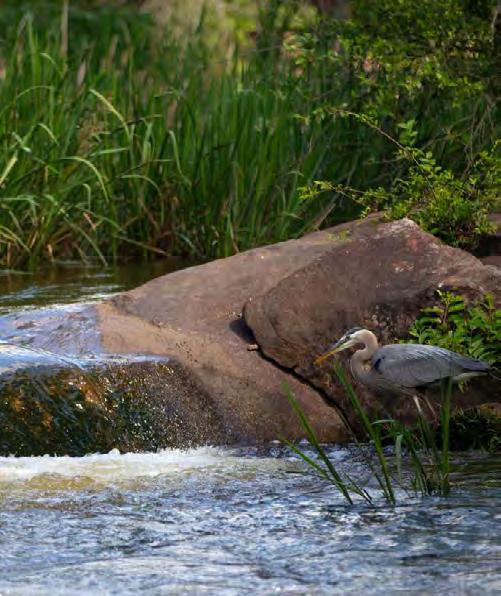
ENVIRONMENTAL RESILIENCE
Sites & Facilities
ENGAGEMENT FEEDBACK
“More sustainable features in parks: solar, community gardens, converting grass to pollinator habitat, EV chargers, native plants, community compost drop off, EV landscaping equipment, climate resilient education for the community.”
- Online survey participant
Best design, management, and operational practices in all sites and facilities
Key to environmental sustainability is a commitment to planning, design, and operational practices that prioritize environmental health. These include a wide variety of tactics across the lifespan of sites and facilities - from stormwater management, to design guidelines and pre-development design processes, to invasive species management, to energy efficiency, and more!
Water is both a precious resource and a challenge for sites and facilities within the city. As an opportunity, there are many ecological benefits of green infrastructure and economic wins associated with water-efficient buildings. Separately, as a challenge, the years from 2015 to 2018 had the greatest number of flood events in North Carolina since 1900.15 One example of
15 Raleigh Community Action Climate Plan, Raleigh, NC, 2024.
how Raleigh Parks can continue its work to better manage water resources is by coordinating with the Stormwater Management Advisory Commission and the Engineering Services Stormwater Program on green infrastructure practices within parks and greenways to absorb, filter, and slow down stormwater. These existing partnerships are collaborative and effective, providing a foundation for increased shared staffing, innovation, and expertise on mutuallybeneficial stormwater investments.
Raleigh Parks can continue to prioritize PreDevelopment Assessment Plans (PDAP) to proactively protect resources. The intent of a PDAP is to document existing conditions and natural resources and recommend potential interim actions for an undeveloped park property once it has been acquired. This process provides a roadmap for sites to be developed in ways appropriate to their unique opportunities and constraints.
Beyond green building standards and accolade programs, such as Leadership in Energy and
Environmental Design (LEED), WELL Certification, Healthy Buildings, and SITES v2 Rating System for landscape design projects, there are numerous new and tried-and-true green technologies for both retrofits and new construction of facilities. These include energy and water efficient fixtures, solar power, reflective roof systems, and improved insulation. Raleigh Parks currently uses many of these programs and practices as guidance while also adapting them to best fit the particular challenges, opportunities, and budgets of projects.
Relevant Achievement
Raleigh Parks is working toward 80% electrification of all small equipment, including mowers, by 2026.
Current Challenge
Despite Raleigh coordinating stormwater management related to new development, sediment runoff over recent decades has still been significant.

ENVIRONMENTAL RESILIENCE
Stewardship
ENGAGEMENT FEEDBACK
“I’d love more nature classes like gardening and native plant identification to learn more about my community.”
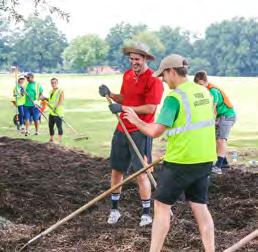
- Focused conversation participant
A community of active and passionate stewards
Cultivating environmental stewardship is important for any city that values its system of parks and green spaces, and parks departments can lead the charge of stewardship across other city departments. When community members have greater ownership and responsibility for the care of these spaces, everyone benefits. Raleigh Parks offers numerous ways to encourage greater stewardship including through education, volunteer opportunities, modeling effective stewardship practices, and engaging the public through interpretive signage and community science.
Early and repeated exposure to the natural world through education and hands-on experience is one of the best means to fostering a sense of stewardship. Increasing awareness and knowledge of the natural world and human role in it, combined with meaningful experiences, can inspire change and informed decisionmaking, ultimately moving individuals toward becoming better stewards of the earth. Raleigh
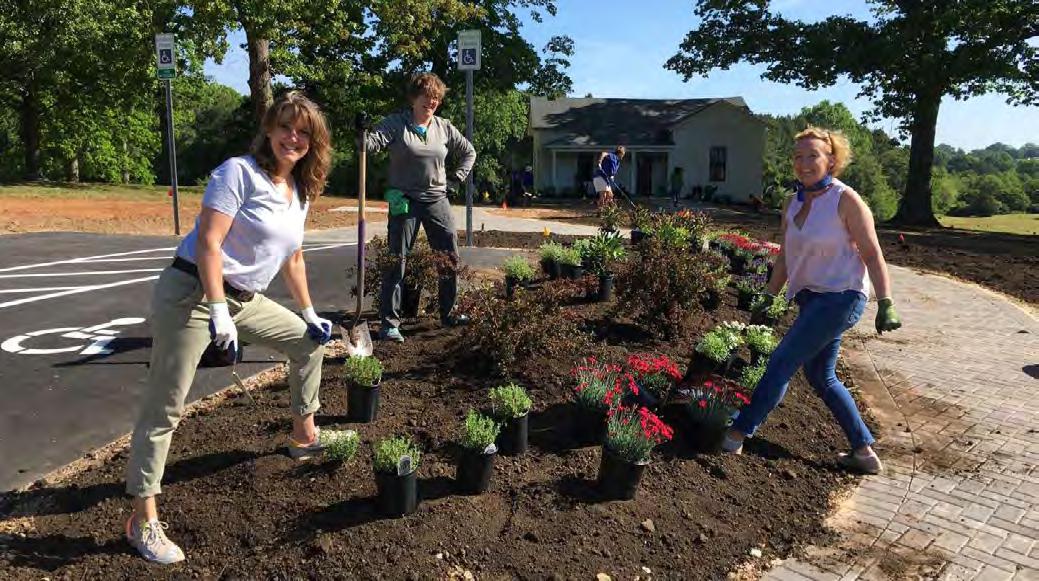
Parks offers environmental education programs provided for school students at Raleigh Parks and Preserves and on school campuses, as well as through summer camps, public programs, extended term programs, and events. Providing programming that encourages participants to discover and connect with our natural world ultimately leads to environmental literacy and stewardship. Interpretive signage and experiences in parks and along trails can share information with the public about environmental systems, native species, and more.
On-the-ground conservation work includes numerous ongoing initiatives like the use of prescribed fire and the planting of native species. Initiatives such as these provide opportunities for public education and volunteer engagement. Volunteers also contribute to environmental stewardship projects ranging from invasive species removal, mulching, planting, and citizen science opportunities.
Raleigh Parks can achieve this outcome through continued intentional programming, interpretive trails and signage, and meaningful
community engagement. One example of this is the Interpretive Poetry Trail at Lake Johnson Park which features the work of ten local poets and celebrates the unique natural features of the park. As another example, Raleigh Parks can continue to promote the Adopt-a-Trail Program to encourage community responsibility for the environment through scheduled litter cleanups throughout the year.
Relevant Achievement
In Fiscal Year 2024, approximately 65,000 total volunteer hours were contributed to Raleigh Parks. Of those, 15,546 hours were focused on environmental stewardship projects, with service valued at close to $500,000.
Current Challenge
Community members stated most volunteer efforts seemed limited to weekdays. However, increasing awareness of unstaffed litter cleanups and other opportunities could help boost participation.
ENVIRONMENTAL RESILIENCE Protection
ENGAGEMENT FEEDBACK
“Better protection and stewardship of native plant communities, including more access to natural areas in underserved parts of the city.”
- Online survey participant
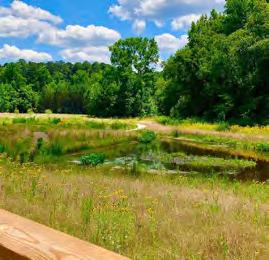
Sensitive habitats and corridors are protected
Through strategic conservation of natural resources, Raleigh Parks works hard to identify and protect sensitive habitats and green corridors. Sensitive habitats are areas where rare plant and animal life are present or where the habitat present makes a unique contribution to the diversity of the broader ecosystem. Sensitive habitats are easily disturbed by human activities. The protection of sensitive habitats and corridors has a positive effect on a larger region’s environmental health for generations.
Raleigh Parks has a proven track record of innovative conservation work. Projects and protocols such as prescribed burning, invasive species removal, Pre-Development Assessment Planning, habitat and species mapping, and wetland and riparian buffer restoration demonstrate commitment to the protection of biodiversity. Embracing new opportunities by participating in programs like Bee City USA and the Biophilic Cities Network (as described in the
following System Deep Dive) helps demonstrate how the 2014 Parks System Plan advanced the conversation around environmental protection. Raleigh Parks can continue to use strategic tools to protect sensitive and unique habitats, including land acquisition, use of conservation easements, dedication of additional Nature Preserves, and implementation of Protected Natural Areas designations. The conservation work being done in Raleigh Parks can be used to help prioritize investments in land stewardship, as well as to inform on best environmental practices for future development.
Invasive species continue to impact the Triangle region, threatening native plants and crucial local ecosystems. Raleigh Parks’ Invasive Species Program plays a key role in fighting against these plants and pests. This program helps prioritize, fund, and manage invasive species, along with providing public education on the issue.
Raleigh Parks can continue its work toward environmental protection through natural resource management practices. A high-priority action item from the 2014 Parks System Plan, Raleigh Parks works to research, establish, and operationalize best management practice standards for specific ecosystems within the parks system that balance protection and recreation within natural areas.
Relevant Achievement
Raleigh Parks created its Invasive Species Program to respond to the amount of invasive species that were growing in neighborhood parks.
Current Challenge
Recent national and state-wide legislation limited protections for wetlands that improve water quality, lower flood risk, and protect aquatic wildlife.
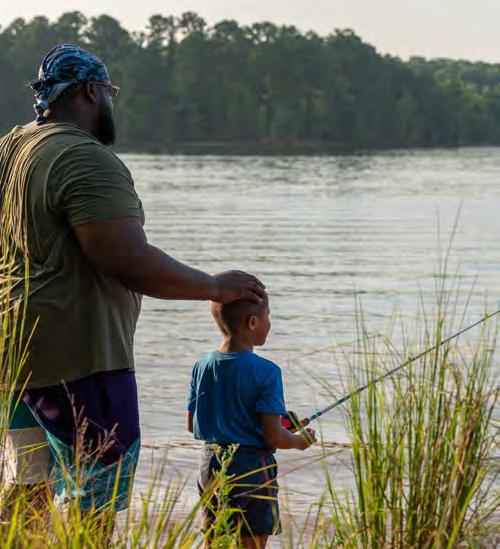

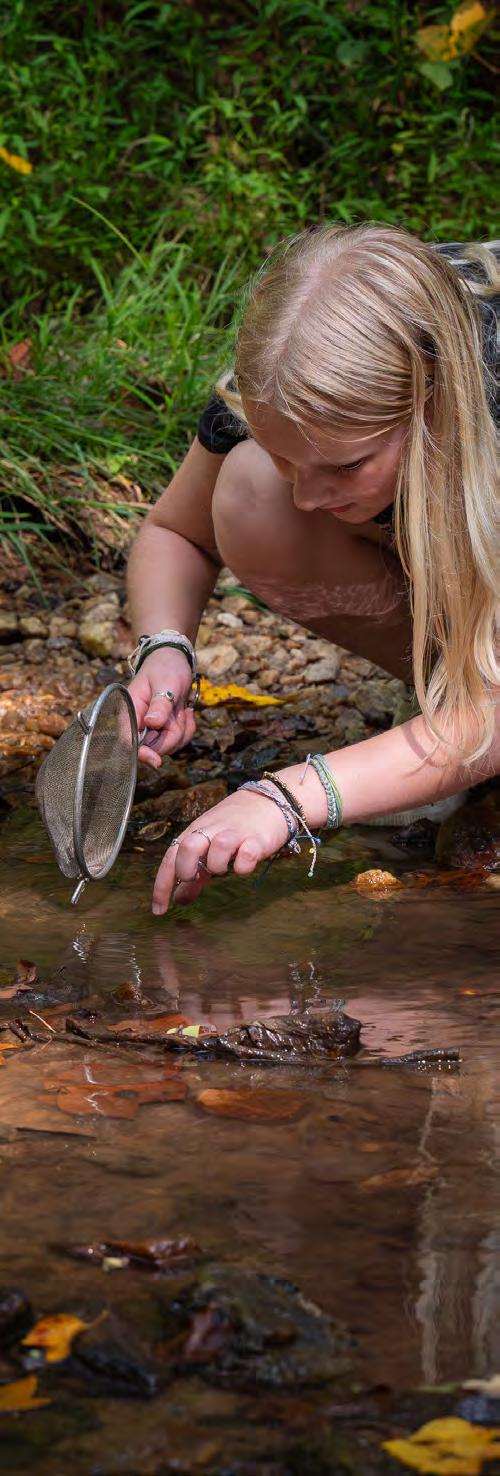
System Plan Deep Dive
WALKING THE WALK ON ENVIRONMENTAL RESILIENCE
More than 200 years ago, the Christmas Plan of 1792 shaped the City of Raleigh. This important plan identified a system of public squares that are still visible today, like Nash Square and Moore Square. The plan and the connected green spaces that it created highlight Raleigh’s longstanding commitment to fresh air, open space, and healthy trees. The 2014 Parks System Plan continued this legacy by setting new goals to protect natural resources; Raleigh Parks has worked hard to achieve this ambitious framework through several key initiatives, described below.
BIOPHILIC CITY
The word biophilia is made up of two Greek words: bio meaning “life” and philia meaning “love of.” Together, it represents a love of life or living things and a belief that humans have deep and meaningful connections to nature. According to the Biophilic Cities Network, biophilic design is a movement to foster deeper connections between people and nature by integrating natural elements into urban environments. This design philosophy advocates for the harmonious blending of natural patterns, processes, and elements such as plants, water features, and natural lighting into designed places.
Launched in 2013, the Biophilic Cities Network is a global community of partner cities, organizations, and individuals committed to planning and designing cities according to the principles of biophilic design. The network includes cities from Austin to Barcelona and from Norfolk to Singapore, each dedicated to deepening the
connection to nature for its residents and, by doing so, improving the sustainability, health, and wellness of city spaces for all.
In 2022, Raleigh became North Carolina’s first city to join the Biophilic Cities Network. Demonstrating its commitment to innovation in environmental health and climate change adaptation, Raleigh’s role in the network will allow it access to valuable resources, knowledge sharing, and emerging best practices. It also signifies - to the city, the state, and the nation - a new era of environmental design that will no doubt give shape to new experiences with Raleigh’s parks and greenways.
BEE CITY USA
Across the nation, communities are identifying an alarming reduction in the number of pollinators. Pollinators are any species of insect or animal, including bees, birds, and butterflies, that move pollen between the male and female parts of flowers, enabling the fertilization and perpetuation of the plant species. Pollinators are essential to the preservation of healthy ecosystems, and perhaps most importantly, to the production of our food supply. One out of every three bites of food we eat is made possible by pollinators!
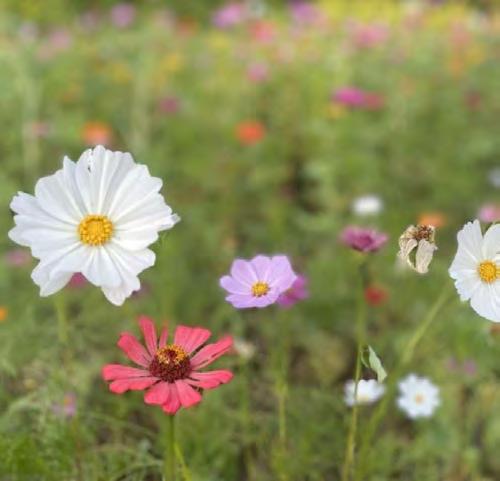
Raleigh Parks has long recognized the value and necessity of pollinators for exactly these reasons and has enacted its commitment by supporting pollinator habitat programs, projects, and partnerships. It also is committed to raising awareness of the value of pollinator species through programming about the pollinator species and inspiring residents to participate in the cultivation and preservation of plantings that sustain pollinators.
In 2017, Raleigh Parks took this commitment to a new level by becoming a Bee City USA. Bee City USA is a program that recognizes, supports, and encourages pollinator conservation by working with over 300 communities in over 40 states across the nation. Built on a collaboration between the City and community partners, the initiative focuses on educating the public and providing support for pollinators and habitats in Raleigh. The early accomplishments of this program are numerous, including a five-acre sunflower field created at Dix Park in 2018 and five acres of wildflowers planted along greenway trails and parks in 2024. Raleigh Parks also promotes environmentally sensitive pest and vegetation management via integrated pest management that reduces overall pesticide use. Further, Raleigh Parks makes visible this commitment every year in June with programming and projects during its popular Pollinator Week.
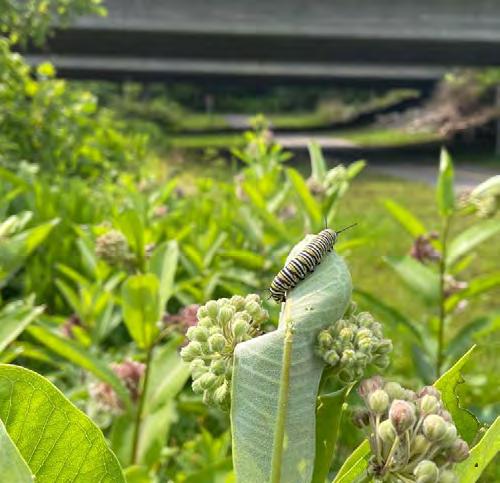
Organizational Commitment
HEALTH OUTCOMES
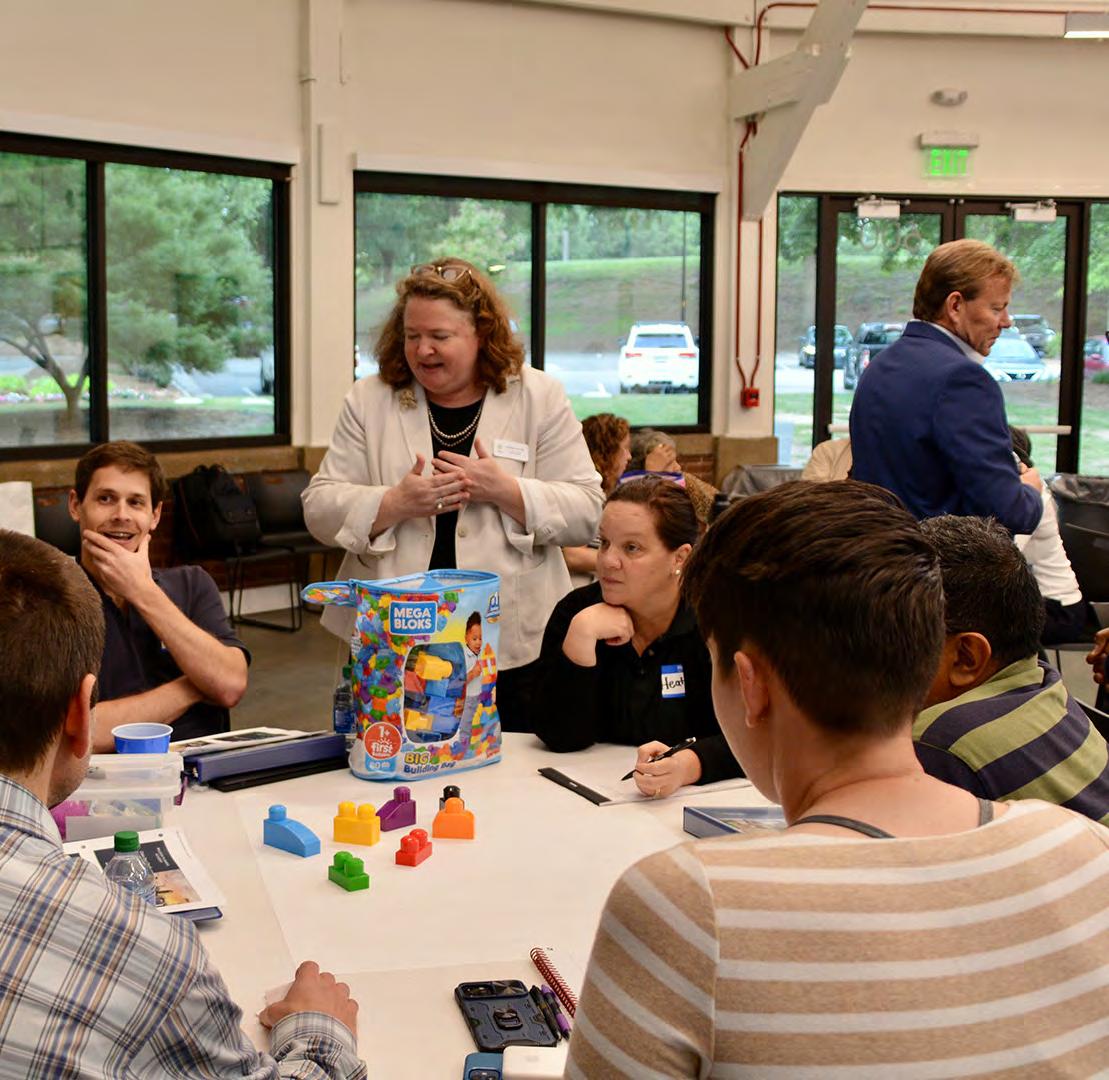
Raleigh Parks is embarking on its CAPRA accreditation process, which requires a great deal of self-reflection. This process has surfaced many challenges and opportunities for Raleigh Parks. To continue evolving its high-quality system and deliver on its mission and potential, Raleigh Parks must support and empower staff to create innovative and beloved programs and places. This means embracing differences and investing in partnerships and practices that are safe, healthy, and supportive for everyone.
To achieve an equitable and accessible parks system, it is important to create a culture of innovation, creativity, and teamwork. This culture should be present at every level of the organization and should be sustainable.
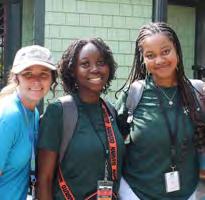

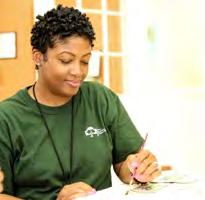
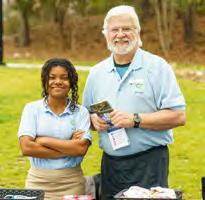
Innovation should be encouraged in all employees. This is especially needed to recruit the younger generation of workforce. It can also help support workforce retention to ensure a diverse, fair, and inclusive workforce that represents Raleigh’s community. A more representative workforce can bring new ideas and help more effectively serve residents.
There are four organizational health outcomes that identify how Raleigh Parks is investing in its staff to support a better park system and opportunities for the organization to commit to staff as its most valuable asset.
Support
Difference embraced and invested in, in all of its forms
Cultivate
A workforce representative of the community
Innovate
A culture of innovation, creativity, and collaboration
Empower
A model parks and recreation agency committed to equity and effectiveness
ORGANIZATIONAL COMMITMENT Support
ENGAGEMENT FEEDBACK
Staff have noted recent challenges with recruitment, onboarding, and training.
-Recreation Programming Focus Group Participants

Difference
embraced and invested in, in all of its forms
Diversity, equity, and inclusion (DEI) programs are a common way of promoting and institutionalizing the practice of embracing difference at park and recreation agencies. NRPA notes that forty-two percent of park and recreation agencies currently have formal DEI programs, and another twenty-two percent of park and recreation leaders anticipate that their agencies will establish formal DEI activities within the next year.16 The City of Raleigh’s Department of Equity and Inclusion offers many resources and is a key partner for the department and its staff dedicated to DEI work.
Raleigh Parks is working to recognize and support the diversity of its workforce in many ways that also help support the community it serves. For example, mandatory unconscious bias training is a common practice and helps improve communication and collaboration across many kinds of difference. Raleigh Parks
16 Diversity, Equity, and Inclusion in Parks Report, National Recreation and Park Association, 2023.
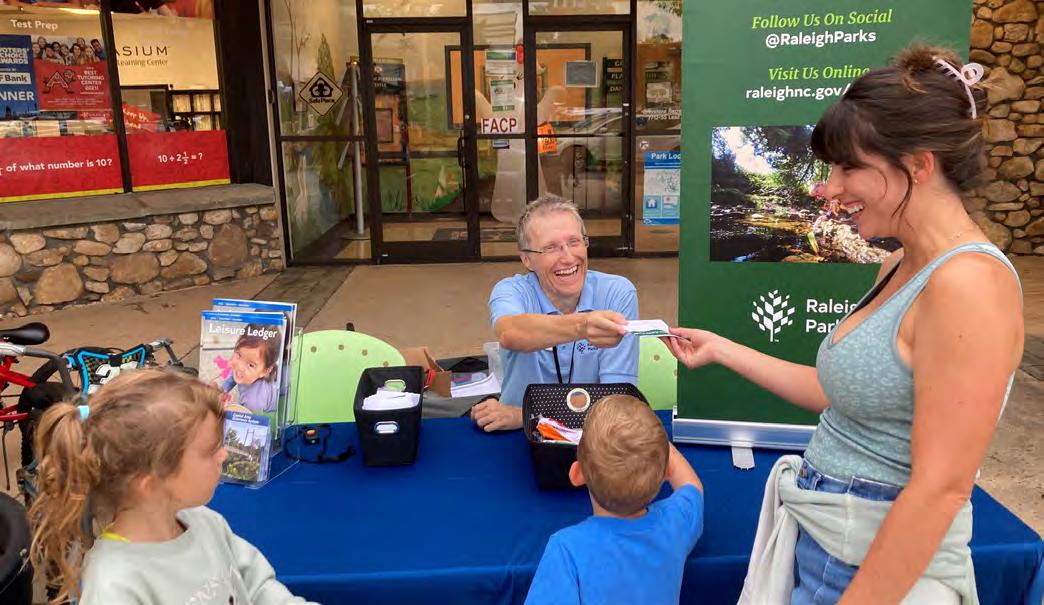
can also broaden recruitment outreach to attract more diversified talent while also providing more connection to often under-represented populations in the city.
There are many potential ways the department can honor the needs of a diverse workforce. Expanding access to alternative work arrangements can support staff with varying capacities and lifestyles. Investing in staff mentorship offers additional opportunities for supporting staff career growth. An interdepartmental effort that includes Raleigh Parks is finding success in encouraging affinity groups, where team members with shared interests can gather and learn from each other’s experiences. Lastly, many agencies are testing higher levels of transparency about strategic decision-making, giving employees context around and agency in the business of parks.
Expanding beyond traditional DEI approaches can help identify new ways of embracing difference. Trauma-informed care is an
approach that assumes an individual is more likely than not to have a history of trauma.15 It recognizes the presence of trauma symptoms and acknowledges the role trauma may play in an individual’s life. Embracing a traumainformed care approach to building partnerships and engagement can create a healthier and sustainable parks system for both staff and patrons.
Relevant Achievement
Engagement with staff throughout the Parks Plan Update process brought fruitful conversations and feedback that actively drove plan decisions.
Current Challenge
According to the NRPA, lack of funding for pay equity and workforce development is the greatest challenge to cultivating a diverse workforce.
15 What is Trauma-Informed Care?, Buffalo Center for Social Research, 2024.
ORGANIZATIONAL COMMITMENT
Cultivate
ENGAGEMENT FEEDBACK
“Raleigh Parks hires so many competent part-time staff, though many face limitations such as not being able to take part in larger department committees.”
- Focused conversation participant
A workforce representative of the community
Investing in a workforce that is representative of the community is important to effectively serving a community. The 2020 Census reported that one in six Americans are over the age of sixty-five, leading to predicted rising rates of employees retiring. This major shift in the workforce presents a unique opportunity to evaluate and evolve recruiting, hiring, and retention goals and practices.
For Raleigh, a diverse, equitable, and inclusive workforce can be achieved through a number of policies and programs. Raleigh already engages in creative recruitment pathways, such as job fairs and university career pipelines, including:
• Historically Black Colleges and Universities (HBCUs)
• Community colleges network
• NC Career and Technical Education Program
• ApprenticeshipNC
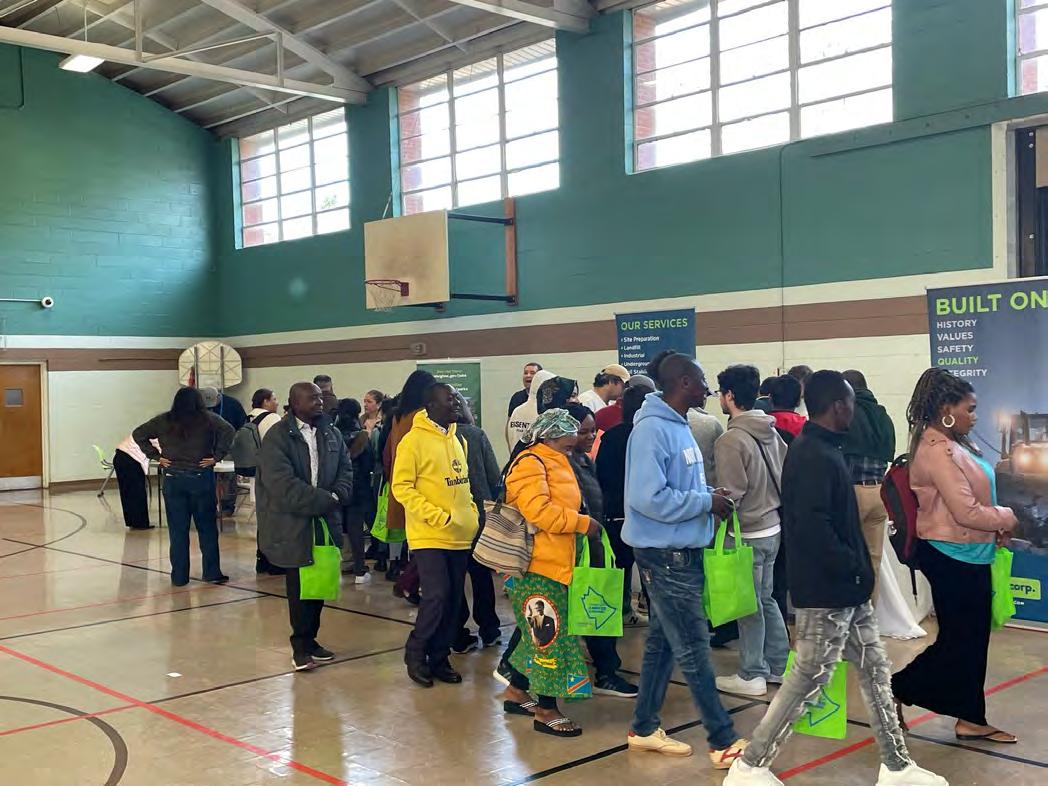
Moreover, Raleigh can continue to routinely evaluate job responsibilities and pay structure to help recruit and retain seasonal and part-time staff. Including the Parks Plan Update in all new hire orientations can expand the reach of this document and its role as a tool for staff to enable change within the organization. As highlighted in the Strategic Business Plan, continuing the Leadership Development Academy will help facilitate employee growth through relationship building, training, and mentorship. Additionally, Raleigh Parks can increase formalized networking opportunities within the department, such as young professionals or lunch and learn series.
Relevant Achievement
Raleigh Counselor In Training camp prepares teens for positions as Junior Counselors through training, hands-on experience, and networking.
Current Challenge
Staff have noted the difficulty that many part-time and seasonal staff face when it comes to transitioning to full-time positions.
ENGAGEMENT FEEDBACK
“There’s currently a gap in programming for teens and young adults (19-25) which could be an opportunity for new and innovative programming!” - Focused conversation participant

A culture of innovation, creativity, and collaboration
It is the responsibility of a parks and recreation agency to foster a culture of innovation, creativity, and collaboration for its residents and visitors. However, a culture of innovation and creativity is often overlooked internally. Organizational innovation fosters a culture that encourages new ideas and allows for implementing these ideas despite challenges, resistance, risk, and other outside factors. For parks and recreation agencies, this innovation can translate to successful programs, new revenue, cost savings, and streamlined efforts.
Innovative methods are needed to keep up with changing communities. During the Parks Plan Update process, staff conversations noted on multiple occasions that changing demographics in the community requires more innovative methods, such as multi-language materials or using technology, such as social media, in new ways to reach these groups. Raleigh Parks’ Marketing Ambassadors program used GIS as a tool to intentionally reach every subsection of the city, ultimately engaging over 26,000 community members.
Raleigh Parks can foster innovation by seeing innovation as a solution. They should continue the Raleigh Parks Shares Program, where staff come together to share working creative projects and initiatives. They can also continue to collaborate with other departments to implement innovative work that spans departmental missions. This includes ongoing efforts like the tree canopy studies, invasive species management, wildlife and pollinator program, community gardens, alternative fuels, and fleet electrification. In addition, Raleigh can participate in the development and adoption of a citywide public private partnership (P3) policy, which will provide a framework for negotiating, executing, and implementing partnership agreements with private sector partners.
Finally, Raleigh Parks is working to identify ways of better measuring who it is serving and how its spaces are being used. Embracing a culture of trial and error and public satisfaction measures,
rather than evaluating success with conventional metrics like profit and user participation figures, can support these efforts. For example, mini-polls online or intercept surveys in parks could be used to get a quick snapshot of community concerns such as public safety and cultural programming awareness, both identified as challenges during community engagement.
Relevant Achievement
Raleigh Parks participated in several episodes of the City’s “Big Ideas Raleigh” podcast, using the new platform to share about its work to a wider audience.
Current Challenge
Innovative tools like artificial intelligence, advanced data analytics, and smart technology can be applied to departmental workflows but require new skills, training, and time.
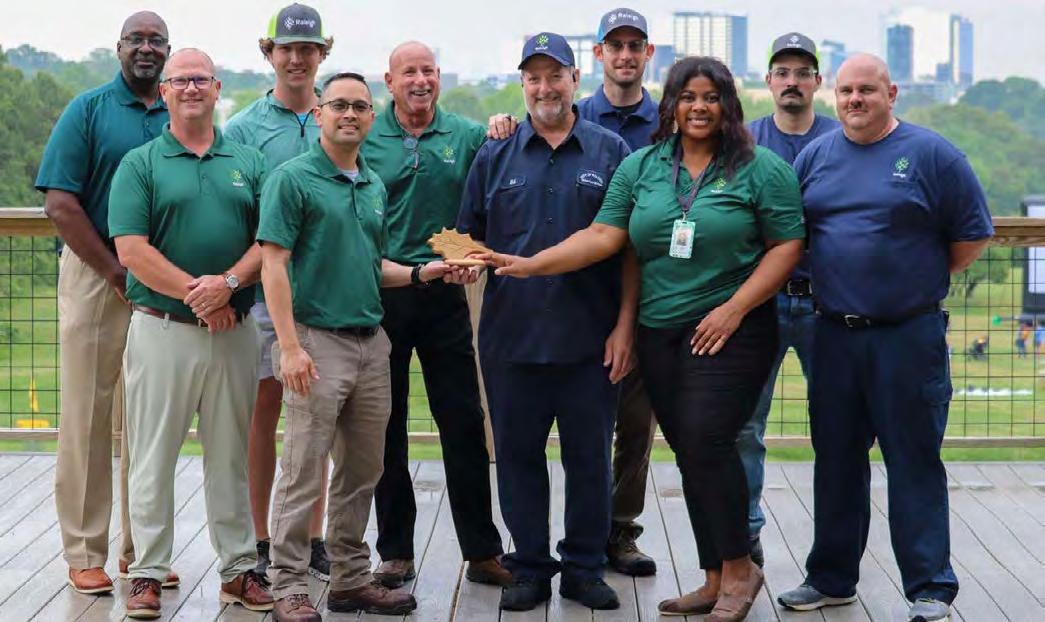
ORGANIZATIONAL COMMITMENT
Empower
ENGAGEMENT FEEDBACK
“We tend to be risk averse. We don’t look to take chances even if the failure will lead to learning opportunities.”
- Focused conversation participant
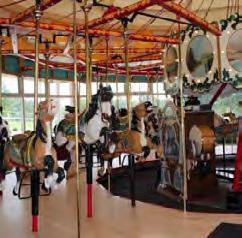
A model parks and recreation agency committed to equity and effectiveness
As evidenced by voter support of the 2022 Parks Bond referendum, there is great enthusiasm for the work that Raleigh Parks provides to the community. However, not willing to become complacent, the department continues to push for broader and more inclusive impact through its continually evolving offerings. The focus on health as the strategic driver for future change, for instance, embodies this commitment to innovation and leadership in the realm of equity.
Raleigh Parks can continue to work to achieve equity and effectiveness through various strategies. Firstly, Raleigh Parks should continue to pursue CAPRA accreditation to ensure the department meets the highest standards within the profession. They can also continue to evaluate existing programs based on demographics, participation, and community needs to tailor their programs and events. Workflows can be
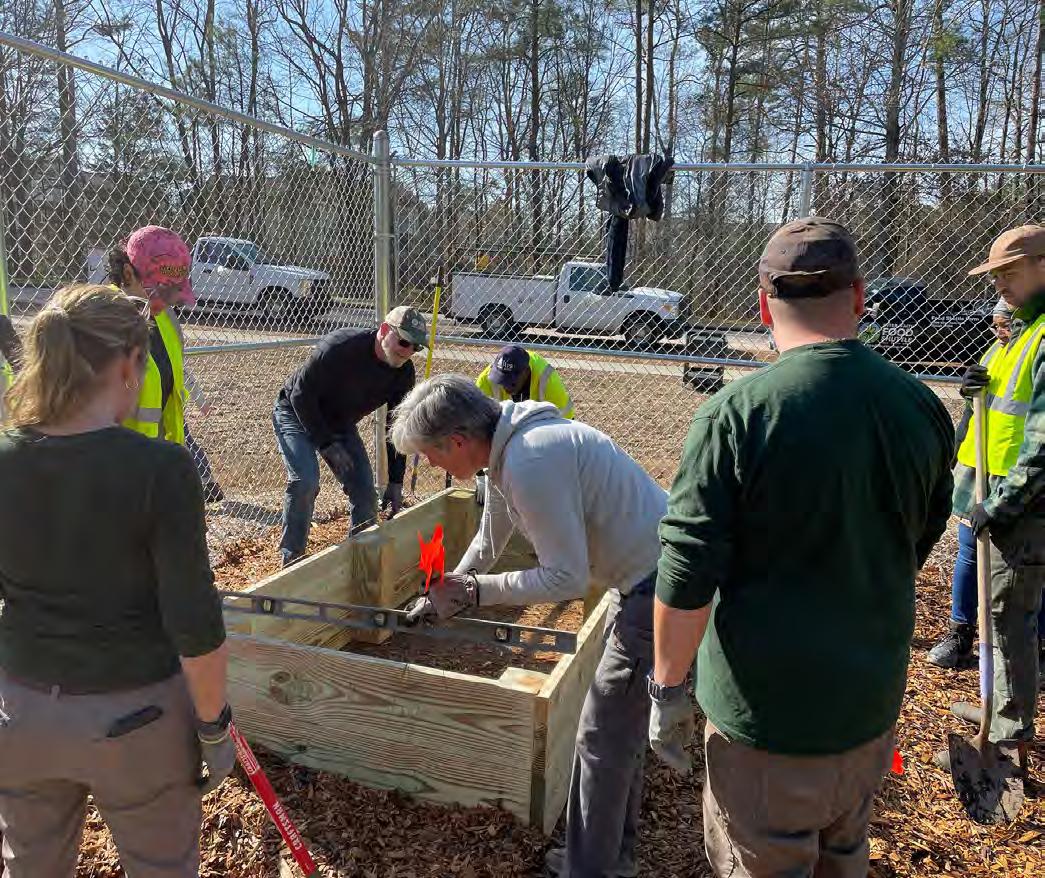
Relevant Achievement
developed that incorporate Parks Plan outcomes into key job responsibilities. Finally, as highlighted in the Strategic Business Plan, development of an equitable investment framework will help Raleigh target investments in parts of the city that will have the largest impact.
Raleigh Parks participated in the City’s “Big Ideas Raleigh” podcast, using the new platform to share about its work to a wider audience.
Current Challenge
Innovative tools like artificial intelligence, advanced data analytics, and smart technology can be applied to departmental workflows but require new skills, training, and time.

System Plan Deep Dive
REACH FOR THE
STARS!
NRPA’s CAPRA is a prestigious national accreditation program that evaluates and recognizes the quality of operation, management, and service provided by park and recreation agencies in the United States. Currently, there are 206 accredited park and recreation agencies in the United States, each committed to providing exceptional services to their communities.
The advantages of achieving CAPRA accreditation include:
• Accreditation recognizes an agency’s commitment to excellence and to industry norms.
• CAPRA ensures that accredited agencies meet national standards of best practice.
• By achieving CAPRA accreditation, an agency demonstrates its dedication to providing the highest level of service to the community.
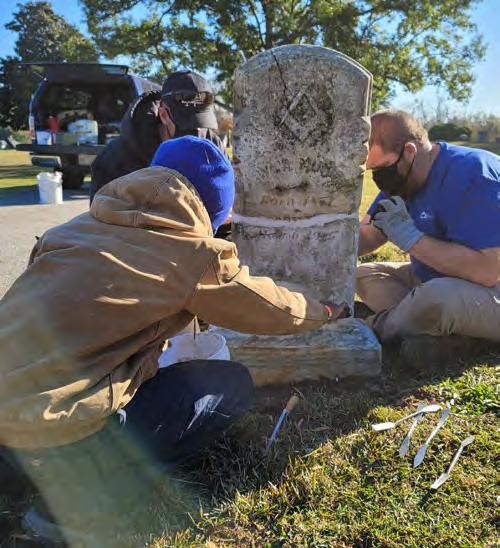
ACCREDITATION PROCESS
Throughout the Parks Plan Update process, plans and policies that related directly to CAPRA were evaluated. The planning team identified best practices and shared opportunities for this plan to directly support Raleigh Parks’ own path to accreditation. The accreditation process involved a comprehensive self-evaluation that each agency is required to complete. This selfevaluation requires agencies to identify their evidence and documentation for compliance. Subject Matter Experts acted as advisors to share best practices or approaches for submittal.
BENEFITS
There are many benefits to achieving CAPRA accreditation, including:
• Accreditation holds the agency accountable to the public. It ensures responsiveness to community needs and promotes transparency.
• Engaging all staff in the accreditation process enhances teamwork and pride.
• CAPRA becomes an integral part of the agency’s internal culture, fostering a continuous improvement mindset.
• Decision-makers, stakeholders, and the public recognize that the agency operates with the best practices of the profession.
• Increased credibility can lead to improved internal and external funding.
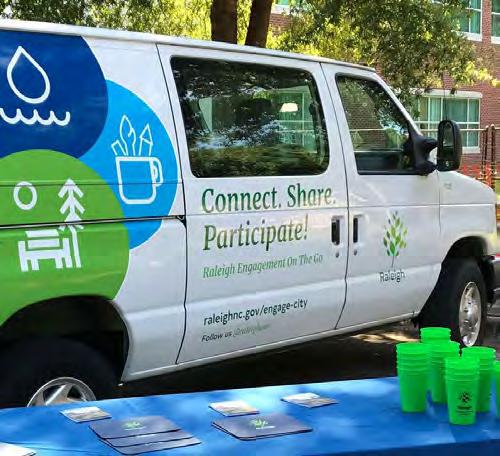
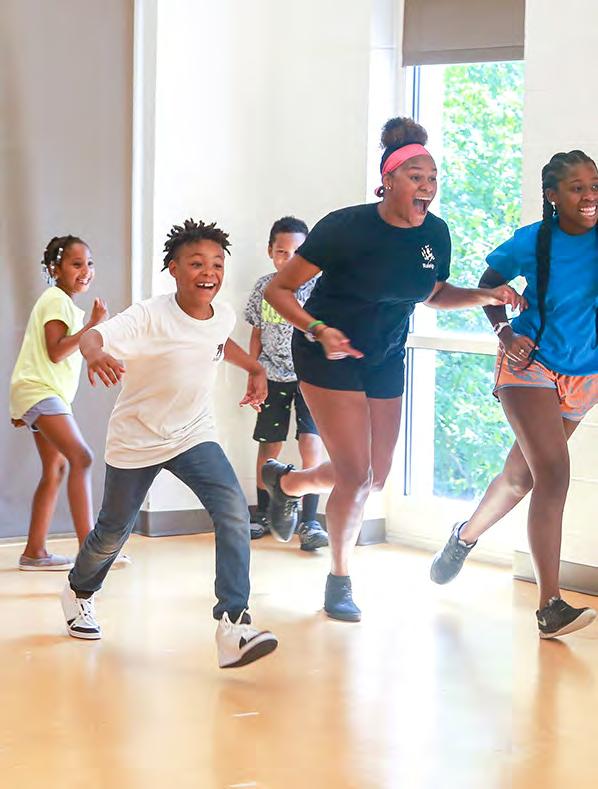
CHAPTER 5 IMPLEMENTATION PLAN UPDATE
Achieving Desired Health Outcomes
The implementation chapter frames a process for creating potential actions to help achieve desired outcomes.
The implementation roadmap for this Parks Plan Update is a crucial element that transforms the vision, guiding principles, and health outcomes into tangible realities. This chapter identifies the framework for priority department-led actions necessary to realize an inclusive and accessible park system that reflects the diverse needs and aspirations of both staff and community but also enables staff leadership and experience to guide future decision-making. The roadmap prioritizes the voices and experiences of historically marginalized groups, ensuring that all community members can benefit from safe, welcoming, and vibrant public spaces and
experiences. The implementation roadmap includes evaluation and refinement of Levelof-Service, the creation of an equity matrix and efforts to accelerate equitable change.
Importantly, this Plan will guide Raleigh Parks’ investments and allocation of resources and capacity over the next five to ten years. Development of this implementation roadmap involved workshops with Raleigh Parks leadership as well as staff. This included their perspectives on the status and priorities of the action items from the 2014 Parks System Plan, which were evaluated in Fall 2023, and staff and community project, policy, and program ideas shared in Spring 2024. This process resulted in an implementation matrix that outlines the projects, policies, and programs that can guide decisionmaking and action toward the desired health outcomes.
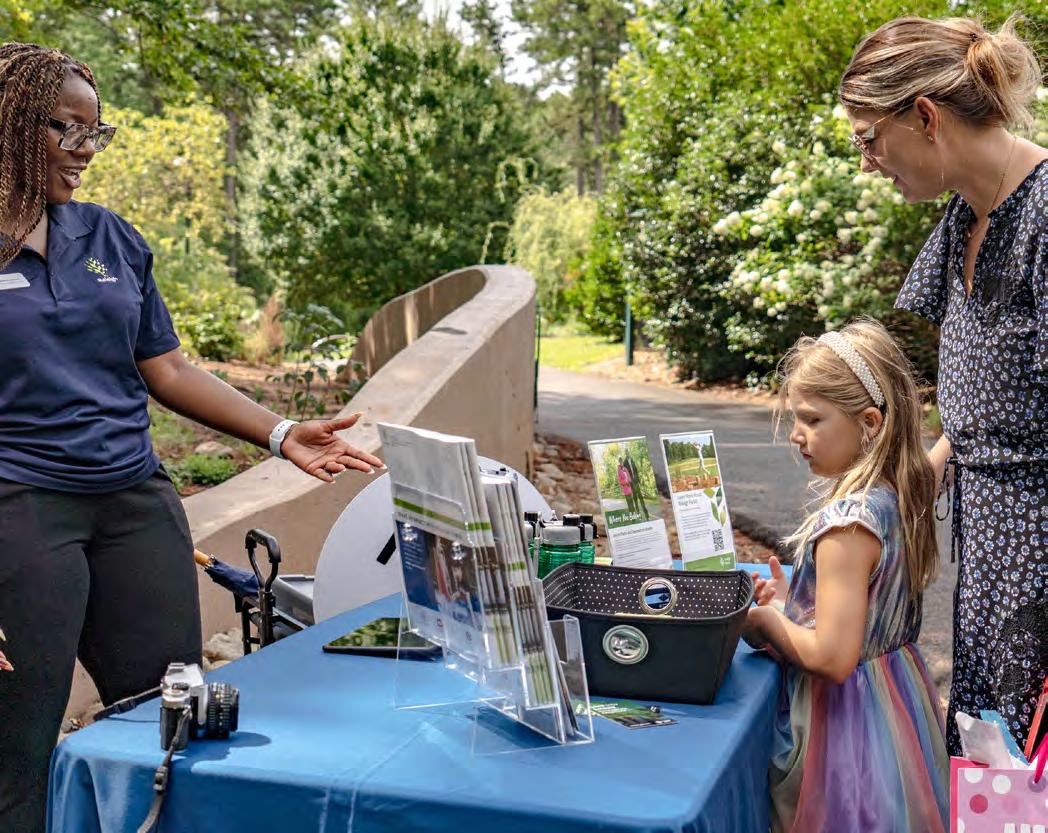
Reshaping Equitable Access
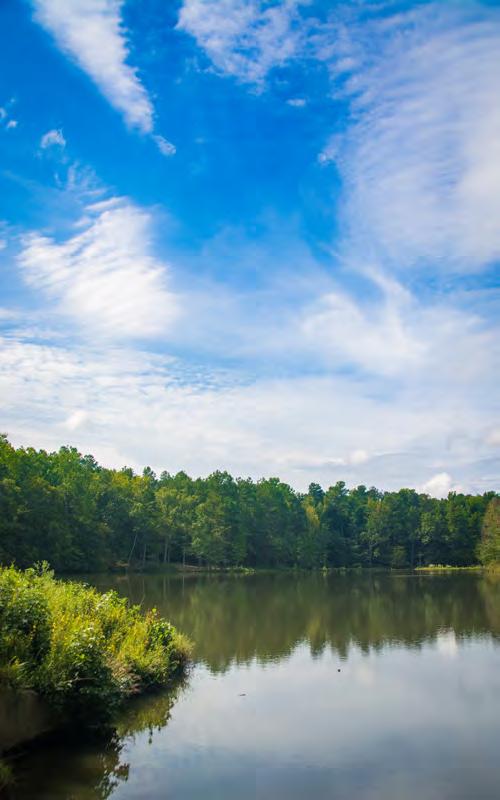
Raleigh Parks is committed to establishing an equitable community for all. Achieving equity in Raleigh means dismantling policies and systems that have disproportionately impacted Black, Indigenous, and People of Color (BIPOC) community members and advancing policies that target historic inequities and result in improved quality of life across the City. Due to a history of racially discriminatory practices in parks, planning, and development, these inequities continue to exist within public parks and recreation, and as a result, not all people have fair and just access to parks, trails, community centers, and programs that would otherwise contribute to their ability to live healthy lives.
Just as Raleigh Parks has used equity considerations to guide decision-making and capital investments in recent years, the Raleigh Parks System Plan Update is centered on equity to guide future decisions. The Parks Plan Update planning process occurred alongside a parallel process where the Trust for Public Land evaluated and identified opportunities for Raleigh Parks to update Raleigh’s existing approach to Level-ofService, as part of Raleigh Parks’ participation in the Park Equity Accelerator cohort. Raleigh Parks is developing an equity matrix to identify community need and refine its approach to modeling park access. This will help identify park supply that can better achieve Raleigh’s mission of Bringing people to parks, and parks to people.
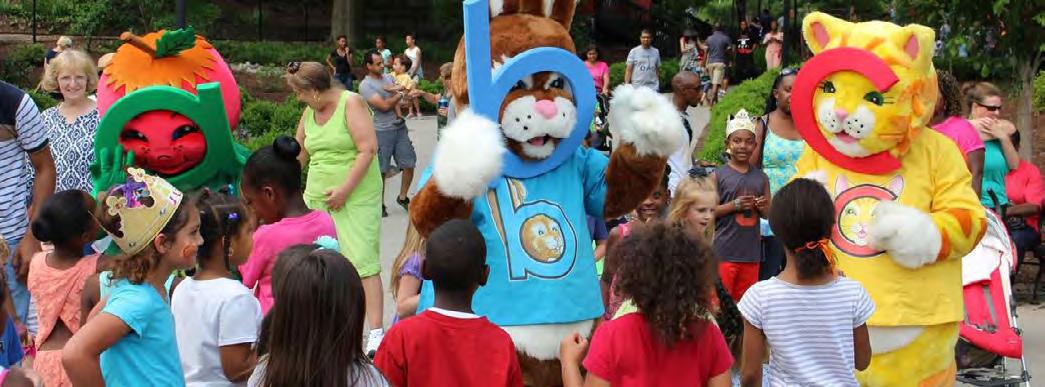
EQUITY MATRIX: UNDERSTANDING COMMUNITY NEEDS
The following metrics are being considered for the equity matrix, which will help Raleigh identify a broader spectrum of community needs. Much of this data is already collected by the City.
• Population Density: High population density areas may have greater demand for park space and facilities because many of these households have limited to no access to a private open space or are sharing resources across more households.
• Race & Ethnicity: Understanding the racial and ethnic composition of neighborhoods helps identify historically marginalized communities that may have been underserved by parks and recreational facilities.
• Poverty: Areas with higher poverty rates often lack sufficient recreational resources and have more barriers to accessing programs that have costs.
• Age Dependency: Communities with high proportions of dependents (children and elderly) require specific park amenities and programs and especially benefit from walkable access to park spaces.
• Language Isolation/Limited English Proficiency (LEP): Identifying areas with high LEP populations ensures that park programming and communication strategies are inclusive and accessible to non-English speakers.
• Heat Risk and Tree Canopy: Areas with high surface temperatures and low tree canopy cover are at greater risk of heat-related health issues. Prioritizing these areas for green spaces can mitigate heat risks and improve public health.
• Impaired Watersheds: Parks and greenways in areas with impaired watersheds can play a role in improving water quality and providing environmental education.
• Poor Mental Health: Access to parks and green spaces is linked to better mental health. Identifying areas with poor mental health statistics can guide the targeted development of parks to provide therapeutic and stress-relieving benefits.
• Poor Physical Health: Communities with high rates of physical health issues benefit from increased access to recreational facilities that promote physical activity and other health-supporting behaviors and services.
• Historic Spending in Raleigh Parks: Analyzing past spending patterns helps identify disparities in investment. This ensures future funding is allocated more equitably, addressing neglected areas and improving overall park equity.
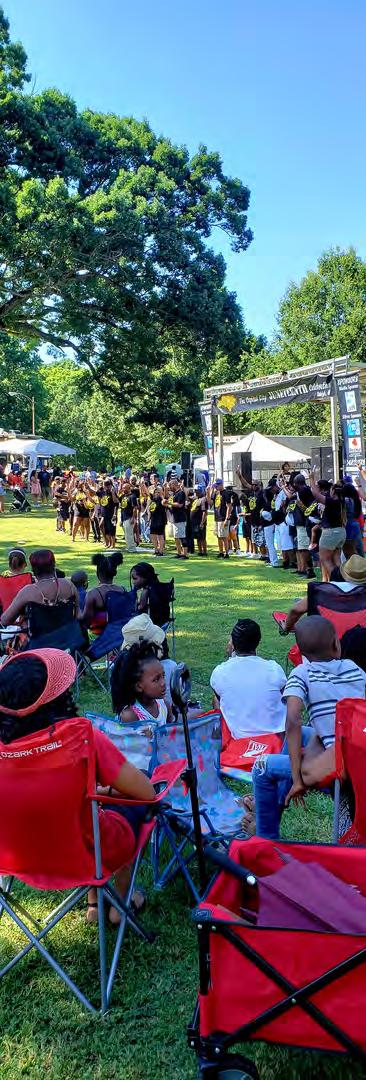
System Plan Deep Dive
ACCELERATING
PARK EQUITY
Raleigh is continuing to grow and expand as a city, and there are opportunities to improve access to green spaces in new developments that are continuing to be built. Policies are a critical tool in helping to shape the City and development within it. Raleigh Parks is working to develop policies focused on building partnerships with residential and commercial developers that will help advance the goal of increasing tenminute walk access to the core experiences.
PARK EQUITY ACCELERATOR BIG
IDEAS
The Park Equity Accelerator resulted in a set of policy recommendations that Raleigh Parks can use to support expanded park equity.
Privately-owned parks can serve an important role in meeting the needs of residents. To better understand where these privately-owned parks exist and how they are maintained, Raleigh Parks can create a new policy that would require developers to transfer information about privately-developed parks to them. When privately-developed amenities are meeting needs in one location, public investment can be focused in other locations where needs are higher and private amenities are not available. #1
Growing Successful Neighborhoods and Communities
Private Parks Development
Improving Park and Greenway Access
Raleigh’s Comprehensive Plan outlines a policy for including public spaces in private developments. These public spaces can connect to and benefit from being close to public amenities and spaces such as greenway trails, public sidewalks, and plazas. Raleigh Parks worked to require new residential developments to construct connections to existing greenway trails.
Managing Growth Budget Adequacy
An existing policy of Raleigh’s Comprehensive Plan outlines that the city budget that supports the parks system should keep pace with growth. As a key part of this, it should also provide the quantity and quality of programs, facilities, and facilities maintenance expected by residents. Raleigh Parks continues to evolve its approach to making capital improvements that are equity-driven.
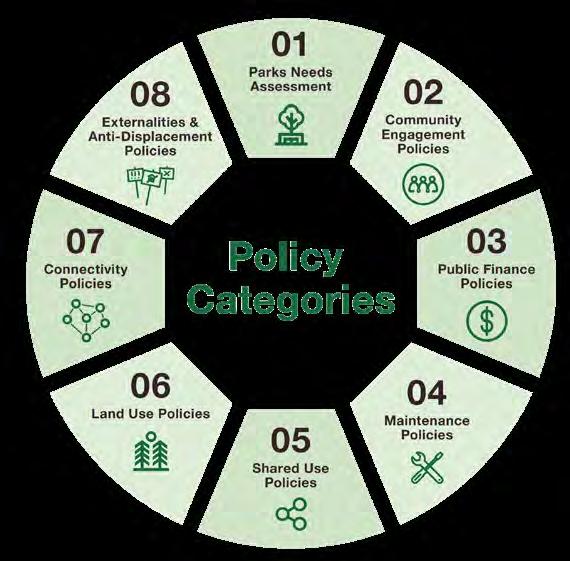
Sustainable Development Planning for Proximity
Raleigh’s Comprehensive Plan outlines a policy for providing new parks and facilities so that every resident has access to a core experience within a ten-minute walk of their home or place of employment. To make this policy stronger, an additional policy could be created that requires residential and commercial development to support this goal. This policy could be based on models of park-oriented development. Park-oriented development is a strategy that makes trade-offs with developers, such as allowing them to build more units, so that they may build their developments close to parks or create new open spaces that are publicly accessible and that increase park access.
Publicly Accessible Parks
Raleigh’s Comprehensive Plan highlights different tools that the city can use to create publicly accessible open spaces in new developments. Using zoning incentives is one of these tools. Zoning incentives allow developers to add extra units or square footage to their development in exchange for the development providing certain public benefits. These public benefits can be new open spaces or new walkable connections to nearby parks and greenways. Raleigh Parks is working to explore other types of zoning incentives and public-private partnerships that will help encourage creating public spaces during the development process.
Outcome-Driven Implementation
The Parks Plan Update provides a flexible roadmap to guide the Raleigh Parks Department toward achieving its health goals.
Unlike the 2014 Parks System Plan, this update does not include a comprehensive, prescriptive list of tasks. Instead, it empowers Raleigh staff and stakeholders to
determine specific actions and track progress in ways that adapt to changing needs and opportunities over time.
This flexible approach outlines the plan’s goals but allows creativity in choosing the best methods to reach them. It is like identifying the finish line but not specifying exactly how to run the race.
The following implementation plan matrix identifies priority projects, policies, and programs, which are specific tasks or steps that are identified as essential to achieving one or more of the four health lenses within the plan’s five to ten year timeframe. For each of the priority projects, policies, and programs, the matrix also communicates the following:
• The priority project, policy, or program.
• Guiding Principles: Alignment with the Parks Plan Update guiding principles.
• Desired Health Outcomes: Identification of alignment of the projects, policies, and programs with the health outcomes.
Policies, Programs & Projects
Alignment with the Guiding Principles
Desired Health Outcome
IMPLEMENTATION PLAN MATRIX
LEADING HEALTH LENSES PPPs RECOMMENDATIONS
Policies
INDIVIDUAL WELLBEING
Programs
Expand inclusive policies to support a full spectrum of users, including people who are neurodivergent, have visual impairments, physical disabilities, or language isolation.
Remove barriers for teen participation in programs and access to facilities.
Leverage partnerships and internal capacity to increase the number of free activities, programs, and events.
Strengthen Financial Assistance programs and funding to reduce barriers for households to participate in programs.
Identify mental health “hubs” - or distributed clusters of resources - throughout city, expanding the pilot mental health programming already provided at Dix Park.
Expand active adult program offerings and craft a marketing strategy to more effectively reach seniors who are unaware of program availability.
Expand drop-in and open play availability, especially for athletics or sports-related uses.
Create programs along greenway trails that better activate the greenway trails. Programs could include history-, nature-, or art-themes events that align with the Public Art Plan.
Expand shade citywide (trees/constructed shade) through the Street Tree Equity Project and through parks and facilities reinvestment projects.
Projects
Expand offerings for wheeled resources for all ages. This could include all-ages recreation and education facilities like skate parks, Traffic Gardens, pump tracks, natural surface trails for mountain biking, and bike repair stations.
Strive for building amenities beyond ADA-accessibility and universal design.
GUIDING PRINCIPLE ALIGNMENT
DRIVING OUTCOMES
INDIVIDUAL WELLBEING OUTCOMES
Physical Wellbeing
Access to play, exercise, and a healthy lifestyle
Inclusion & Relevance
Mental Wellbeing
Inclusion & Relevance
Inclusion & Relevance
Mental Wellbeing
Inclusion & Relevance
Physical Wellbeing
Physical Wellbeing
Mental Wellbeing
Mental Wellbeing
The ability to pursue emotional, psychological, and social wellbeing
Inclusion & Relevance
Reduced barriers and something for everybody
Physical Wellbeing
Inclusion & Relevance
EIGHT GUIDING PRINCIPLES
Connectivity and Access
Equity and Justice
Continuous Reinvestment
Collaboration and Coordination
Creativity and Innovation
Community and Belonging
Culture and History
Resilience and Stewardship
LEADING HEALTH LENSES PPPs RECOMMENDATIONS
Integrate arts and culture in projects and programs.
Policies
Revisit policies for volunteer work to strengthen and expand volunteerism and community park stewardship.
Partner across departments to identify and establish policies that incentivize the creation of publicly accessible parks and greenways as part of the land development process.
Partner to provide assistance to unhoused community members and persons experiencing mental health crises.
Translate Raleigh Planning Academy to a Raleigh Parksspecific program that encourages community and department dialogue.
Programs
COMMUNITY COHESION
Projects
Expand community gardens, especially in neighborhoods with mixed use or high-density zoning or a food desert.
Expand the Welcome to Raleigh Parks program, providing a landing resource for newcomers to the city.
Provide revenue-generating services along greenways like food trucks and events that engage small and minority businesses.
Expand the Neighborhood & Community Connections Program through capital improvement as well as publicprivate partnerships.
Pilot marketing and communications programs with various workgroups to increase and inform relationships with the Raleigh community, especially those who do not participate in programs today.
Enhance design and programming to activate the greenway and ensure it is welcoming to all visitors.
Implement the next phases of the Dix Park Master Plan, and prioritize build-out of parks with multi-phase master plans.
Collaborate with other city departments and promote and incorporate greenway trails to support multimodal, active transportation.
GUIDING PRINCIPLE ALIGNMENT DRIVING OUTCOMES
Belonging
Relationships
Development
COMMUNITY COHESION OUTCOMES
Belonging
A sense of community identity and belonging
Relationships
Strong relationships with communities
Development
Relationships
Balanced growth and a robust local economy
Connectivity
Connections between people, places, and communities
Relationships
Belonging
Belonging
Development
Connectivity
Relationships
Connectivity
Development
Connectivity
EIGHT
GUIDING PRINCIPLES
Connectivity and Access
Equity and Justice
Continuous Reinvestment
Collaboration and Coordination
Creativity and Innovation
Community and Belonging
Culture and History
Resilience and Stewardship
LEADING HEALTH LENSES PPPs RECOMMENDATIONS
Use existing or create a new Raleigh Parks green building standard for all capital improvement projects and develop guidelines for eco-friendly operations in all facilities.
Policies
ENVIRONMENTAL RESILIENCE
Programs
Minimize environmental impacts, including to animal and plant habitats, for development and maintenance projects. Consider the tradeoffs to requiring the use of adaptive planting.
Increase use of Protected Natural Area designation (or create new designation/definition) to support consideration of sensitive species and habitats in planning and design.
Strengthen invasive species removal, especially in riparian corridors and in natural areas and parks with significant natural resources.
Expand environmental educational programs that provide climate change and sustainability curricula for youth and adults.
Expand natural areas and connected wildlife corridors through investments in existing Raleigh Parks properties, easements, and land acquisition opportunities.
Pilot green stormwater infrastructure (GSI) in parks with community centers and tie programming to those GSI investments.
Projects
Increase and actively steward Raleigh’s urban tree canopy through a combination of city-led efforts on public land as well as partnerships with community groups and private property owners.
Develop a City of Raleigh Natural Resources Strategic Plan that aligns with both the Comprehensive Plan and the Parks Plan Update and reflects external input.
GUIDING PRINCIPLE ALIGNMENT DRIVING OUTCOMES
Sites & Facilities
Sites & Facilities
Protection
Protection
Stewardship
Ecology
Sites & Facilities
Stewardship
Ecology
ENVIRONMENTAL RESILIENCE OUTCOMES
Ecology
A sustainable, resilient, citywide ecological framework
Sites & Facilities
Best design, management, and operational practices in all sites and facilities
Stewardship
A community of active and passionate stewards
Protection
Sensitive habitats and corridors are protected
EIGHT GUIDING PRINCIPLES
Connectivity and Access
Equity and Justice
Continuous Reinvestment
Collaboration and Coordination
Creativity and Innovation
Community and Belonging
Culture and History
Resilience and Stewardship
LEADING HEALTH LENSES PPPs RECOMMENDATIONS
Prioritize existing operation and maintenance and Capital Improvement reinvestment.
Expand part-time employee inclusion through cross training, committee engagement, and initiatives.
Policies
Collaborate with staff to update the Department's values using the Parks Plan Update as a guide.
Update Raleigh Parks' code of ethics.
ORGANIZATIONAL COMMITMENT
Programs
Projects
Create staff wellbeing programs for year-round support.
Expand sponsorship, partnership, and philanthropy opportunities, and fortify the department’s reputation so that Raleigh Parks is a partner of choice for external agencies.
Achieve national accreditation (CAPRA) by upholding high standards in staff performance, customer service, and overall departmental excellence.
Implement the Raleigh Parks Programming Assessment.
Develop a process for using data to drive equitable budgeting for capital investment in Raleigh parks.
GUIDING PRINCIPLE ALIGNMENT DRIVING OUTCOMES
Innovate
Cultivate
Support
Empower
Support Empower
Innovate Empower
Innovate
ORGANIZATIONAL COMMITMENT OUTCOMES
Support
Difference embraced and invested in, in all its forms
Cultivate
A workforce representative of the community
Innovate
A culture of innovation, creativity, and collaboration
Empower
A model parks and recreation agency committed to equity and effectiveness
EIGHT GUIDING PRINCIPLES
Connectivity and Access
Equity and Justice
Continuous Reinvestment
Collaboration and Coordination
Creativity and Innovation
Community and Belonging
Culture and History
Resilience and Stewardship
Summary of Implementation
Together, the vision, guiding principles, updated equity and Level-of-Service standards, desired health outcomes and implementation matrix of policies, programs, and projects provide a comprehensive roadmap for both strategic and tactical actions moving forward. The relationship between the various studies, tools and actions of the roadmap can be described as follows:
• Start! - Begin with a benchmark of the current system.
• Invest! - Allow the implementation roadmap to guide budget planning, prioritize resource investment and strategize program offerings.
• Monitor! - Use analytics of both updated equity and Level-of-Service standards to review progress regularly and serve as system-wide performance measurement over time, particularly at the end of the decade or before the next generation of Raleigh Parks System Plans.
• Focus! - Utilize the Level-of-Service standards primarily for asset development and the equity analysis for both programming and capital improvement planning.
As described in this document, implementation will happen over the next five to ten years. Consistent with an outcome-driven approach, the paths to implementation are intentionally flexible and adaptable to future changes, including both foreseeable shifts such as the continued impacts of climate change and those that cannot be imagined today. The flexibility in implementation strategies also empowers Raleigh Parks staff to exercise innovation and creativity in their contribution to a successful parks system.
The development of this approach aligns with both community feedback and input from Raleigh Parks’ staff throughout the planning process. With a stronger focus on desired health outcomes, Raleigh Parks can continue to provide the exceptional and diverse experiences today’s users benefit from while growing its impact for future generations.
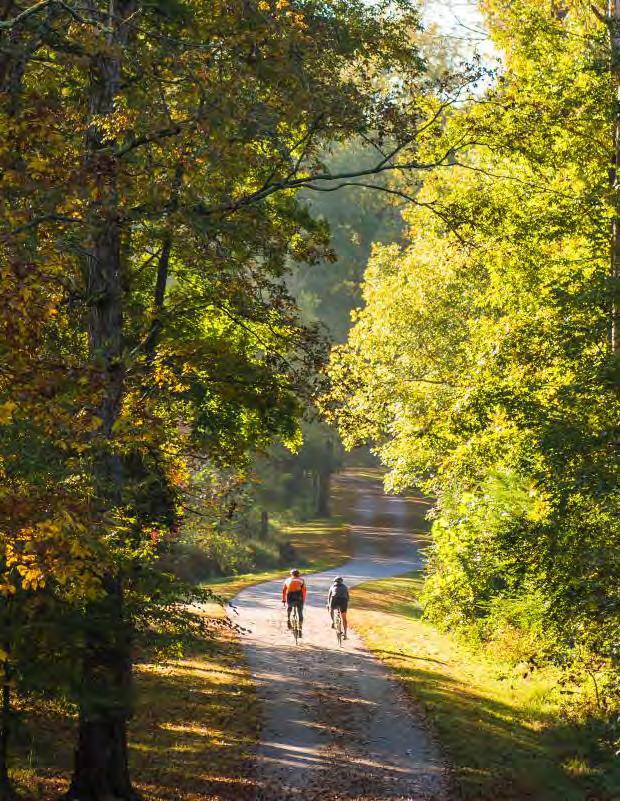
Glossary of Terms
GLOSSARY OF TERMS
Access - The proximity of a park, greenway trail, nature preserve, or recreation facility to the public with safe means of getting there (walking, biking, transit, or driving). Equitable access is typically defined as a ten-minute walk or 5-minute drive to a park or facility, depending on the type of park or facility. (Refer to Trust for Public Land’s ParkScore)
Accessibility - Usable by people with the widest possible range of abilities, operating within the widest possible range of spaces. See also, Universal Design.
Active Transportation - Any form of humanpowered transportation, such as walking, bicycling, using a wheelchair/mobility device (wheeling), or skating.
Active Recreation - Activities such as walking, running, bicycling, wheeling, and sports, which promote health and wellbeing by encouraging movement, and physical exercise.
Amenity - An object or offering that contributes to the enjoyment of a space and benefits its location. Within parks and open space, there are generally 4 categories of amenities: active recreation, passive recreation, natural areas, and site amenities. Playgrounds, greenway trails, fields, and sports courts are examples of active recreation. Gathering spaces, gardens, docks, and shade structures are examples of passive recreation. Bird watching and butterfly watching stations, meadows, and stream corridors are examples of natural areas. Benches, bike racks, charging stations, and wi-fi are examples of site amenities.
Bikeways - Any road, path, or facility intended for bicycle travel which designates space for bicyclists distinct from motor vehicle traffic. A bikeway does not include sidewalks, signed routes, or shared lanes with shared lane markings, but does include bicycle boulevards.
Bikeway Network - A network of bikeway facilities along streets and trails (existing and planned), where people feel safe and comfortable riding their bicycles to and from a variety of destinations (BikeRaleigh Plan, 2016).
Bond Referendums - A voting process that gives voters the power to decide if a municipality should be authorized to raise funds through the sale of bonds.
Capital Area Greenway System - A system of trails and open space corridors that is maintained by the City of Raleigh.
Capital Improvement Project - Also called a capital project - is typically a permanent structural change to a park or greenway to prolong its life, increase its value, or enhance its capabilities.
Capital projects can include asset upgrades or large scale maintenance work. Some examples of capital projects include building a new community center, replacing a greenway bridge, or resurfacing tennis courts.
Comprehensive Plan - The City of Raleigh’s longrange policy document adopted and amended by the City Council. The Comprehensive Plan establishes a vision for the City, provides policy guidance for growth and development, and contains action items directed at the City to implement the vision.
Connectivity - The degree to which trails and streets are easily accessible to one another by direct routes.
Conservation - Protection of natural green infrastructure, preserving important environmental and ecological functions and enhancing quality of life.
Easement - An easement is the grant of property rights which authorizes the easement holder permission to use another person’s land for a specific purpose.
Economic Development - The process of local wealth creation, manifested by growth in jobs, income, and investment, and supported by improvements in the social, built, and natural environment (City of Raleigh 2030 Comprehensive Plan Update).
Environmental Education - Environmental education is a process that allows individuals to gain awareness and knowledge about the environment and related issues, engage in problem solving, and take action to improve the environment.
Environmental Protection - Policies and practices intended to ensure clean air, land, and water in order to protect human health and the environment.
Environmental Stewardship - The responsible use and protection of the natural environment through conservation and sustainable practices to enhance ecosystem resilience and human well-being.
Equity - Justice, fair treatment, and opportunity for the advancement of all people while addressing and prioritizing issues for those that have been historically disadvantaged across all systems (housing, education, economics, healthcare, environmental, social and community) (Raleigh Office of Equity and Inclusion, 2020).
Equitable Distribution - The equitable provision of services, investments, infrastructure, etc. These may be geographically allocated, but that is not a primary consideration.
Facility - Refers to physical structures owned, operated, and managed by Raleigh Parks.
Greenway - Park classification for a linear piece of property that lies along a creek or is in a floodplain, local/regional park, nature preserve, recreation center, or other natural area. Some greenways include greenway trails, which are also a critical park of the City’s bicycle & pedestrian network as a source of recreation and active transportation.
Health Equity - Everyone has a fair and just opportunity to be as healthy as possible.
Health Outcome - A change in the health of an individual, group of people, or population that is attributable to an intervention or series of interventions (World Health Organization).
Mobility - The ability to travel safely and unimpeded along single or linked transportation facilities (Connect NCDOT).
Land Acquisition - The process of gaining ownership of land, including the purchase of land, partnerships, gifting, and land leasing.
Level of Service (LOS) - A measure of how well residents in Raleigh are currently served by the city’s system of parks and greenway trails.
Local Parks - Park classification for small to medium sized parks that provide access to open space for residents near their home.
Neighborhood and Community Connections Program (N&CC) - A City of Raleigh program to identify, prioritize, and build new walkable connections to parks and greenways. The N&CC Program promotes health equity throughout the City of Raleigh, using geospatial modeling and data analysis to guide investment to those communities which are most at risk of negative health outcomes and most in need of improved access to public parks and recreation opportunities.
National Recreation and Parks Association (NRPA) - A leading national nonprofit organization founded in 1965whose mission is to advance parks, recreation and environmental conservation efforts that enhance the quality of life for all people.
Nature Preserve - Park classification for areas that can be managed for natural resource conservation and recreation. Nature Preserves protect wildlife habitat, water quality, and endangered species. They can provide opportunities for nature-based, unstructured, low-impact recreational opportunities, such as walking and nature viewing.
Network - A framework of connected routes and corridors within a system.
Open Space - Green space that is not developed and often protected on which development is indefinitely set aside.
Open Space Preservation - The preservation of land that is undeveloped (has no buildings or other built structures).
Partnership - In the context of Raleigh Parks, this term describes joint projects, responsibilities, ownership, and implementation duties between Raleigh Parks and other groups and organizations. Before becoming formal agreements, successful partnerships would articulate clear expectations and outcomes.
Population Density - Number of people per square mile of land (US Census).
Programming - Leisure and recreation events or activities that may or may not require particular amenities. For example, programming can vary from a self-guided walking tour to a fitness class held at a recreation center.
Racial Equity - The condition where race no longer predicts a person’s quality of life and outcomes (Raleigh Office of Equity and Inclusion, 2020).
Reinvestment - Dedication of capital and staffing resources to existing trails, structures, amenities, and corridors.
Riparian Corridor - The area of transition between land features and water features, such as a stream bank, shoreline, or the border of a wetland. Riparian areas are characterized by frequently waterlogged soils and distinct types of vegetation adapted to these soils (City of Raleigh 2030 Comprehensive Plan Update).
Sidepath - A bikeway physically separated from motor vehicle traffic by open space or a barrier and located adjacent and parallel to a roadway. Sidepaths are often within the street right-ofway.
Safety - The degree to which users are free from injury or harm.
Security - The degree to which users are free from the fear and incidence of crime.
Signage - Directional guidance and information about destinations for bicyclists and pedestrians (also called wayfinding).
Social Equity - The condition where social status and demographics no longer predict a person or group’s quality of life and outcomes.
Trail - A marked or established path or route that people can move through and travel along. Trails may be paved or unpaved depending on context and trail purpose (e.g., recreation, active transportation, wildlife observation, etc.).
Trail Network - A network of existing and planned trails that provide opportunities for active transportation and recreation.
Trust for Public Land (TPL) - A national nonprofit founded in 1972 whose mission is to create parks and protect land for people, ensuring healthy, livable communities for generations to come.
Universal Design - The design of facilities, playgrounds, and open spaces to make them accessible to all people, regardless of age, ability, or background.
Under-Resourced - Neighborhoods, facilities, communities, or populations that have not historically received significant investment, lack amenities, and/or services provided to others.
Walkability - The extent to which the built environment supports and encourages walking, by providing for pedestrian comfort and safety and connecting people with various destinations within a reasonable amount of time and effort.
